Evaluating the Impact of Foreign Investment - PDF
VerifiedAdded on 2021/05/30
|43
|11203
|35
AI Summary
Contribute Materials
Your contribution can guide someone’s learning journey. Share your
documents today.
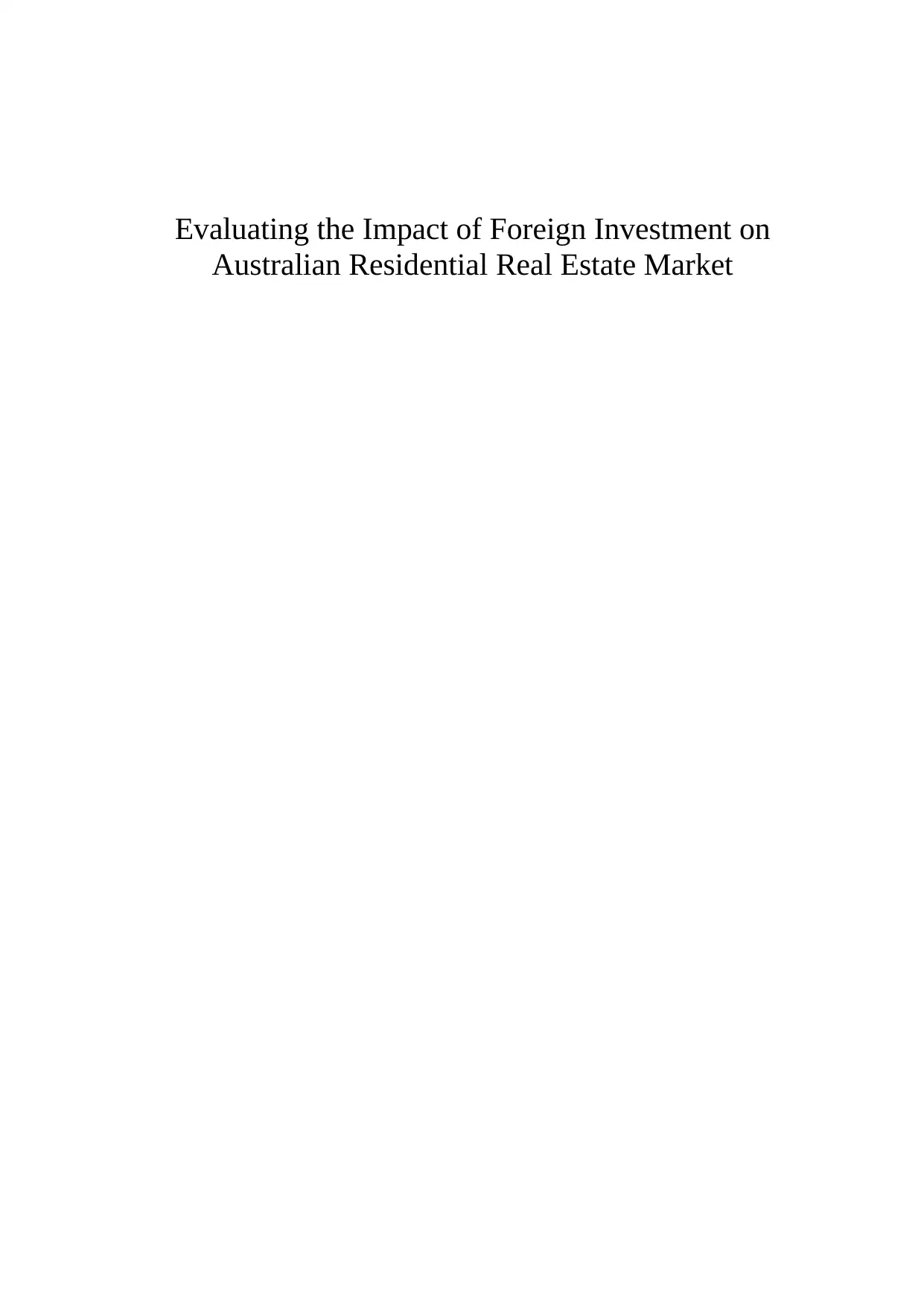
Evaluating the Impact of Foreign Investment on
Australian Residential Real Estate Market
Australian Residential Real Estate Market
Secure Best Marks with AI Grader
Need help grading? Try our AI Grader for instant feedback on your assignments.
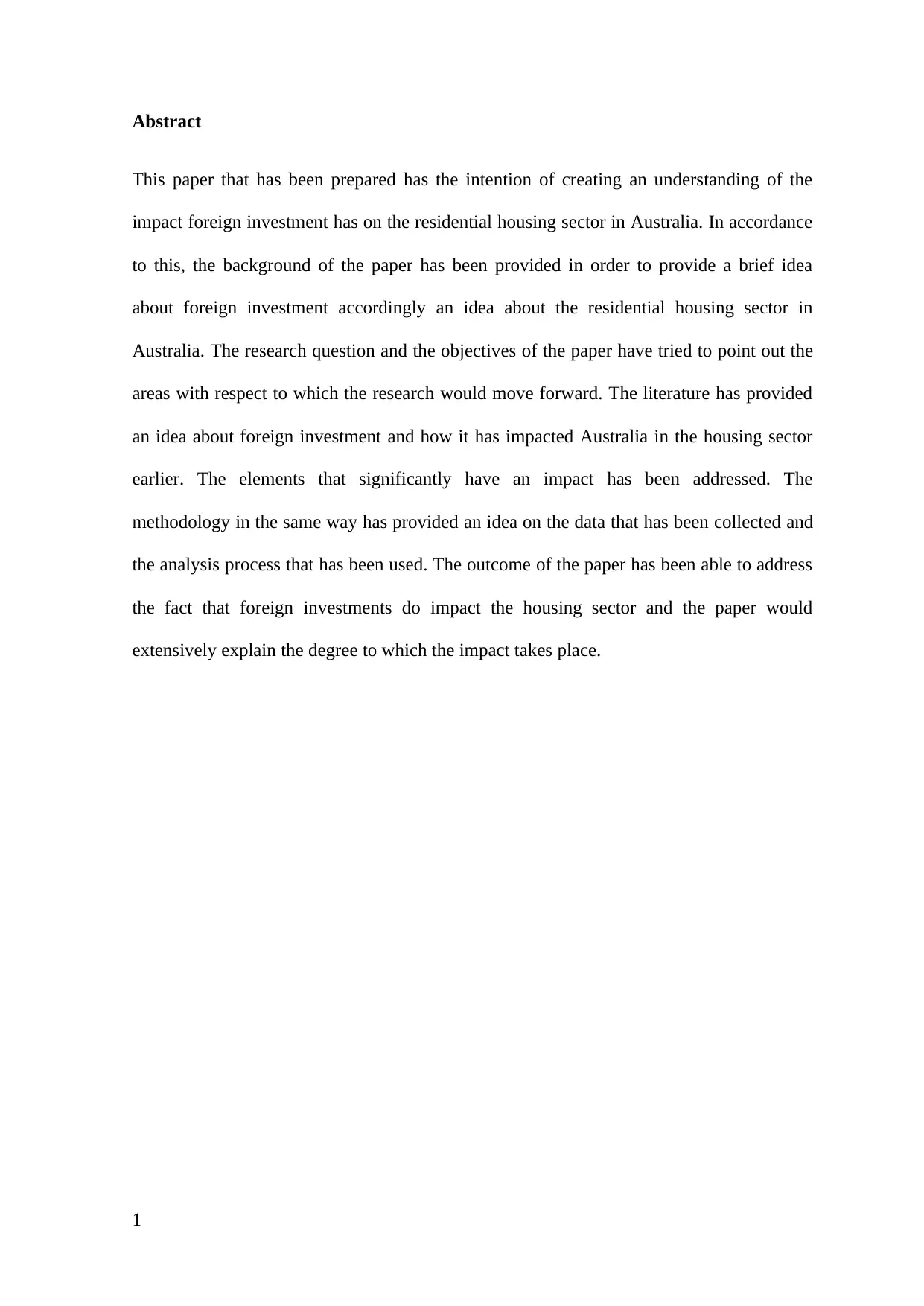
Abstract
This paper that has been prepared has the intention of creating an understanding of the
impact foreign investment has on the residential housing sector in Australia. In accordance
to this, the background of the paper has been provided in order to provide a brief idea
about foreign investment accordingly an idea about the residential housing sector in
Australia. The research question and the objectives of the paper have tried to point out the
areas with respect to which the research would move forward. The literature has provided
an idea about foreign investment and how it has impacted Australia in the housing sector
earlier. The elements that significantly have an impact has been addressed. The
methodology in the same way has provided an idea on the data that has been collected and
the analysis process that has been used. The outcome of the paper has been able to address
the fact that foreign investments do impact the housing sector and the paper would
extensively explain the degree to which the impact takes place.
1
This paper that has been prepared has the intention of creating an understanding of the
impact foreign investment has on the residential housing sector in Australia. In accordance
to this, the background of the paper has been provided in order to provide a brief idea
about foreign investment accordingly an idea about the residential housing sector in
Australia. The research question and the objectives of the paper have tried to point out the
areas with respect to which the research would move forward. The literature has provided
an idea about foreign investment and how it has impacted Australia in the housing sector
earlier. The elements that significantly have an impact has been addressed. The
methodology in the same way has provided an idea on the data that has been collected and
the analysis process that has been used. The outcome of the paper has been able to address
the fact that foreign investments do impact the housing sector and the paper would
extensively explain the degree to which the impact takes place.
1
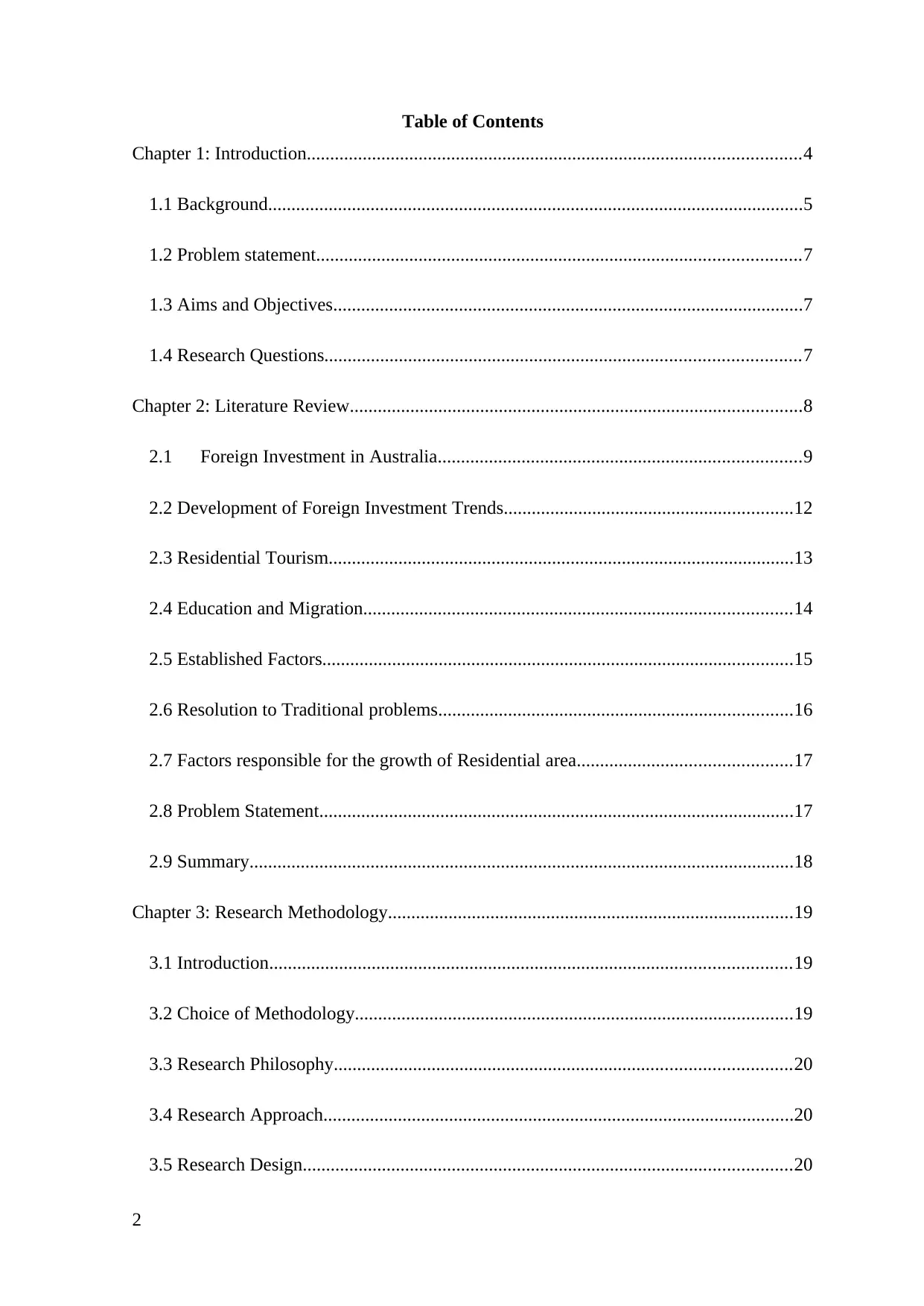
Table of Contents
Chapter 1: Introduction..........................................................................................................4
1.1 Background...................................................................................................................5
1.2 Problem statement........................................................................................................7
1.3 Aims and Objectives.....................................................................................................7
1.4 Research Questions......................................................................................................7
Chapter 2: Literature Review.................................................................................................8
2.1 Foreign Investment in Australia..............................................................................9
2.2 Development of Foreign Investment Trends..............................................................12
2.3 Residential Tourism....................................................................................................13
2.4 Education and Migration............................................................................................14
2.5 Established Factors.....................................................................................................15
2.6 Resolution to Traditional problems............................................................................16
2.7 Factors responsible for the growth of Residential area..............................................17
2.8 Problem Statement......................................................................................................17
2.9 Summary.....................................................................................................................18
Chapter 3: Research Methodology.......................................................................................19
3.1 Introduction................................................................................................................19
3.2 Choice of Methodology..............................................................................................19
3.3 Research Philosophy..................................................................................................20
3.4 Research Approach.....................................................................................................20
3.5 Research Design.........................................................................................................20
2
Chapter 1: Introduction..........................................................................................................4
1.1 Background...................................................................................................................5
1.2 Problem statement........................................................................................................7
1.3 Aims and Objectives.....................................................................................................7
1.4 Research Questions......................................................................................................7
Chapter 2: Literature Review.................................................................................................8
2.1 Foreign Investment in Australia..............................................................................9
2.2 Development of Foreign Investment Trends..............................................................12
2.3 Residential Tourism....................................................................................................13
2.4 Education and Migration............................................................................................14
2.5 Established Factors.....................................................................................................15
2.6 Resolution to Traditional problems............................................................................16
2.7 Factors responsible for the growth of Residential area..............................................17
2.8 Problem Statement......................................................................................................17
2.9 Summary.....................................................................................................................18
Chapter 3: Research Methodology.......................................................................................19
3.1 Introduction................................................................................................................19
3.2 Choice of Methodology..............................................................................................19
3.3 Research Philosophy..................................................................................................20
3.4 Research Approach.....................................................................................................20
3.5 Research Design.........................................................................................................20
2
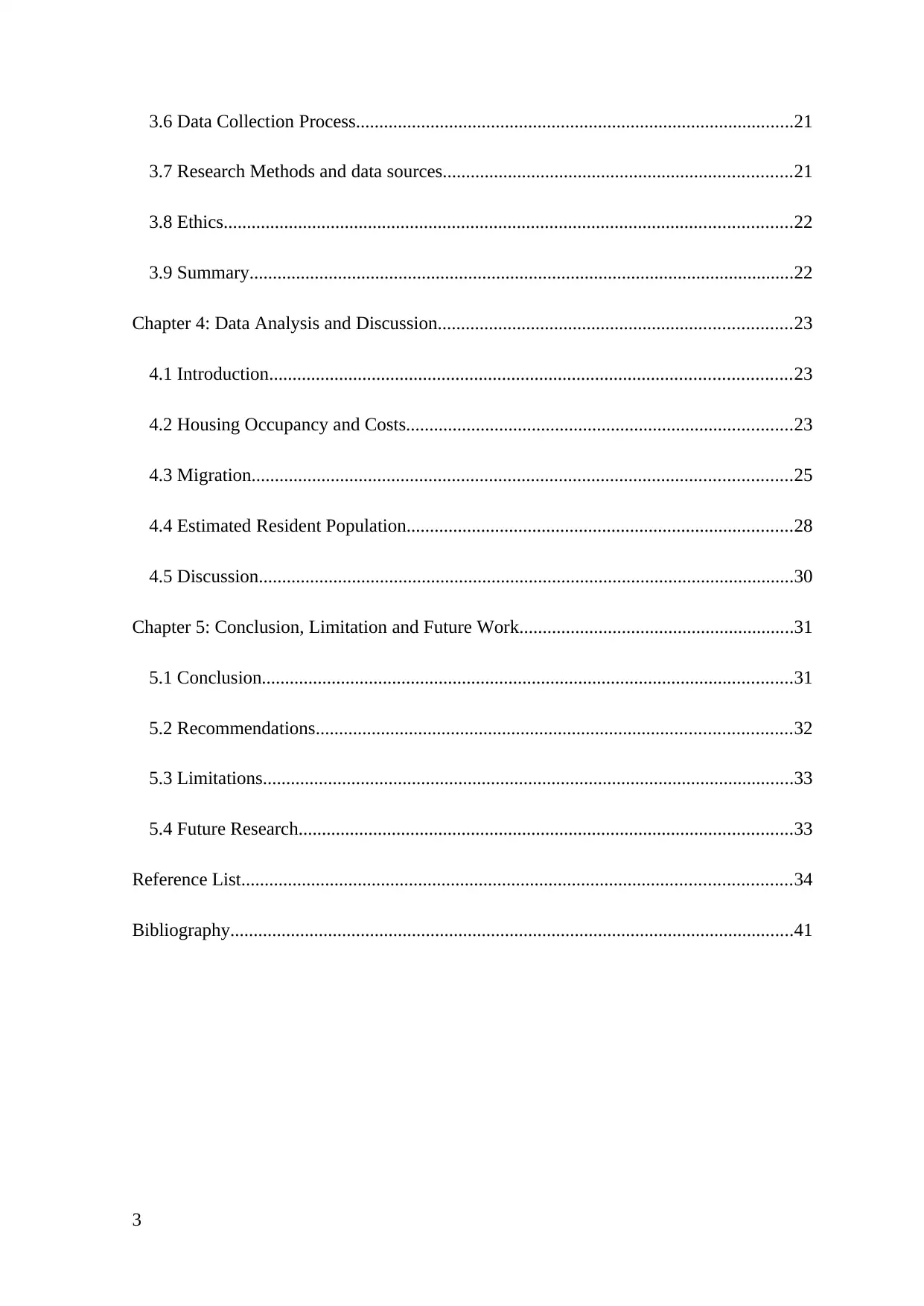
3.6 Data Collection Process..............................................................................................21
3.7 Research Methods and data sources...........................................................................21
3.8 Ethics..........................................................................................................................22
3.9 Summary.....................................................................................................................22
Chapter 4: Data Analysis and Discussion............................................................................23
4.1 Introduction................................................................................................................23
4.2 Housing Occupancy and Costs...................................................................................23
4.3 Migration....................................................................................................................25
4.4 Estimated Resident Population...................................................................................28
4.5 Discussion...................................................................................................................30
Chapter 5: Conclusion, Limitation and Future Work...........................................................31
5.1 Conclusion..................................................................................................................31
5.2 Recommendations......................................................................................................32
5.3 Limitations..................................................................................................................33
5.4 Future Research..........................................................................................................33
Reference List......................................................................................................................34
Bibliography.........................................................................................................................41
3
3.7 Research Methods and data sources...........................................................................21
3.8 Ethics..........................................................................................................................22
3.9 Summary.....................................................................................................................22
Chapter 4: Data Analysis and Discussion............................................................................23
4.1 Introduction................................................................................................................23
4.2 Housing Occupancy and Costs...................................................................................23
4.3 Migration....................................................................................................................25
4.4 Estimated Resident Population...................................................................................28
4.5 Discussion...................................................................................................................30
Chapter 5: Conclusion, Limitation and Future Work...........................................................31
5.1 Conclusion..................................................................................................................31
5.2 Recommendations......................................................................................................32
5.3 Limitations..................................................................................................................33
5.4 Future Research..........................................................................................................33
Reference List......................................................................................................................34
Bibliography.........................................................................................................................41
3
Secure Best Marks with AI Grader
Need help grading? Try our AI Grader for instant feedback on your assignments.
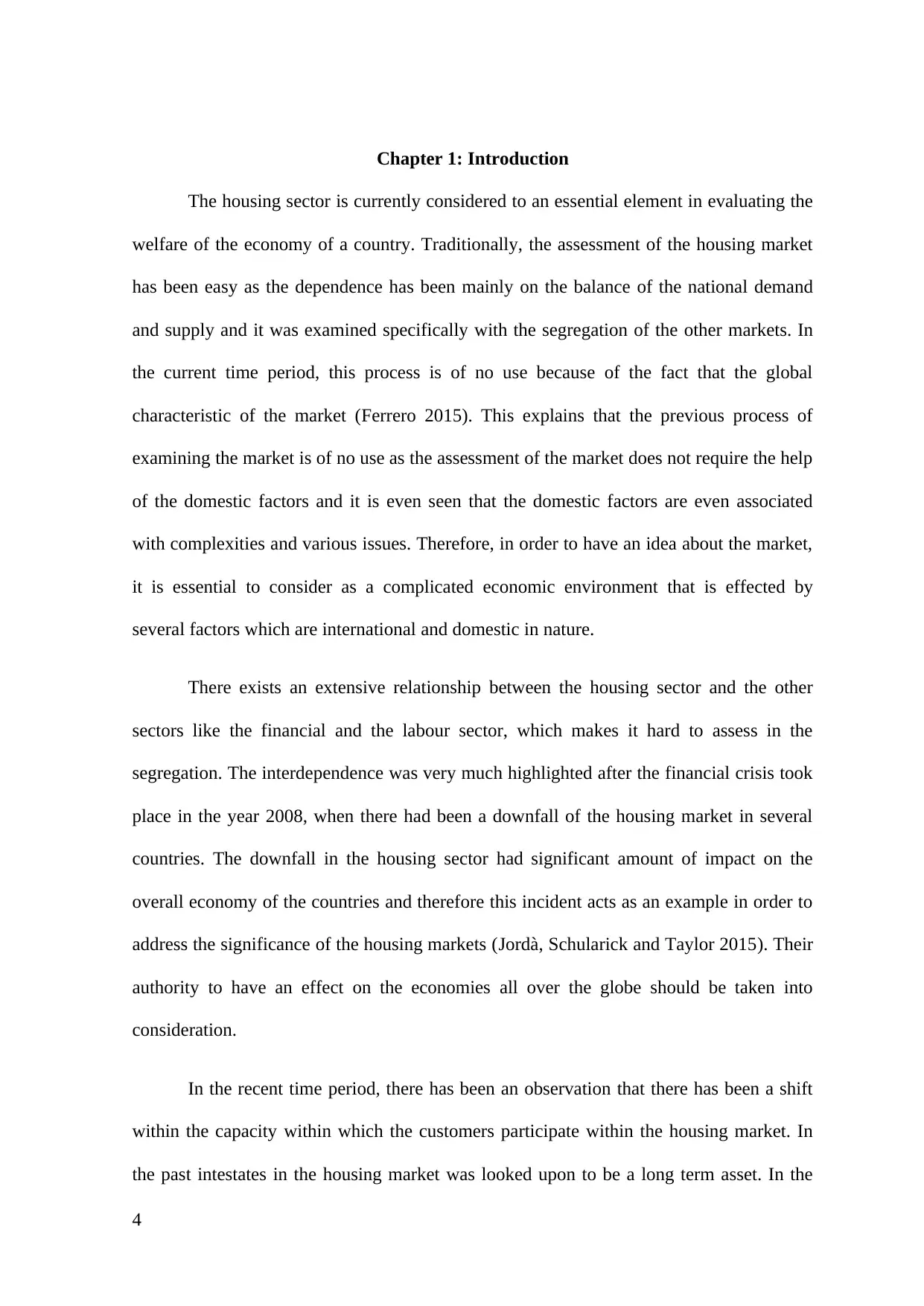
Chapter 1: Introduction
The housing sector is currently considered to an essential element in evaluating the
welfare of the economy of a country. Traditionally, the assessment of the housing market
has been easy as the dependence has been mainly on the balance of the national demand
and supply and it was examined specifically with the segregation of the other markets. In
the current time period, this process is of no use because of the fact that the global
characteristic of the market (Ferrero 2015). This explains that the previous process of
examining the market is of no use as the assessment of the market does not require the help
of the domestic factors and it is even seen that the domestic factors are even associated
with complexities and various issues. Therefore, in order to have an idea about the market,
it is essential to consider as a complicated economic environment that is effected by
several factors which are international and domestic in nature.
There exists an extensive relationship between the housing sector and the other
sectors like the financial and the labour sector, which makes it hard to assess in the
segregation. The interdependence was very much highlighted after the financial crisis took
place in the year 2008, when there had been a downfall of the housing market in several
countries. The downfall in the housing sector had significant amount of impact on the
overall economy of the countries and therefore this incident acts as an example in order to
address the significance of the housing markets (Jordà, Schularick and Taylor 2015). Their
authority to have an effect on the economies all over the globe should be taken into
consideration.
In the recent time period, there has been an observation that there has been a shift
within the capacity within which the customers participate within the housing market. In
the past intestates in the housing market was looked upon to be a long term asset. In the
4
The housing sector is currently considered to an essential element in evaluating the
welfare of the economy of a country. Traditionally, the assessment of the housing market
has been easy as the dependence has been mainly on the balance of the national demand
and supply and it was examined specifically with the segregation of the other markets. In
the current time period, this process is of no use because of the fact that the global
characteristic of the market (Ferrero 2015). This explains that the previous process of
examining the market is of no use as the assessment of the market does not require the help
of the domestic factors and it is even seen that the domestic factors are even associated
with complexities and various issues. Therefore, in order to have an idea about the market,
it is essential to consider as a complicated economic environment that is effected by
several factors which are international and domestic in nature.
There exists an extensive relationship between the housing sector and the other
sectors like the financial and the labour sector, which makes it hard to assess in the
segregation. The interdependence was very much highlighted after the financial crisis took
place in the year 2008, when there had been a downfall of the housing market in several
countries. The downfall in the housing sector had significant amount of impact on the
overall economy of the countries and therefore this incident acts as an example in order to
address the significance of the housing markets (Jordà, Schularick and Taylor 2015). Their
authority to have an effect on the economies all over the globe should be taken into
consideration.
In the recent time period, there has been an observation that there has been a shift
within the capacity within which the customers participate within the housing market. In
the past intestates in the housing market was looked upon to be a long term asset. In the
4
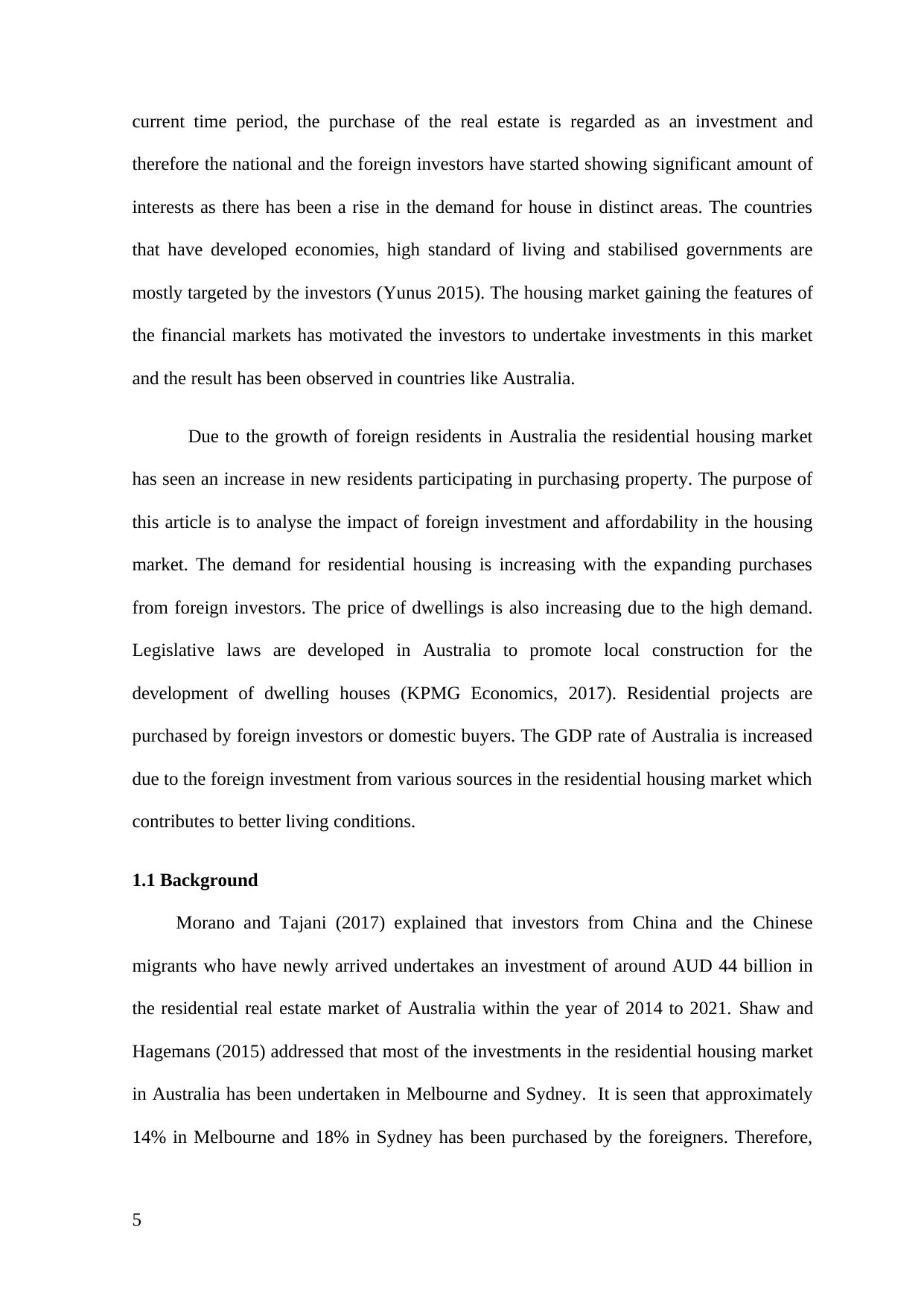
current time period, the purchase of the real estate is regarded as an investment and
therefore the national and the foreign investors have started showing significant amount of
interests as there has been a rise in the demand for house in distinct areas. The countries
that have developed economies, high standard of living and stabilised governments are
mostly targeted by the investors (Yunus 2015). The housing market gaining the features of
the financial markets has motivated the investors to undertake investments in this market
and the result has been observed in countries like Australia.
Due to the growth of foreign residents in Australia the residential housing market
has seen an increase in new residents participating in purchasing property. The purpose of
this article is to analyse the impact of foreign investment and affordability in the housing
market. The demand for residential housing is increasing with the expanding purchases
from foreign investors. The price of dwellings is also increasing due to the high demand.
Legislative laws are developed in Australia to promote local construction for the
development of dwelling houses (KPMG Economics, 2017). Residential projects are
purchased by foreign investors or domestic buyers. The GDP rate of Australia is increased
due to the foreign investment from various sources in the residential housing market which
contributes to better living conditions.
1.1 Background
Morano and Tajani (2017) explained that investors from China and the Chinese
migrants who have newly arrived undertakes an investment of around AUD 44 billion in
the residential real estate market of Australia within the year of 2014 to 2021. Shaw and
Hagemans (2015) addressed that most of the investments in the residential housing market
in Australia has been undertaken in Melbourne and Sydney. It is seen that approximately
14% in Melbourne and 18% in Sydney has been purchased by the foreigners. Therefore,
5
therefore the national and the foreign investors have started showing significant amount of
interests as there has been a rise in the demand for house in distinct areas. The countries
that have developed economies, high standard of living and stabilised governments are
mostly targeted by the investors (Yunus 2015). The housing market gaining the features of
the financial markets has motivated the investors to undertake investments in this market
and the result has been observed in countries like Australia.
Due to the growth of foreign residents in Australia the residential housing market
has seen an increase in new residents participating in purchasing property. The purpose of
this article is to analyse the impact of foreign investment and affordability in the housing
market. The demand for residential housing is increasing with the expanding purchases
from foreign investors. The price of dwellings is also increasing due to the high demand.
Legislative laws are developed in Australia to promote local construction for the
development of dwelling houses (KPMG Economics, 2017). Residential projects are
purchased by foreign investors or domestic buyers. The GDP rate of Australia is increased
due to the foreign investment from various sources in the residential housing market which
contributes to better living conditions.
1.1 Background
Morano and Tajani (2017) explained that investors from China and the Chinese
migrants who have newly arrived undertakes an investment of around AUD 44 billion in
the residential real estate market of Australia within the year of 2014 to 2021. Shaw and
Hagemans (2015) addressed that most of the investments in the residential housing market
in Australia has been undertaken in Melbourne and Sydney. It is seen that approximately
14% in Melbourne and 18% in Sydney has been purchased by the foreigners. Therefore,
5
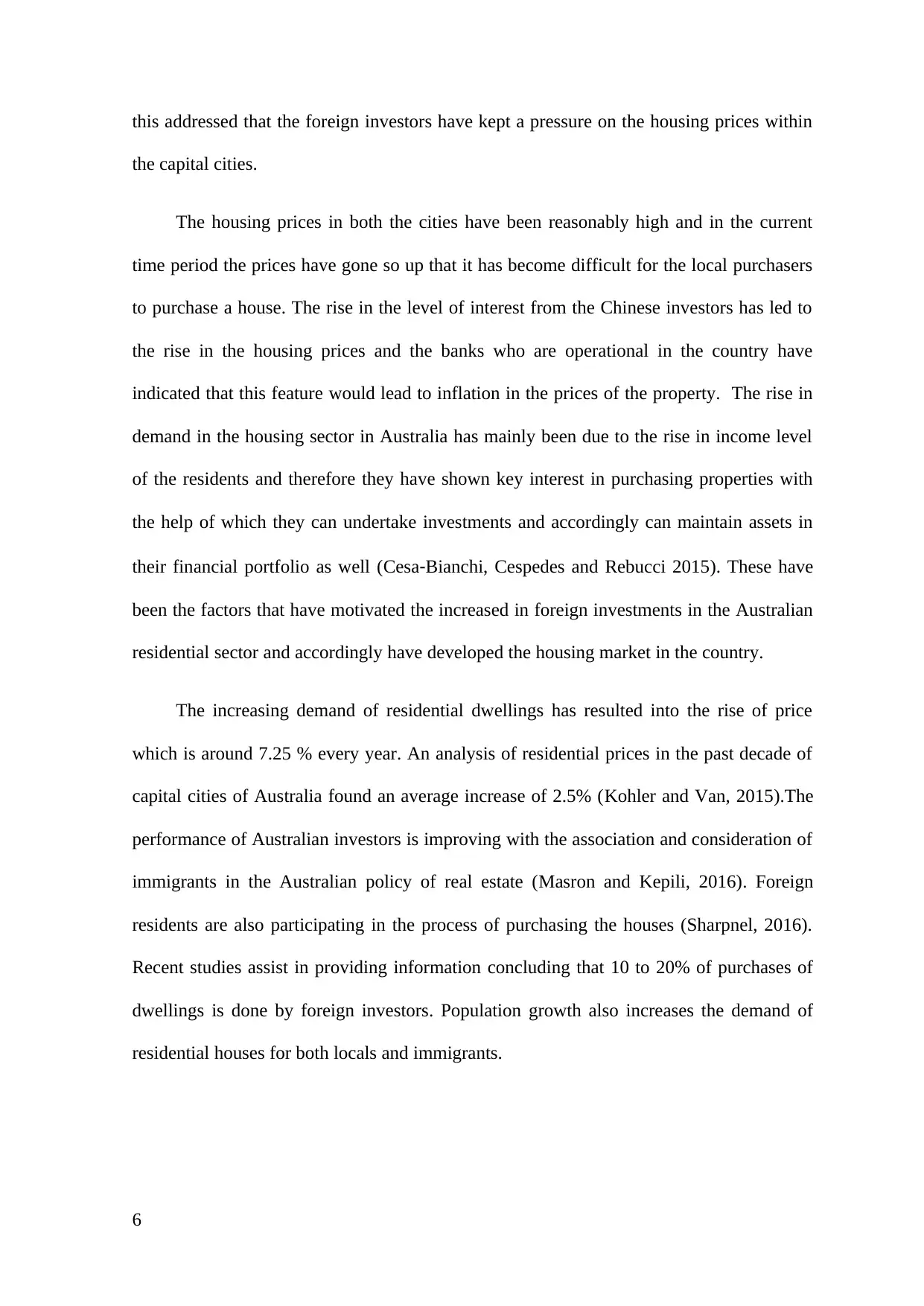
this addressed that the foreign investors have kept a pressure on the housing prices within
the capital cities.
The housing prices in both the cities have been reasonably high and in the current
time period the prices have gone so up that it has become difficult for the local purchasers
to purchase a house. The rise in the level of interest from the Chinese investors has led to
the rise in the housing prices and the banks who are operational in the country have
indicated that this feature would lead to inflation in the prices of the property. The rise in
demand in the housing sector in Australia has mainly been due to the rise in income level
of the residents and therefore they have shown key interest in purchasing properties with
the help of which they can undertake investments and accordingly can maintain assets in
their financial portfolio as well (Cesa‐Bianchi, Cespedes and Rebucci 2015). These have
been the factors that have motivated the increased in foreign investments in the Australian
residential sector and accordingly have developed the housing market in the country.
The increasing demand of residential dwellings has resulted into the rise of price
which is around 7.25 % every year. An analysis of residential prices in the past decade of
capital cities of Australia found an average increase of 2.5% (Kohler and Van, 2015).The
performance of Australian investors is improving with the association and consideration of
immigrants in the Australian policy of real estate (Masron and Kepili, 2016). Foreign
residents are also participating in the process of purchasing the houses (Sharpnel, 2016).
Recent studies assist in providing information concluding that 10 to 20% of purchases of
dwellings is done by foreign investors. Population growth also increases the demand of
residential houses for both locals and immigrants.
6
the capital cities.
The housing prices in both the cities have been reasonably high and in the current
time period the prices have gone so up that it has become difficult for the local purchasers
to purchase a house. The rise in the level of interest from the Chinese investors has led to
the rise in the housing prices and the banks who are operational in the country have
indicated that this feature would lead to inflation in the prices of the property. The rise in
demand in the housing sector in Australia has mainly been due to the rise in income level
of the residents and therefore they have shown key interest in purchasing properties with
the help of which they can undertake investments and accordingly can maintain assets in
their financial portfolio as well (Cesa‐Bianchi, Cespedes and Rebucci 2015). These have
been the factors that have motivated the increased in foreign investments in the Australian
residential sector and accordingly have developed the housing market in the country.
The increasing demand of residential dwellings has resulted into the rise of price
which is around 7.25 % every year. An analysis of residential prices in the past decade of
capital cities of Australia found an average increase of 2.5% (Kohler and Van, 2015).The
performance of Australian investors is improving with the association and consideration of
immigrants in the Australian policy of real estate (Masron and Kepili, 2016). Foreign
residents are also participating in the process of purchasing the houses (Sharpnel, 2016).
Recent studies assist in providing information concluding that 10 to 20% of purchases of
dwellings is done by foreign investors. Population growth also increases the demand of
residential houses for both locals and immigrants.
6
Paraphrase This Document
Need a fresh take? Get an instant paraphrase of this document with our AI Paraphraser
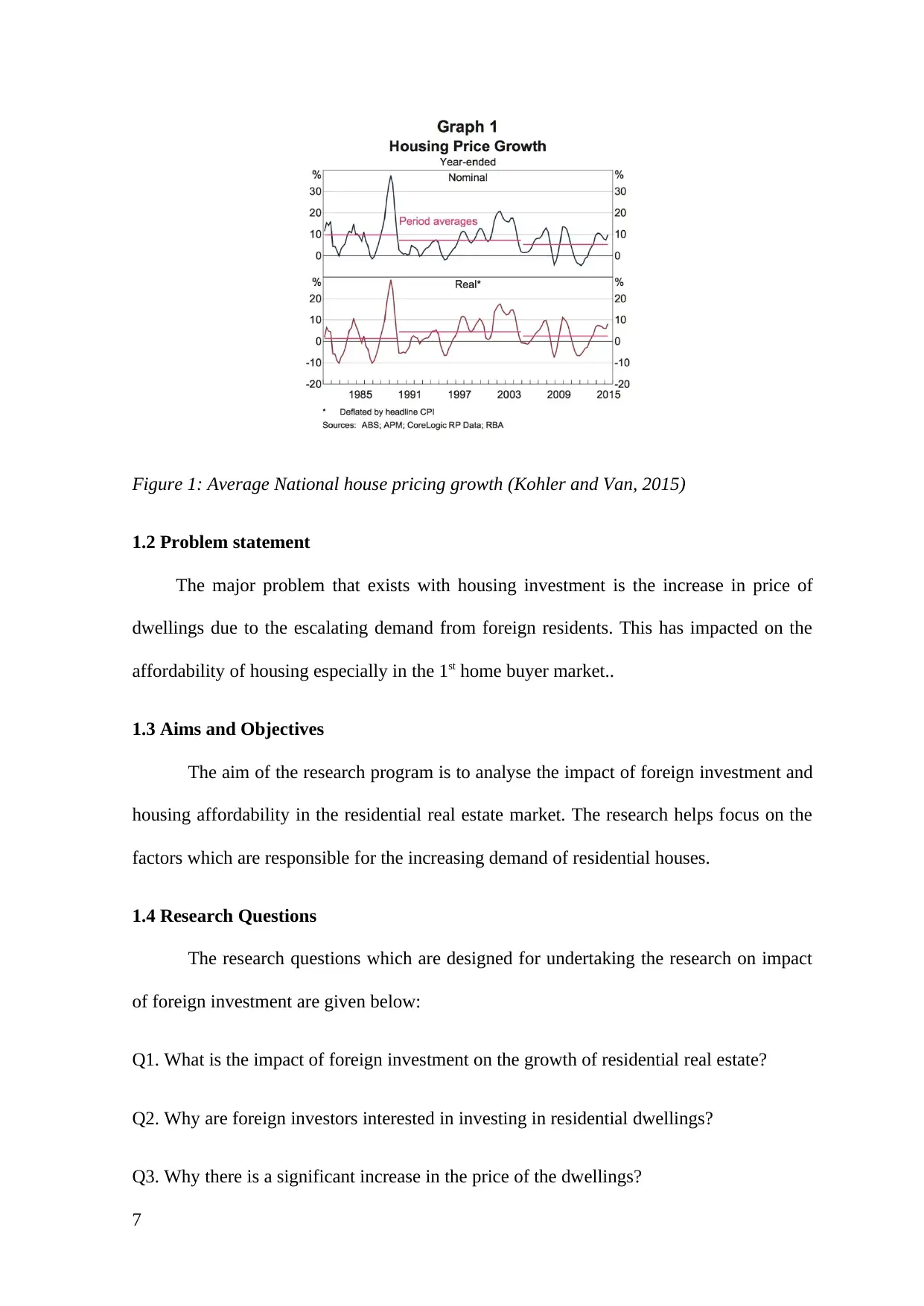
Figure 1: Average National house pricing growth (Kohler and Van, 2015)
1.2 Problem statement
The major problem that exists with housing investment is the increase in price of
dwellings due to the escalating demand from foreign residents. This has impacted on the
affordability of housing especially in the 1st home buyer market..
1.3 Aims and Objectives
The aim of the research program is to analyse the impact of foreign investment and
housing affordability in the residential real estate market. The research helps focus on the
factors which are responsible for the increasing demand of residential houses.
1.4 Research Questions
The research questions which are designed for undertaking the research on impact
of foreign investment are given below:
Q1. What is the impact of foreign investment on the growth of residential real estate?
Q2. Why are foreign investors interested in investing in residential dwellings?
Q3. Why there is a significant increase in the price of the dwellings?
7
1.2 Problem statement
The major problem that exists with housing investment is the increase in price of
dwellings due to the escalating demand from foreign residents. This has impacted on the
affordability of housing especially in the 1st home buyer market..
1.3 Aims and Objectives
The aim of the research program is to analyse the impact of foreign investment and
housing affordability in the residential real estate market. The research helps focus on the
factors which are responsible for the increasing demand of residential houses.
1.4 Research Questions
The research questions which are designed for undertaking the research on impact
of foreign investment are given below:
Q1. What is the impact of foreign investment on the growth of residential real estate?
Q2. Why are foreign investors interested in investing in residential dwellings?
Q3. Why there is a significant increase in the price of the dwellings?
7
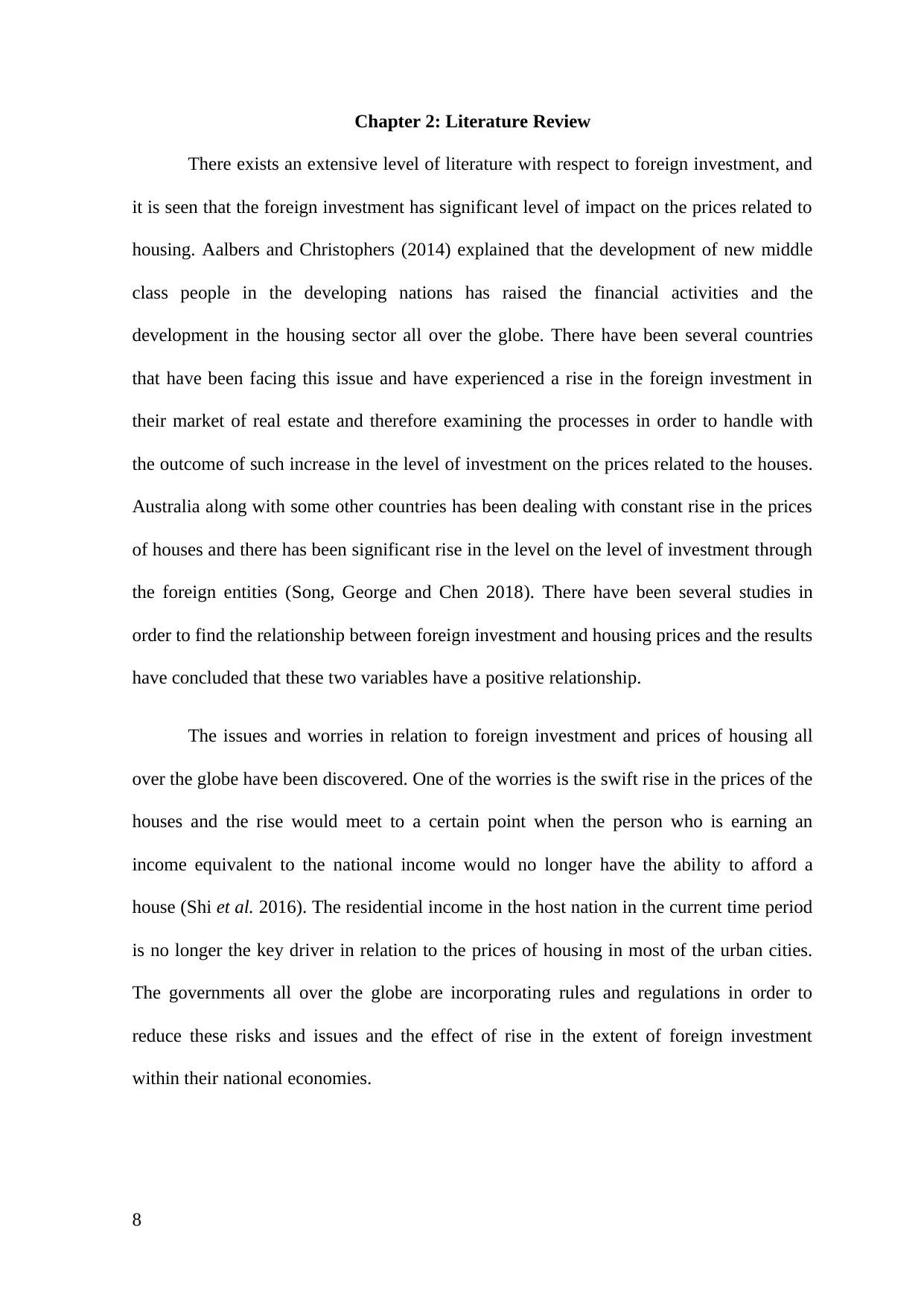
Chapter 2: Literature Review
There exists an extensive level of literature with respect to foreign investment, and
it is seen that the foreign investment has significant level of impact on the prices related to
housing. Aalbers and Christophers (2014) explained that the development of new middle
class people in the developing nations has raised the financial activities and the
development in the housing sector all over the globe. There have been several countries
that have been facing this issue and have experienced a rise in the foreign investment in
their market of real estate and therefore examining the processes in order to handle with
the outcome of such increase in the level of investment on the prices related to the houses.
Australia along with some other countries has been dealing with constant rise in the prices
of houses and there has been significant rise in the level on the level of investment through
the foreign entities (Song, George and Chen 2018). There have been several studies in
order to find the relationship between foreign investment and housing prices and the results
have concluded that these two variables have a positive relationship.
The issues and worries in relation to foreign investment and prices of housing all
over the globe have been discovered. One of the worries is the swift rise in the prices of the
houses and the rise would meet to a certain point when the person who is earning an
income equivalent to the national income would no longer have the ability to afford a
house (Shi et al. 2016). The residential income in the host nation in the current time period
is no longer the key driver in relation to the prices of housing in most of the urban cities.
The governments all over the globe are incorporating rules and regulations in order to
reduce these risks and issues and the effect of rise in the extent of foreign investment
within their national economies.
8
There exists an extensive level of literature with respect to foreign investment, and
it is seen that the foreign investment has significant level of impact on the prices related to
housing. Aalbers and Christophers (2014) explained that the development of new middle
class people in the developing nations has raised the financial activities and the
development in the housing sector all over the globe. There have been several countries
that have been facing this issue and have experienced a rise in the foreign investment in
their market of real estate and therefore examining the processes in order to handle with
the outcome of such increase in the level of investment on the prices related to the houses.
Australia along with some other countries has been dealing with constant rise in the prices
of houses and there has been significant rise in the level on the level of investment through
the foreign entities (Song, George and Chen 2018). There have been several studies in
order to find the relationship between foreign investment and housing prices and the results
have concluded that these two variables have a positive relationship.
The issues and worries in relation to foreign investment and prices of housing all
over the globe have been discovered. One of the worries is the swift rise in the prices of the
houses and the rise would meet to a certain point when the person who is earning an
income equivalent to the national income would no longer have the ability to afford a
house (Shi et al. 2016). The residential income in the host nation in the current time period
is no longer the key driver in relation to the prices of housing in most of the urban cities.
The governments all over the globe are incorporating rules and regulations in order to
reduce these risks and issues and the effect of rise in the extent of foreign investment
within their national economies.
8
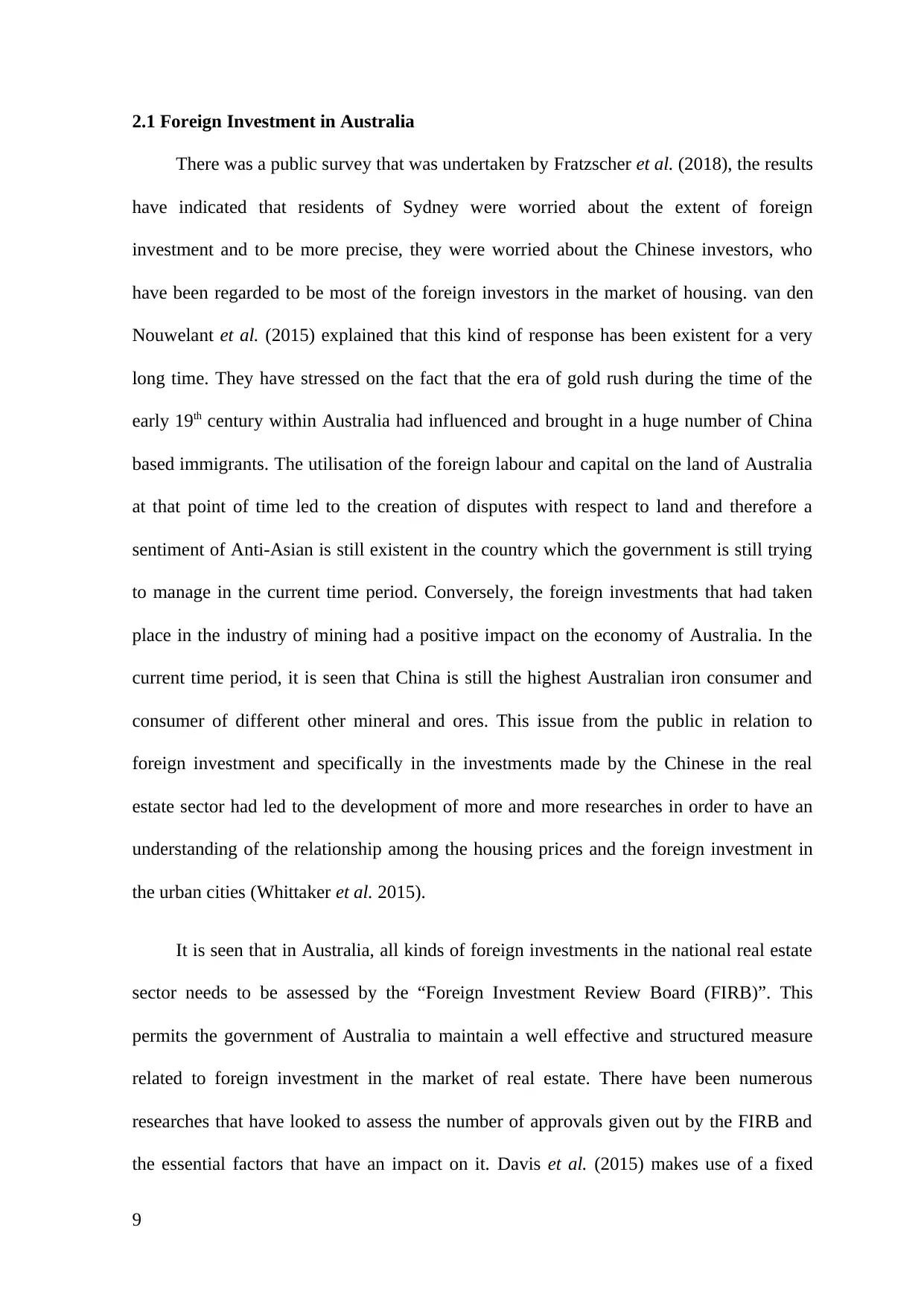
2.1 Foreign Investment in Australia
There was a public survey that was undertaken by Fratzscher et al. (2018), the results
have indicated that residents of Sydney were worried about the extent of foreign
investment and to be more precise, they were worried about the Chinese investors, who
have been regarded to be most of the foreign investors in the market of housing. van den
Nouwelant et al. (2015) explained that this kind of response has been existent for a very
long time. They have stressed on the fact that the era of gold rush during the time of the
early 19th century within Australia had influenced and brought in a huge number of China
based immigrants. The utilisation of the foreign labour and capital on the land of Australia
at that point of time led to the creation of disputes with respect to land and therefore a
sentiment of Anti-Asian is still existent in the country which the government is still trying
to manage in the current time period. Conversely, the foreign investments that had taken
place in the industry of mining had a positive impact on the economy of Australia. In the
current time period, it is seen that China is still the highest Australian iron consumer and
consumer of different other mineral and ores. This issue from the public in relation to
foreign investment and specifically in the investments made by the Chinese in the real
estate sector had led to the development of more and more researches in order to have an
understanding of the relationship among the housing prices and the foreign investment in
the urban cities (Whittaker et al. 2015).
It is seen that in Australia, all kinds of foreign investments in the national real estate
sector needs to be assessed by the “Foreign Investment Review Board (FIRB)”. This
permits the government of Australia to maintain a well effective and structured measure
related to foreign investment in the market of real estate. There have been numerous
researches that have looked to assess the number of approvals given out by the FIRB and
the essential factors that have an impact on it. Davis et al. (2015) makes use of a fixed
9
There was a public survey that was undertaken by Fratzscher et al. (2018), the results
have indicated that residents of Sydney were worried about the extent of foreign
investment and to be more precise, they were worried about the Chinese investors, who
have been regarded to be most of the foreign investors in the market of housing. van den
Nouwelant et al. (2015) explained that this kind of response has been existent for a very
long time. They have stressed on the fact that the era of gold rush during the time of the
early 19th century within Australia had influenced and brought in a huge number of China
based immigrants. The utilisation of the foreign labour and capital on the land of Australia
at that point of time led to the creation of disputes with respect to land and therefore a
sentiment of Anti-Asian is still existent in the country which the government is still trying
to manage in the current time period. Conversely, the foreign investments that had taken
place in the industry of mining had a positive impact on the economy of Australia. In the
current time period, it is seen that China is still the highest Australian iron consumer and
consumer of different other mineral and ores. This issue from the public in relation to
foreign investment and specifically in the investments made by the Chinese in the real
estate sector had led to the development of more and more researches in order to have an
understanding of the relationship among the housing prices and the foreign investment in
the urban cities (Whittaker et al. 2015).
It is seen that in Australia, all kinds of foreign investments in the national real estate
sector needs to be assessed by the “Foreign Investment Review Board (FIRB)”. This
permits the government of Australia to maintain a well effective and structured measure
related to foreign investment in the market of real estate. There have been numerous
researches that have looked to assess the number of approvals given out by the FIRB and
the essential factors that have an impact on it. Davis et al. (2015) makes use of a fixed
9
Secure Best Marks with AI Grader
Need help grading? Try our AI Grader for instant feedback on your assignments.
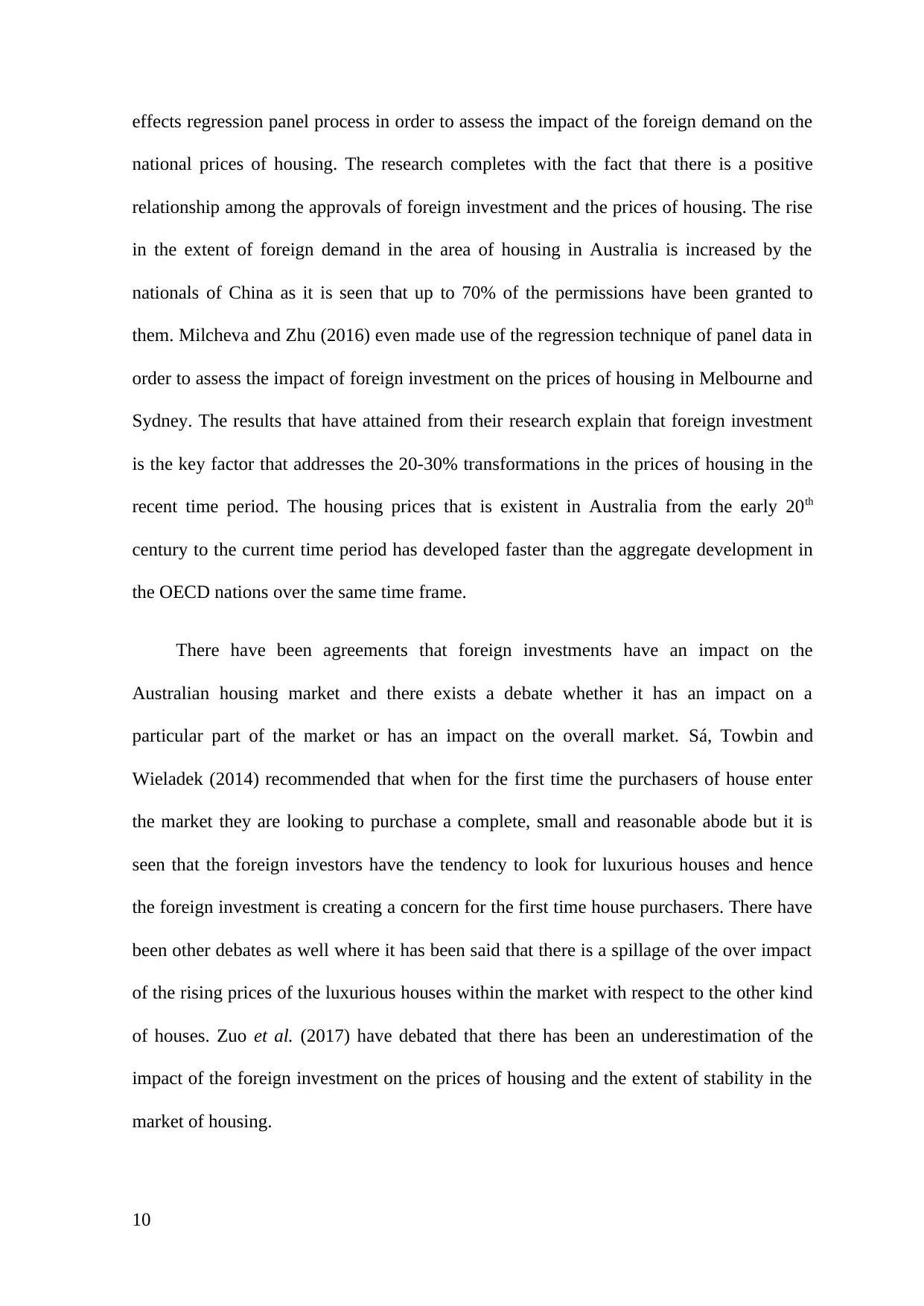
effects regression panel process in order to assess the impact of the foreign demand on the
national prices of housing. The research completes with the fact that there is a positive
relationship among the approvals of foreign investment and the prices of housing. The rise
in the extent of foreign demand in the area of housing in Australia is increased by the
nationals of China as it is seen that up to 70% of the permissions have been granted to
them. Milcheva and Zhu (2016) even made use of the regression technique of panel data in
order to assess the impact of foreign investment on the prices of housing in Melbourne and
Sydney. The results that have attained from their research explain that foreign investment
is the key factor that addresses the 20-30% transformations in the prices of housing in the
recent time period. The housing prices that is existent in Australia from the early 20th
century to the current time period has developed faster than the aggregate development in
the OECD nations over the same time frame.
There have been agreements that foreign investments have an impact on the
Australian housing market and there exists a debate whether it has an impact on a
particular part of the market or has an impact on the overall market. Sá, Towbin and
Wieladek (2014) recommended that when for the first time the purchasers of house enter
the market they are looking to purchase a complete, small and reasonable abode but it is
seen that the foreign investors have the tendency to look for luxurious houses and hence
the foreign investment is creating a concern for the first time house purchasers. There have
been other debates as well where it has been said that there is a spillage of the over impact
of the rising prices of the luxurious houses within the market with respect to the other kind
of houses. Zuo et al. (2017) have debated that there has been an underestimation of the
impact of the foreign investment on the prices of housing and the extent of stability in the
market of housing.
10
national prices of housing. The research completes with the fact that there is a positive
relationship among the approvals of foreign investment and the prices of housing. The rise
in the extent of foreign demand in the area of housing in Australia is increased by the
nationals of China as it is seen that up to 70% of the permissions have been granted to
them. Milcheva and Zhu (2016) even made use of the regression technique of panel data in
order to assess the impact of foreign investment on the prices of housing in Melbourne and
Sydney. The results that have attained from their research explain that foreign investment
is the key factor that addresses the 20-30% transformations in the prices of housing in the
recent time period. The housing prices that is existent in Australia from the early 20th
century to the current time period has developed faster than the aggregate development in
the OECD nations over the same time frame.
There have been agreements that foreign investments have an impact on the
Australian housing market and there exists a debate whether it has an impact on a
particular part of the market or has an impact on the overall market. Sá, Towbin and
Wieladek (2014) recommended that when for the first time the purchasers of house enter
the market they are looking to purchase a complete, small and reasonable abode but it is
seen that the foreign investors have the tendency to look for luxurious houses and hence
the foreign investment is creating a concern for the first time house purchasers. There have
been other debates as well where it has been said that there is a spillage of the over impact
of the rising prices of the luxurious houses within the market with respect to the other kind
of houses. Zuo et al. (2017) have debated that there has been an underestimation of the
impact of the foreign investment on the prices of housing and the extent of stability in the
market of housing.
10
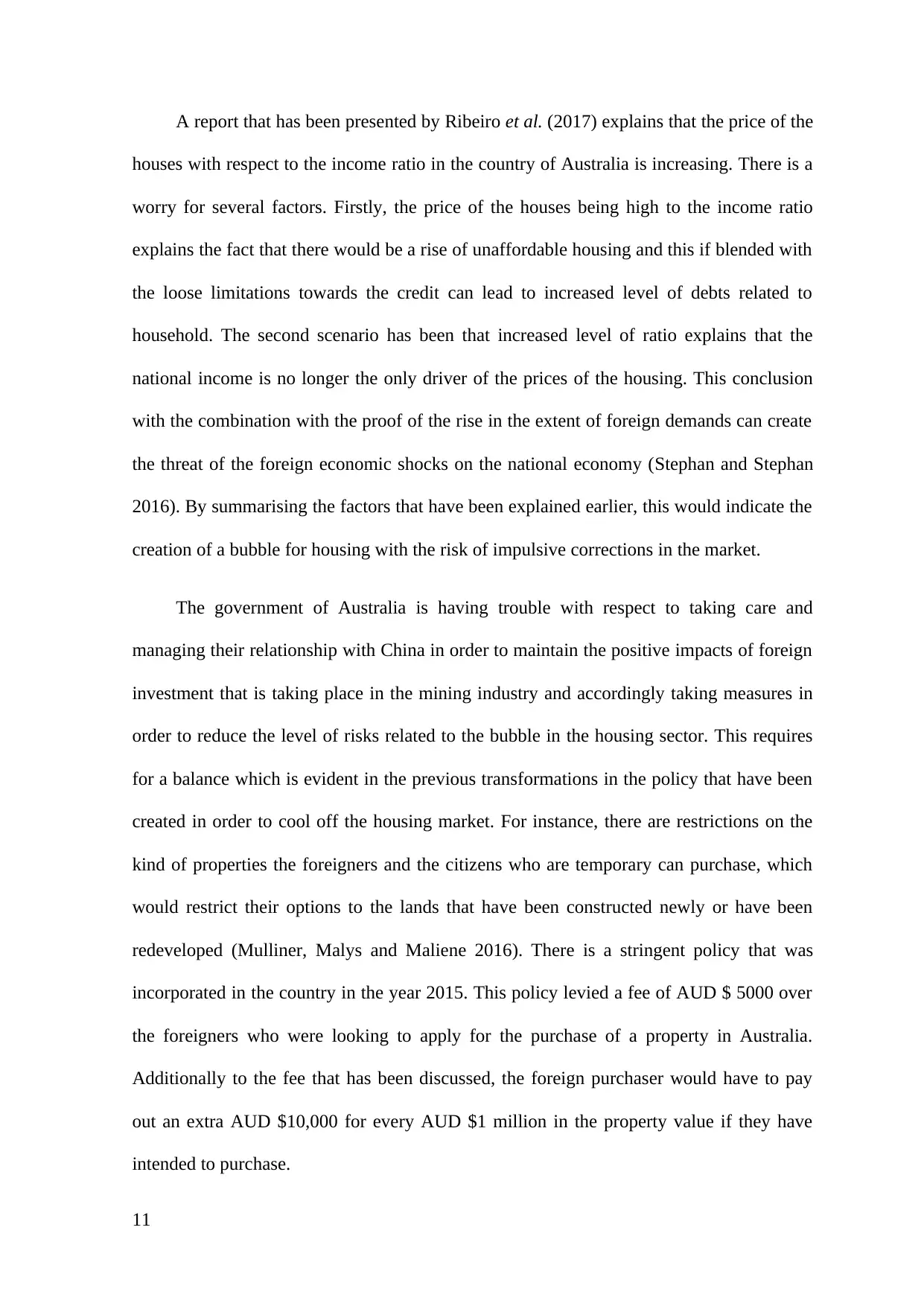
A report that has been presented by Ribeiro et al. (2017) explains that the price of the
houses with respect to the income ratio in the country of Australia is increasing. There is a
worry for several factors. Firstly, the price of the houses being high to the income ratio
explains the fact that there would be a rise of unaffordable housing and this if blended with
the loose limitations towards the credit can lead to increased level of debts related to
household. The second scenario has been that increased level of ratio explains that the
national income is no longer the only driver of the prices of the housing. This conclusion
with the combination with the proof of the rise in the extent of foreign demands can create
the threat of the foreign economic shocks on the national economy (Stephan and Stephan
2016). By summarising the factors that have been explained earlier, this would indicate the
creation of a bubble for housing with the risk of impulsive corrections in the market.
The government of Australia is having trouble with respect to taking care and
managing their relationship with China in order to maintain the positive impacts of foreign
investment that is taking place in the mining industry and accordingly taking measures in
order to reduce the level of risks related to the bubble in the housing sector. This requires
for a balance which is evident in the previous transformations in the policy that have been
created in order to cool off the housing market. For instance, there are restrictions on the
kind of properties the foreigners and the citizens who are temporary can purchase, which
would restrict their options to the lands that have been constructed newly or have been
redeveloped (Mulliner, Malys and Maliene 2016). There is a stringent policy that was
incorporated in the country in the year 2015. This policy levied a fee of AUD $ 5000 over
the foreigners who were looking to apply for the purchase of a property in Australia.
Additionally to the fee that has been discussed, the foreign purchaser would have to pay
out an extra AUD $10,000 for every AUD $1 million in the property value if they have
intended to purchase.
11
houses with respect to the income ratio in the country of Australia is increasing. There is a
worry for several factors. Firstly, the price of the houses being high to the income ratio
explains the fact that there would be a rise of unaffordable housing and this if blended with
the loose limitations towards the credit can lead to increased level of debts related to
household. The second scenario has been that increased level of ratio explains that the
national income is no longer the only driver of the prices of the housing. This conclusion
with the combination with the proof of the rise in the extent of foreign demands can create
the threat of the foreign economic shocks on the national economy (Stephan and Stephan
2016). By summarising the factors that have been explained earlier, this would indicate the
creation of a bubble for housing with the risk of impulsive corrections in the market.
The government of Australia is having trouble with respect to taking care and
managing their relationship with China in order to maintain the positive impacts of foreign
investment that is taking place in the mining industry and accordingly taking measures in
order to reduce the level of risks related to the bubble in the housing sector. This requires
for a balance which is evident in the previous transformations in the policy that have been
created in order to cool off the housing market. For instance, there are restrictions on the
kind of properties the foreigners and the citizens who are temporary can purchase, which
would restrict their options to the lands that have been constructed newly or have been
redeveloped (Mulliner, Malys and Maliene 2016). There is a stringent policy that was
incorporated in the country in the year 2015. This policy levied a fee of AUD $ 5000 over
the foreigners who were looking to apply for the purchase of a property in Australia.
Additionally to the fee that has been discussed, the foreign purchaser would have to pay
out an extra AUD $10,000 for every AUD $1 million in the property value if they have
intended to purchase.
11
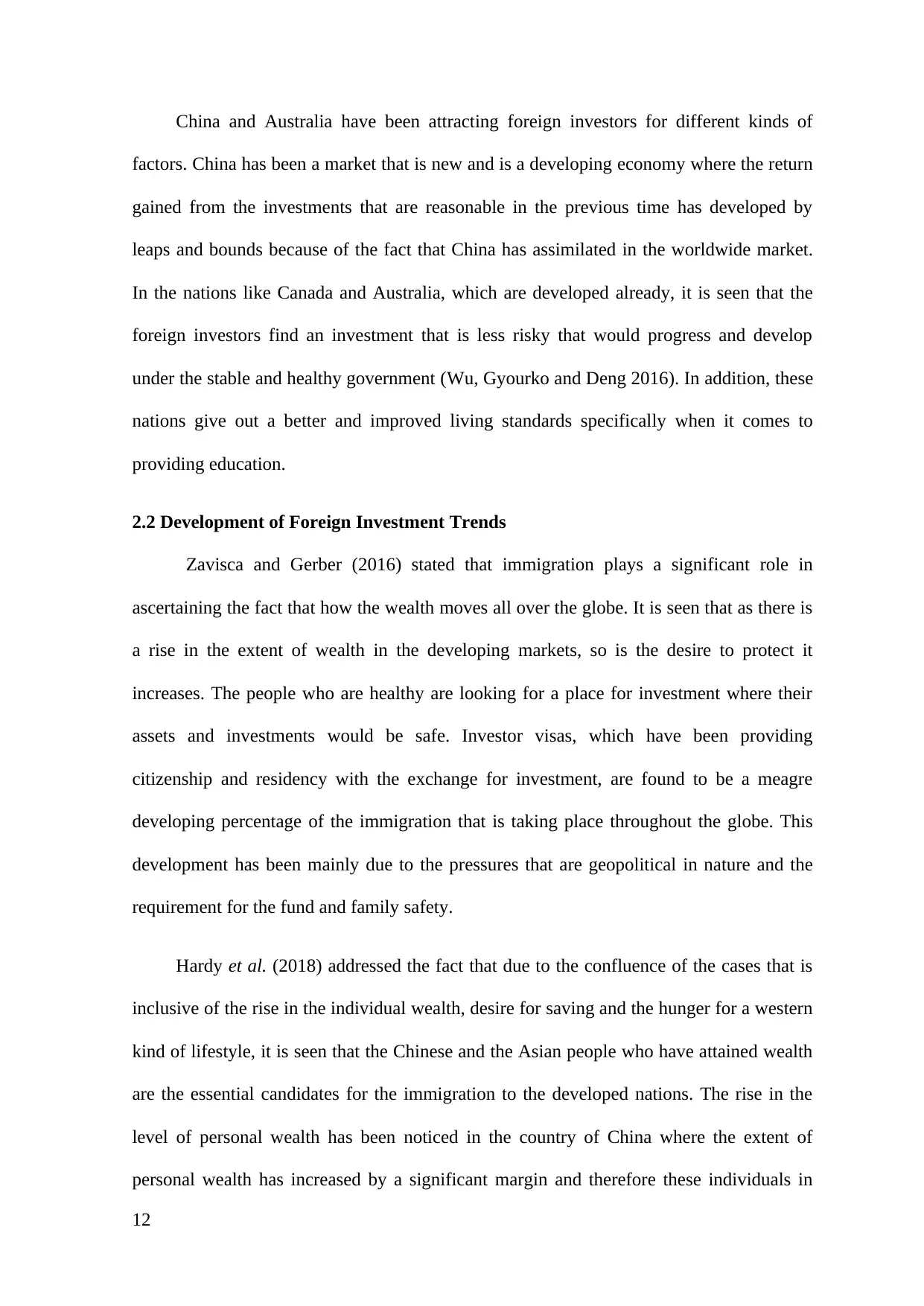
China and Australia have been attracting foreign investors for different kinds of
factors. China has been a market that is new and is a developing economy where the return
gained from the investments that are reasonable in the previous time has developed by
leaps and bounds because of the fact that China has assimilated in the worldwide market.
In the nations like Canada and Australia, which are developed already, it is seen that the
foreign investors find an investment that is less risky that would progress and develop
under the stable and healthy government (Wu, Gyourko and Deng 2016). In addition, these
nations give out a better and improved living standards specifically when it comes to
providing education.
2.2 Development of Foreign Investment Trends
Zavisca and Gerber (2016) stated that immigration plays a significant role in
ascertaining the fact that how the wealth moves all over the globe. It is seen that as there is
a rise in the extent of wealth in the developing markets, so is the desire to protect it
increases. The people who are healthy are looking for a place for investment where their
assets and investments would be safe. Investor visas, which have been providing
citizenship and residency with the exchange for investment, are found to be a meagre
developing percentage of the immigration that is taking place throughout the globe. This
development has been mainly due to the pressures that are geopolitical in nature and the
requirement for the fund and family safety.
Hardy et al. (2018) addressed the fact that due to the confluence of the cases that is
inclusive of the rise in the individual wealth, desire for saving and the hunger for a western
kind of lifestyle, it is seen that the Chinese and the Asian people who have attained wealth
are the essential candidates for the immigration to the developed nations. The rise in the
level of personal wealth has been noticed in the country of China where the extent of
personal wealth has increased by a significant margin and therefore these individuals in
12
factors. China has been a market that is new and is a developing economy where the return
gained from the investments that are reasonable in the previous time has developed by
leaps and bounds because of the fact that China has assimilated in the worldwide market.
In the nations like Canada and Australia, which are developed already, it is seen that the
foreign investors find an investment that is less risky that would progress and develop
under the stable and healthy government (Wu, Gyourko and Deng 2016). In addition, these
nations give out a better and improved living standards specifically when it comes to
providing education.
2.2 Development of Foreign Investment Trends
Zavisca and Gerber (2016) stated that immigration plays a significant role in
ascertaining the fact that how the wealth moves all over the globe. It is seen that as there is
a rise in the extent of wealth in the developing markets, so is the desire to protect it
increases. The people who are healthy are looking for a place for investment where their
assets and investments would be safe. Investor visas, which have been providing
citizenship and residency with the exchange for investment, are found to be a meagre
developing percentage of the immigration that is taking place throughout the globe. This
development has been mainly due to the pressures that are geopolitical in nature and the
requirement for the fund and family safety.
Hardy et al. (2018) addressed the fact that due to the confluence of the cases that is
inclusive of the rise in the individual wealth, desire for saving and the hunger for a western
kind of lifestyle, it is seen that the Chinese and the Asian people who have attained wealth
are the essential candidates for the immigration to the developed nations. The rise in the
level of personal wealth has been noticed in the country of China where the extent of
personal wealth has increased by a significant margin and therefore these individuals in
12
Paraphrase This Document
Need a fresh take? Get an instant paraphrase of this document with our AI Paraphraser
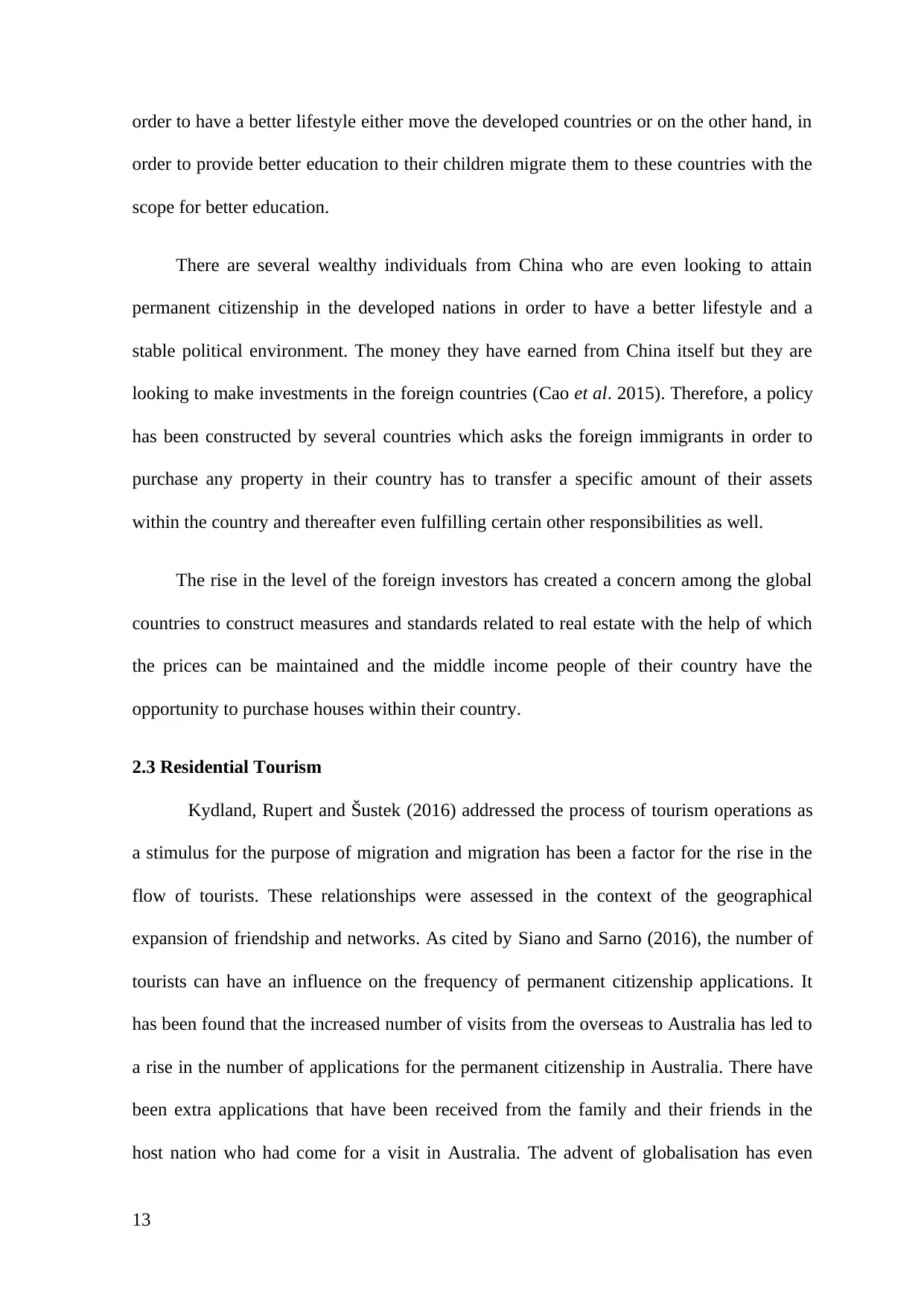
order to have a better lifestyle either move the developed countries or on the other hand, in
order to provide better education to their children migrate them to these countries with the
scope for better education.
There are several wealthy individuals from China who are even looking to attain
permanent citizenship in the developed nations in order to have a better lifestyle and a
stable political environment. The money they have earned from China itself but they are
looking to make investments in the foreign countries (Cao et al. 2015). Therefore, a policy
has been constructed by several countries which asks the foreign immigrants in order to
purchase any property in their country has to transfer a specific amount of their assets
within the country and thereafter even fulfilling certain other responsibilities as well.
The rise in the level of the foreign investors has created a concern among the global
countries to construct measures and standards related to real estate with the help of which
the prices can be maintained and the middle income people of their country have the
opportunity to purchase houses within their country.
2.3 Residential Tourism
Kydland, Rupert and Šustek (2016) addressed the process of tourism operations as
a stimulus for the purpose of migration and migration has been a factor for the rise in the
flow of tourists. These relationships were assessed in the context of the geographical
expansion of friendship and networks. As cited by Siano and Sarno (2016), the number of
tourists can have an influence on the frequency of permanent citizenship applications. It
has been found that the increased number of visits from the overseas to Australia has led to
a rise in the number of applications for the permanent citizenship in Australia. There have
been extra applications that have been received from the family and their friends in the
host nation who had come for a visit in Australia. The advent of globalisation has even
13
order to provide better education to their children migrate them to these countries with the
scope for better education.
There are several wealthy individuals from China who are even looking to attain
permanent citizenship in the developed nations in order to have a better lifestyle and a
stable political environment. The money they have earned from China itself but they are
looking to make investments in the foreign countries (Cao et al. 2015). Therefore, a policy
has been constructed by several countries which asks the foreign immigrants in order to
purchase any property in their country has to transfer a specific amount of their assets
within the country and thereafter even fulfilling certain other responsibilities as well.
The rise in the level of the foreign investors has created a concern among the global
countries to construct measures and standards related to real estate with the help of which
the prices can be maintained and the middle income people of their country have the
opportunity to purchase houses within their country.
2.3 Residential Tourism
Kydland, Rupert and Šustek (2016) addressed the process of tourism operations as
a stimulus for the purpose of migration and migration has been a factor for the rise in the
flow of tourists. These relationships were assessed in the context of the geographical
expansion of friendship and networks. As cited by Siano and Sarno (2016), the number of
tourists can have an influence on the frequency of permanent citizenship applications. It
has been found that the increased number of visits from the overseas to Australia has led to
a rise in the number of applications for the permanent citizenship in Australia. There have
been extra applications that have been received from the family and their friends in the
host nation who had come for a visit in Australia. The advent of globalisation has even
13
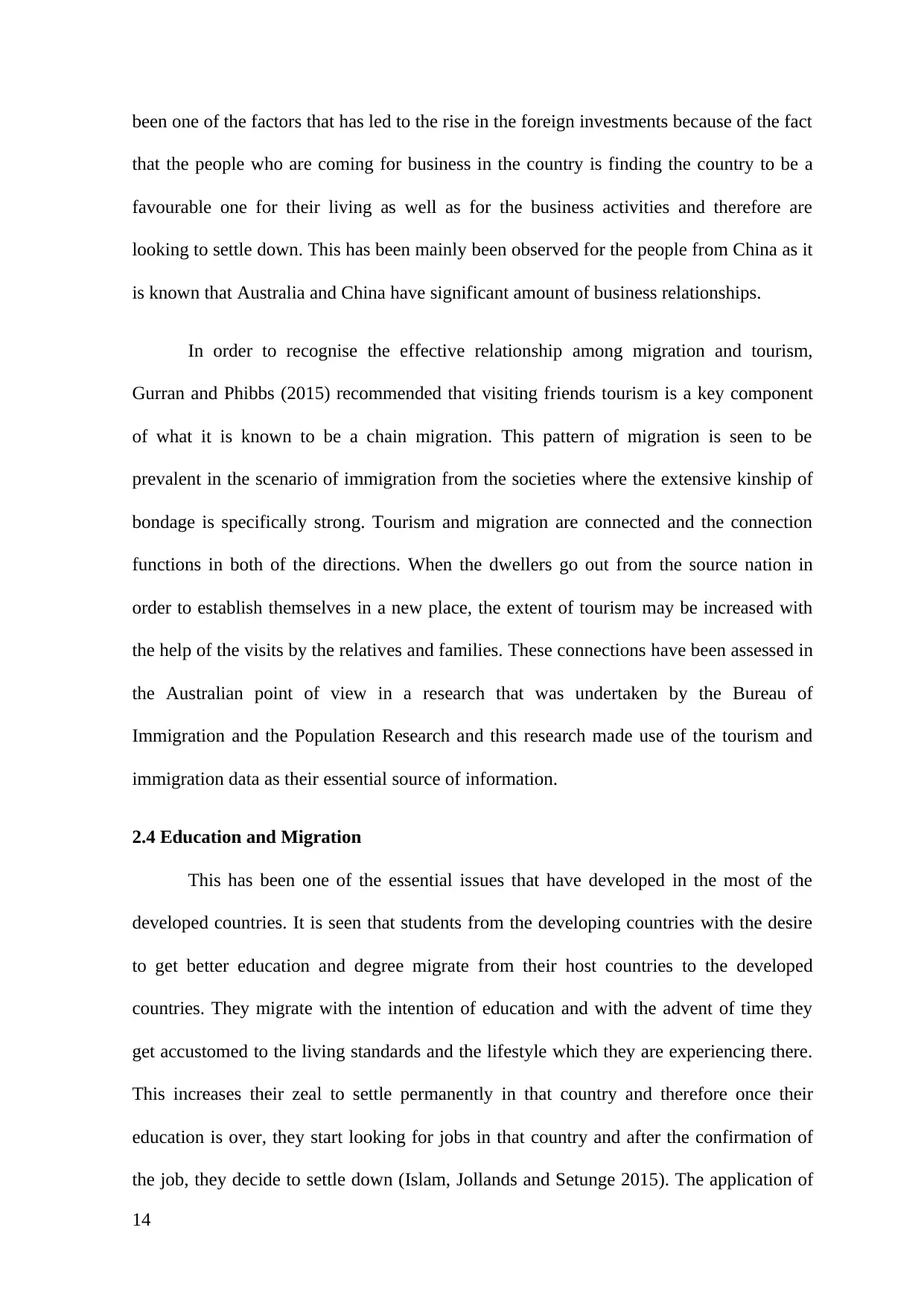
been one of the factors that has led to the rise in the foreign investments because of the fact
that the people who are coming for business in the country is finding the country to be a
favourable one for their living as well as for the business activities and therefore are
looking to settle down. This has been mainly been observed for the people from China as it
is known that Australia and China have significant amount of business relationships.
In order to recognise the effective relationship among migration and tourism,
Gurran and Phibbs (2015) recommended that visiting friends tourism is a key component
of what it is known to be a chain migration. This pattern of migration is seen to be
prevalent in the scenario of immigration from the societies where the extensive kinship of
bondage is specifically strong. Tourism and migration are connected and the connection
functions in both of the directions. When the dwellers go out from the source nation in
order to establish themselves in a new place, the extent of tourism may be increased with
the help of the visits by the relatives and families. These connections have been assessed in
the Australian point of view in a research that was undertaken by the Bureau of
Immigration and the Population Research and this research made use of the tourism and
immigration data as their essential source of information.
2.4 Education and Migration
This has been one of the essential issues that have developed in the most of the
developed countries. It is seen that students from the developing countries with the desire
to get better education and degree migrate from their host countries to the developed
countries. They migrate with the intention of education and with the advent of time they
get accustomed to the living standards and the lifestyle which they are experiencing there.
This increases their zeal to settle permanently in that country and therefore once their
education is over, they start looking for jobs in that country and after the confirmation of
the job, they decide to settle down (Islam, Jollands and Setunge 2015). The application of
14
that the people who are coming for business in the country is finding the country to be a
favourable one for their living as well as for the business activities and therefore are
looking to settle down. This has been mainly been observed for the people from China as it
is known that Australia and China have significant amount of business relationships.
In order to recognise the effective relationship among migration and tourism,
Gurran and Phibbs (2015) recommended that visiting friends tourism is a key component
of what it is known to be a chain migration. This pattern of migration is seen to be
prevalent in the scenario of immigration from the societies where the extensive kinship of
bondage is specifically strong. Tourism and migration are connected and the connection
functions in both of the directions. When the dwellers go out from the source nation in
order to establish themselves in a new place, the extent of tourism may be increased with
the help of the visits by the relatives and families. These connections have been assessed in
the Australian point of view in a research that was undertaken by the Bureau of
Immigration and the Population Research and this research made use of the tourism and
immigration data as their essential source of information.
2.4 Education and Migration
This has been one of the essential issues that have developed in the most of the
developed countries. It is seen that students from the developing countries with the desire
to get better education and degree migrate from their host countries to the developed
countries. They migrate with the intention of education and with the advent of time they
get accustomed to the living standards and the lifestyle which they are experiencing there.
This increases their zeal to settle permanently in that country and therefore once their
education is over, they start looking for jobs in that country and after the confirmation of
the job, they decide to settle down (Islam, Jollands and Setunge 2015). The application of
14
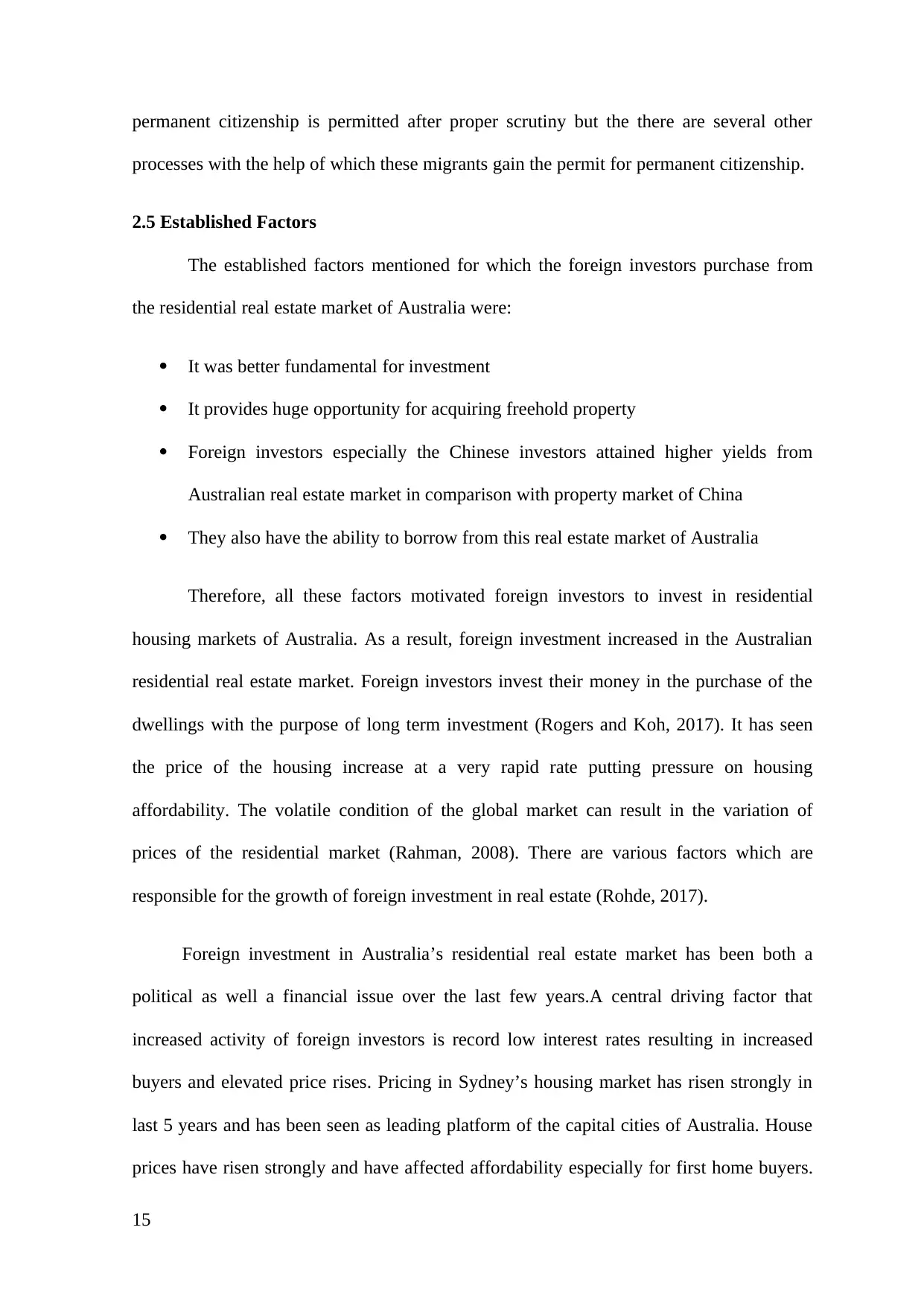
permanent citizenship is permitted after proper scrutiny but the there are several other
processes with the help of which these migrants gain the permit for permanent citizenship.
2.5 Established Factors
The established factors mentioned for which the foreign investors purchase from
the residential real estate market of Australia were:
It was better fundamental for investment
It provides huge opportunity for acquiring freehold property
Foreign investors especially the Chinese investors attained higher yields from
Australian real estate market in comparison with property market of China
They also have the ability to borrow from this real estate market of Australia
Therefore, all these factors motivated foreign investors to invest in residential
housing markets of Australia. As a result, foreign investment increased in the Australian
residential real estate market. Foreign investors invest their money in the purchase of the
dwellings with the purpose of long term investment (Rogers and Koh, 2017). It has seen
the price of the housing increase at a very rapid rate putting pressure on housing
affordability. The volatile condition of the global market can result in the variation of
prices of the residential market (Rahman, 2008). There are various factors which are
responsible for the growth of foreign investment in real estate (Rohde, 2017).
Foreign investment in Australia’s residential real estate market has been both a
political as well a financial issue over the last few years.A central driving factor that
increased activity of foreign investors is record low interest rates resulting in increased
buyers and elevated price rises. Pricing in Sydney’s housing market has risen strongly in
last 5 years and has been seen as leading platform of the capital cities of Australia. House
prices have risen strongly and have affected affordability especially for first home buyers.
15
processes with the help of which these migrants gain the permit for permanent citizenship.
2.5 Established Factors
The established factors mentioned for which the foreign investors purchase from
the residential real estate market of Australia were:
It was better fundamental for investment
It provides huge opportunity for acquiring freehold property
Foreign investors especially the Chinese investors attained higher yields from
Australian real estate market in comparison with property market of China
They also have the ability to borrow from this real estate market of Australia
Therefore, all these factors motivated foreign investors to invest in residential
housing markets of Australia. As a result, foreign investment increased in the Australian
residential real estate market. Foreign investors invest their money in the purchase of the
dwellings with the purpose of long term investment (Rogers and Koh, 2017). It has seen
the price of the housing increase at a very rapid rate putting pressure on housing
affordability. The volatile condition of the global market can result in the variation of
prices of the residential market (Rahman, 2008). There are various factors which are
responsible for the growth of foreign investment in real estate (Rohde, 2017).
Foreign investment in Australia’s residential real estate market has been both a
political as well a financial issue over the last few years.A central driving factor that
increased activity of foreign investors is record low interest rates resulting in increased
buyers and elevated price rises. Pricing in Sydney’s housing market has risen strongly in
last 5 years and has been seen as leading platform of the capital cities of Australia. House
prices have risen strongly and have affected affordability especially for first home buyers.
15
Secure Best Marks with AI Grader
Need help grading? Try our AI Grader for instant feedback on your assignments.
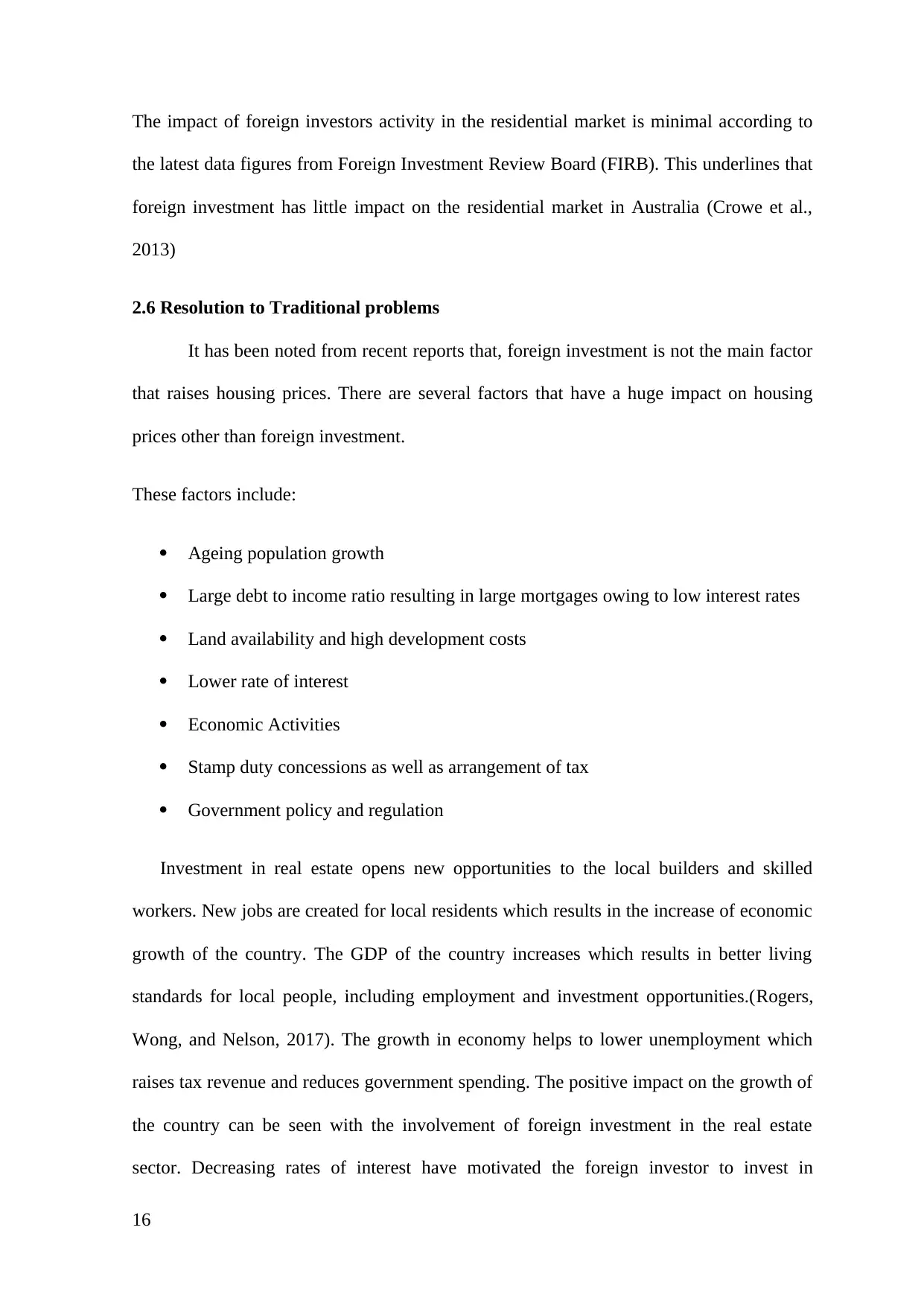
The impact of foreign investors activity in the residential market is minimal according to
the latest data figures from Foreign Investment Review Board (FIRB). This underlines that
foreign investment has little impact on the residential market in Australia (Crowe et al.,
2013)
2.6 Resolution to Traditional problems
It has been noted from recent reports that, foreign investment is not the main factor
that raises housing prices. There are several factors that have a huge impact on housing
prices other than foreign investment.
These factors include:
Ageing population growth
Large debt to income ratio resulting in large mortgages owing to low interest rates
Land availability and high development costs
Lower rate of interest
Economic Activities
Stamp duty concessions as well as arrangement of tax
Government policy and regulation
Investment in real estate opens new opportunities to the local builders and skilled
workers. New jobs are created for local residents which results in the increase of economic
growth of the country. The GDP of the country increases which results in better living
standards for local people, including employment and investment opportunities.(Rogers,
Wong, and Nelson, 2017). The growth in economy helps to lower unemployment which
raises tax revenue and reduces government spending. The positive impact on the growth of
the country can be seen with the involvement of foreign investment in the real estate
sector. Decreasing rates of interest have motivated the foreign investor to invest in
16
the latest data figures from Foreign Investment Review Board (FIRB). This underlines that
foreign investment has little impact on the residential market in Australia (Crowe et al.,
2013)
2.6 Resolution to Traditional problems
It has been noted from recent reports that, foreign investment is not the main factor
that raises housing prices. There are several factors that have a huge impact on housing
prices other than foreign investment.
These factors include:
Ageing population growth
Large debt to income ratio resulting in large mortgages owing to low interest rates
Land availability and high development costs
Lower rate of interest
Economic Activities
Stamp duty concessions as well as arrangement of tax
Government policy and regulation
Investment in real estate opens new opportunities to the local builders and skilled
workers. New jobs are created for local residents which results in the increase of economic
growth of the country. The GDP of the country increases which results in better living
standards for local people, including employment and investment opportunities.(Rogers,
Wong, and Nelson, 2017). The growth in economy helps to lower unemployment which
raises tax revenue and reduces government spending. The positive impact on the growth of
the country can be seen with the involvement of foreign investment in the real estate
sector. Decreasing rates of interest have motivated the foreign investor to invest in
16
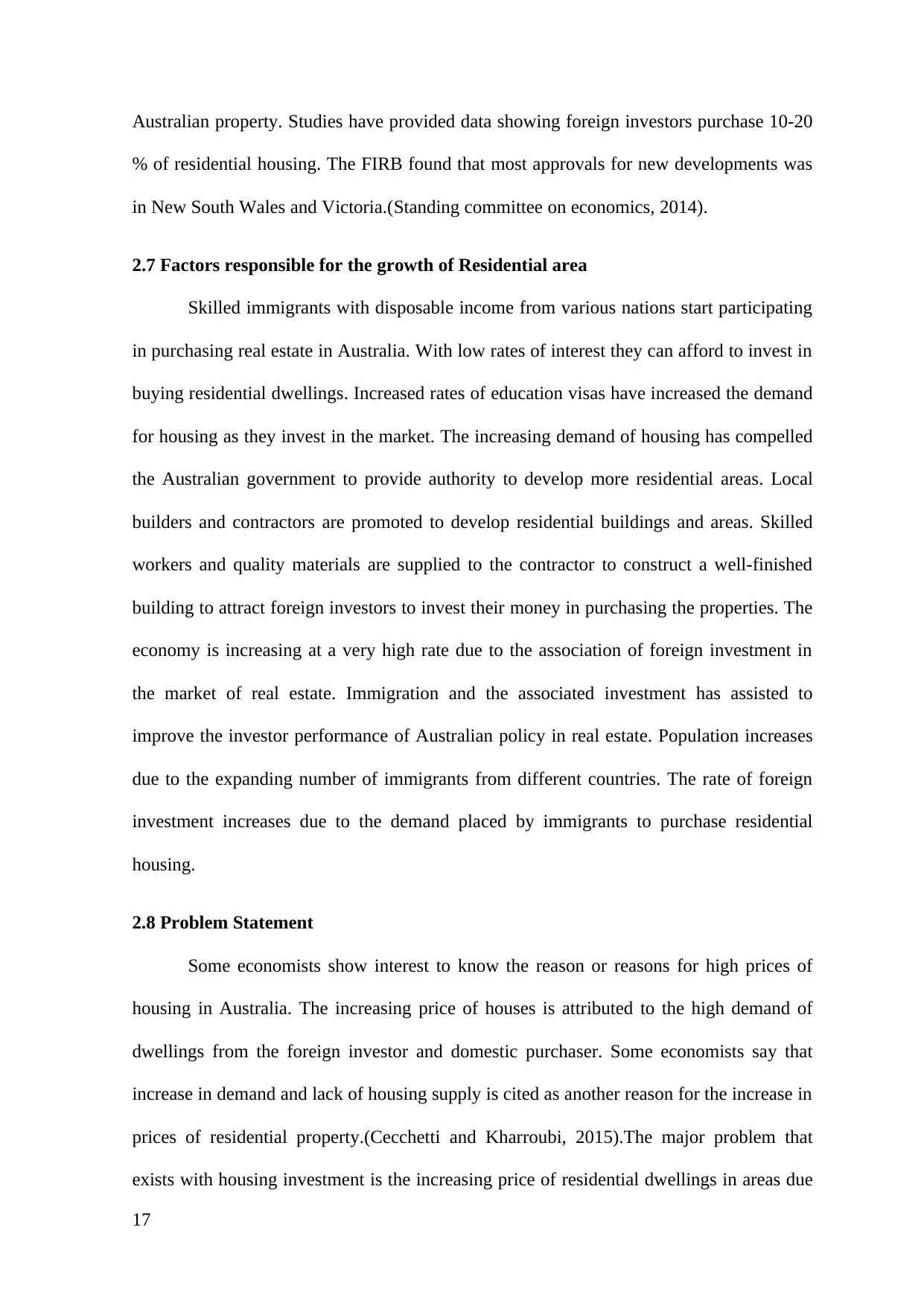
Australian property. Studies have provided data showing foreign investors purchase 10-20
% of residential housing. The FIRB found that most approvals for new developments was
in New South Wales and Victoria.(Standing committee on economics, 2014).
2.7 Factors responsible for the growth of Residential area
Skilled immigrants with disposable income from various nations start participating
in purchasing real estate in Australia. With low rates of interest they can afford to invest in
buying residential dwellings. Increased rates of education visas have increased the demand
for housing as they invest in the market. The increasing demand of housing has compelled
the Australian government to provide authority to develop more residential areas. Local
builders and contractors are promoted to develop residential buildings and areas. Skilled
workers and quality materials are supplied to the contractor to construct a well-finished
building to attract foreign investors to invest their money in purchasing the properties. The
economy is increasing at a very high rate due to the association of foreign investment in
the market of real estate. Immigration and the associated investment has assisted to
improve the investor performance of Australian policy in real estate. Population increases
due to the expanding number of immigrants from different countries. The rate of foreign
investment increases due to the demand placed by immigrants to purchase residential
housing.
2.8 Problem Statement
Some economists show interest to know the reason or reasons for high prices of
housing in Australia. The increasing price of houses is attributed to the high demand of
dwellings from the foreign investor and domestic purchaser. Some economists say that
increase in demand and lack of housing supply is cited as another reason for the increase in
prices of residential property.(Cecchetti and Kharroubi, 2015).The major problem that
exists with housing investment is the increasing price of residential dwellings in areas due
17
% of residential housing. The FIRB found that most approvals for new developments was
in New South Wales and Victoria.(Standing committee on economics, 2014).
2.7 Factors responsible for the growth of Residential area
Skilled immigrants with disposable income from various nations start participating
in purchasing real estate in Australia. With low rates of interest they can afford to invest in
buying residential dwellings. Increased rates of education visas have increased the demand
for housing as they invest in the market. The increasing demand of housing has compelled
the Australian government to provide authority to develop more residential areas. Local
builders and contractors are promoted to develop residential buildings and areas. Skilled
workers and quality materials are supplied to the contractor to construct a well-finished
building to attract foreign investors to invest their money in purchasing the properties. The
economy is increasing at a very high rate due to the association of foreign investment in
the market of real estate. Immigration and the associated investment has assisted to
improve the investor performance of Australian policy in real estate. Population increases
due to the expanding number of immigrants from different countries. The rate of foreign
investment increases due to the demand placed by immigrants to purchase residential
housing.
2.8 Problem Statement
Some economists show interest to know the reason or reasons for high prices of
housing in Australia. The increasing price of houses is attributed to the high demand of
dwellings from the foreign investor and domestic purchaser. Some economists say that
increase in demand and lack of housing supply is cited as another reason for the increase in
prices of residential property.(Cecchetti and Kharroubi, 2015).The major problem that
exists with housing investment is the increasing price of residential dwellings in areas due
17
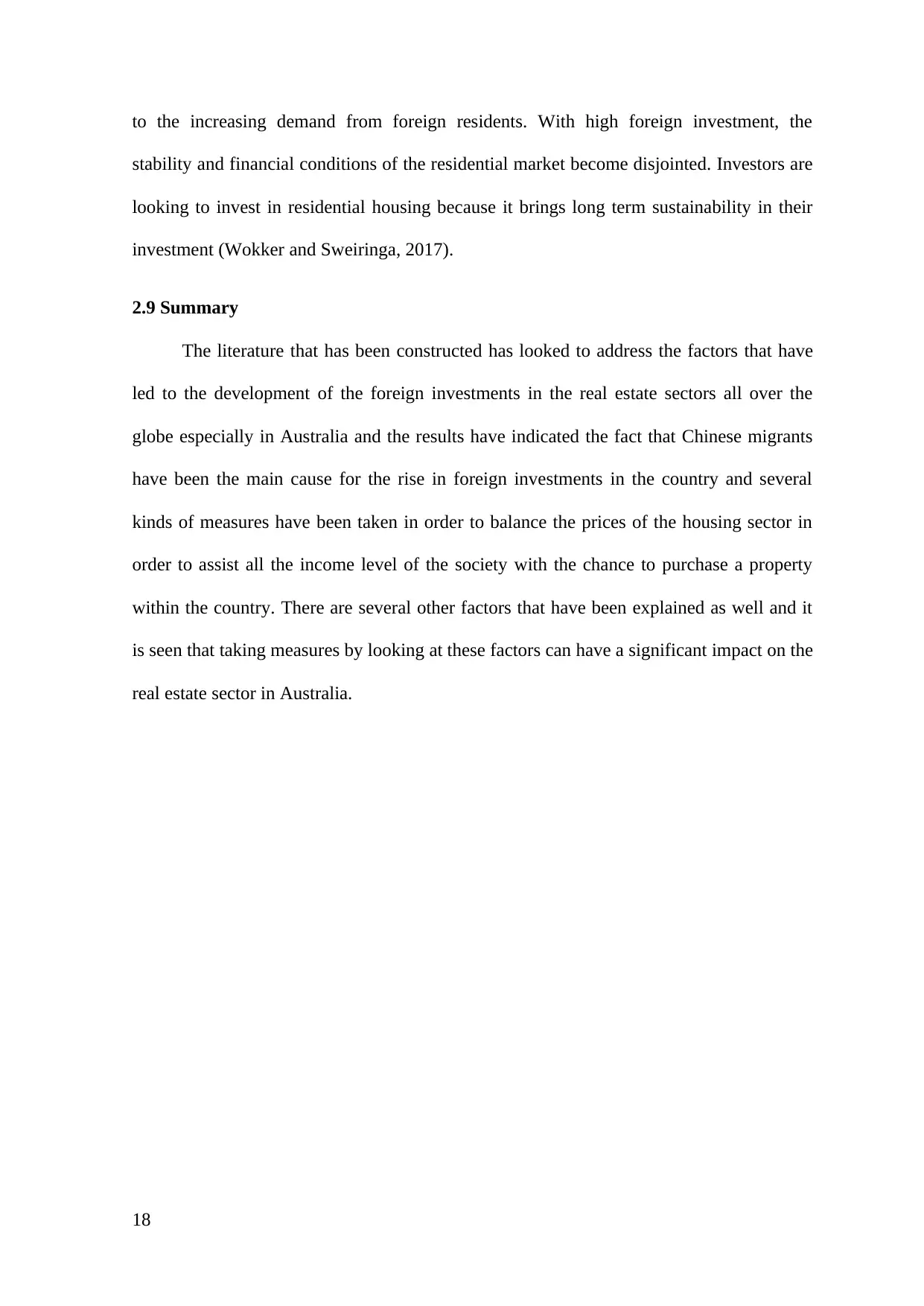
to the increasing demand from foreign residents. With high foreign investment, the
stability and financial conditions of the residential market become disjointed. Investors are
looking to invest in residential housing because it brings long term sustainability in their
investment (Wokker and Sweiringa, 2017).
2.9 Summary
The literature that has been constructed has looked to address the factors that have
led to the development of the foreign investments in the real estate sectors all over the
globe especially in Australia and the results have indicated the fact that Chinese migrants
have been the main cause for the rise in foreign investments in the country and several
kinds of measures have been taken in order to balance the prices of the housing sector in
order to assist all the income level of the society with the chance to purchase a property
within the country. There are several other factors that have been explained as well and it
is seen that taking measures by looking at these factors can have a significant impact on the
real estate sector in Australia.
18
stability and financial conditions of the residential market become disjointed. Investors are
looking to invest in residential housing because it brings long term sustainability in their
investment (Wokker and Sweiringa, 2017).
2.9 Summary
The literature that has been constructed has looked to address the factors that have
led to the development of the foreign investments in the real estate sectors all over the
globe especially in Australia and the results have indicated the fact that Chinese migrants
have been the main cause for the rise in foreign investments in the country and several
kinds of measures have been taken in order to balance the prices of the housing sector in
order to assist all the income level of the society with the chance to purchase a property
within the country. There are several other factors that have been explained as well and it
is seen that taking measures by looking at these factors can have a significant impact on the
real estate sector in Australia.
18
Paraphrase This Document
Need a fresh take? Get an instant paraphrase of this document with our AI Paraphraser
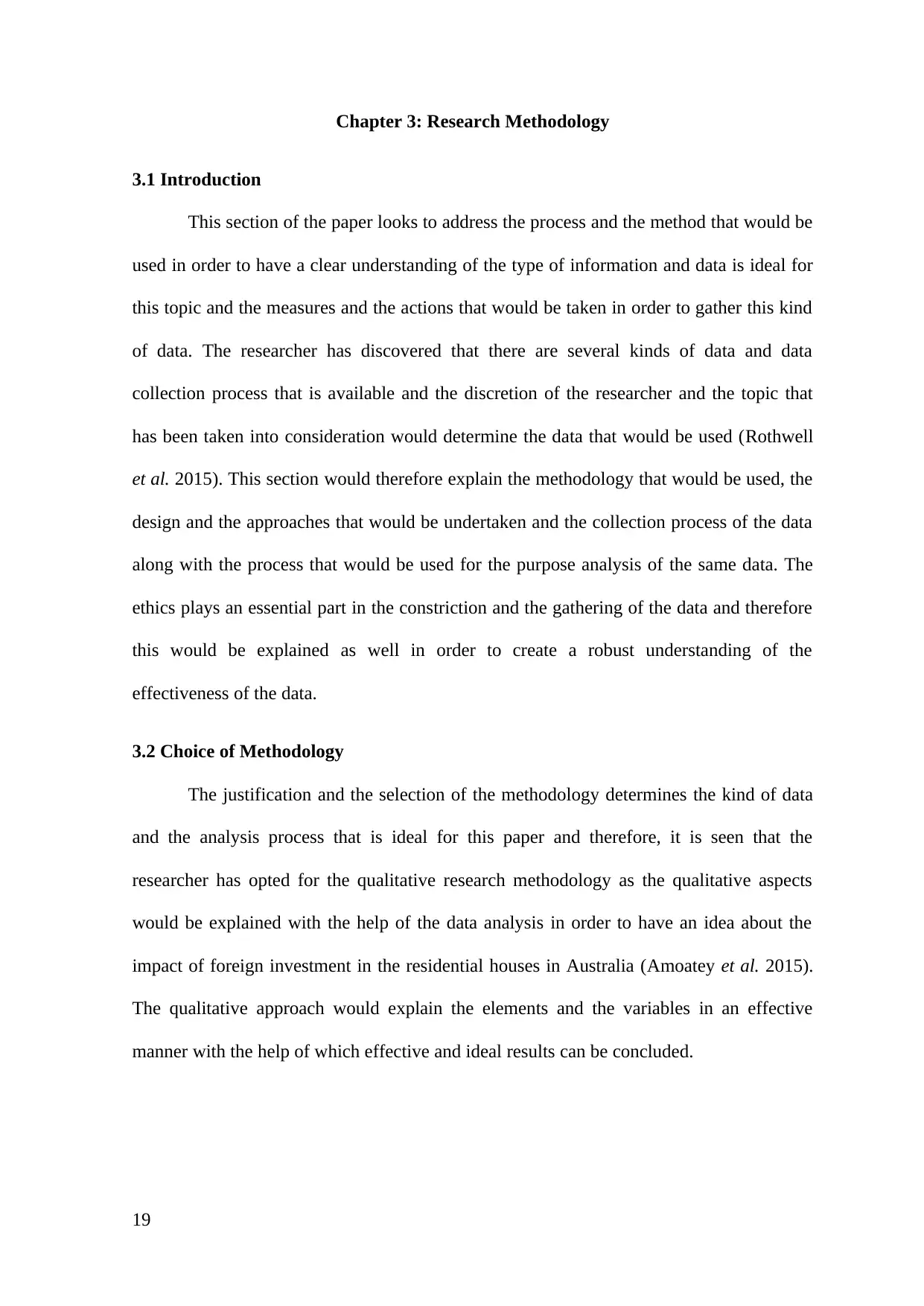
Chapter 3: Research Methodology
3.1 Introduction
This section of the paper looks to address the process and the method that would be
used in order to have a clear understanding of the type of information and data is ideal for
this topic and the measures and the actions that would be taken in order to gather this kind
of data. The researcher has discovered that there are several kinds of data and data
collection process that is available and the discretion of the researcher and the topic that
has been taken into consideration would determine the data that would be used (Rothwell
et al. 2015). This section would therefore explain the methodology that would be used, the
design and the approaches that would be undertaken and the collection process of the data
along with the process that would be used for the purpose analysis of the same data. The
ethics plays an essential part in the constriction and the gathering of the data and therefore
this would be explained as well in order to create a robust understanding of the
effectiveness of the data.
3.2 Choice of Methodology
The justification and the selection of the methodology determines the kind of data
and the analysis process that is ideal for this paper and therefore, it is seen that the
researcher has opted for the qualitative research methodology as the qualitative aspects
would be explained with the help of the data analysis in order to have an idea about the
impact of foreign investment in the residential houses in Australia (Amoatey et al. 2015).
The qualitative approach would explain the elements and the variables in an effective
manner with the help of which effective and ideal results can be concluded.
19
3.1 Introduction
This section of the paper looks to address the process and the method that would be
used in order to have a clear understanding of the type of information and data is ideal for
this topic and the measures and the actions that would be taken in order to gather this kind
of data. The researcher has discovered that there are several kinds of data and data
collection process that is available and the discretion of the researcher and the topic that
has been taken into consideration would determine the data that would be used (Rothwell
et al. 2015). This section would therefore explain the methodology that would be used, the
design and the approaches that would be undertaken and the collection process of the data
along with the process that would be used for the purpose analysis of the same data. The
ethics plays an essential part in the constriction and the gathering of the data and therefore
this would be explained as well in order to create a robust understanding of the
effectiveness of the data.
3.2 Choice of Methodology
The justification and the selection of the methodology determines the kind of data
and the analysis process that is ideal for this paper and therefore, it is seen that the
researcher has opted for the qualitative research methodology as the qualitative aspects
would be explained with the help of the data analysis in order to have an idea about the
impact of foreign investment in the residential houses in Australia (Amoatey et al. 2015).
The qualitative approach would explain the elements and the variables in an effective
manner with the help of which effective and ideal results can be concluded.
19
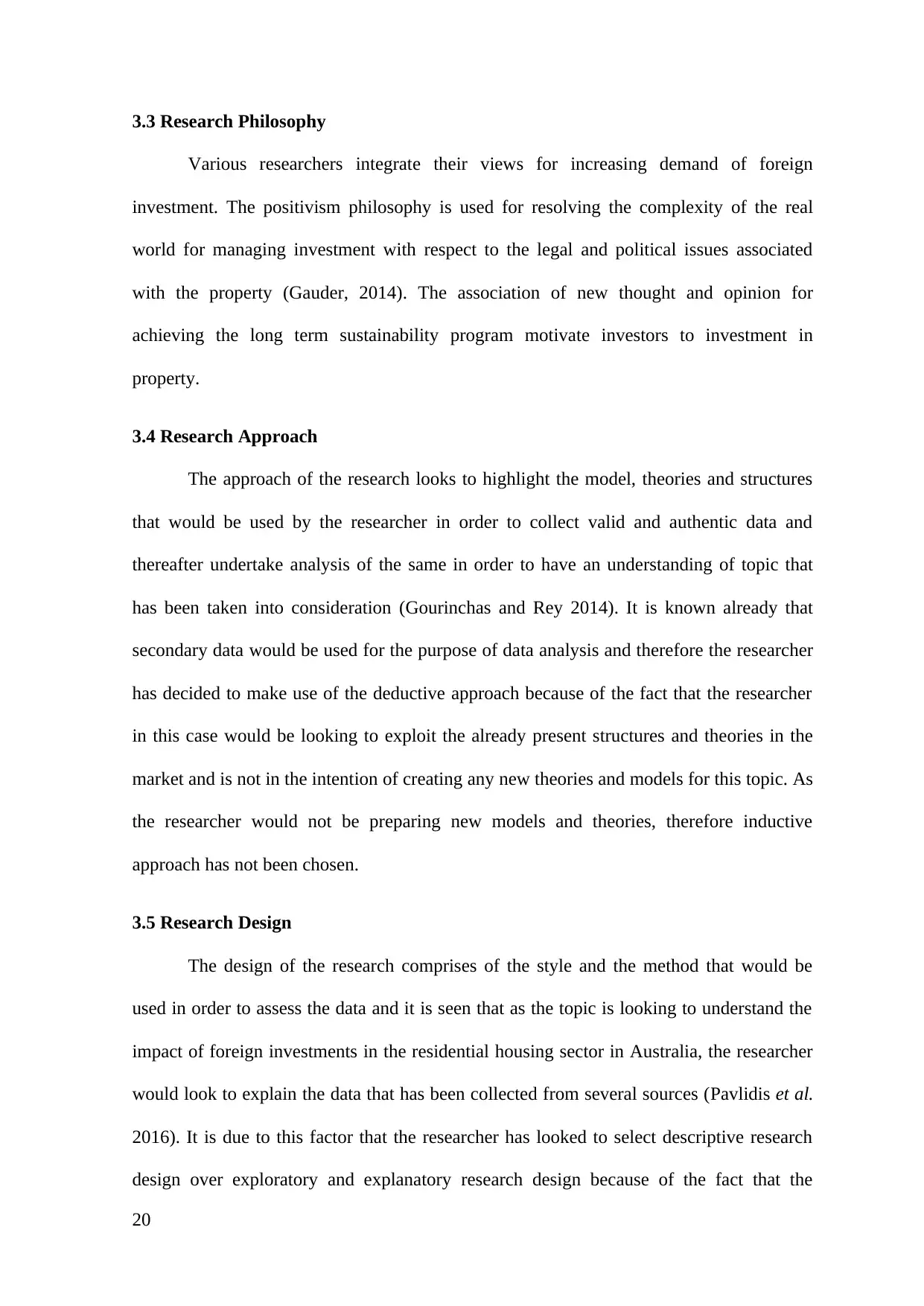
3.3 Research Philosophy
Various researchers integrate their views for increasing demand of foreign
investment. The positivism philosophy is used for resolving the complexity of the real
world for managing investment with respect to the legal and political issues associated
with the property (Gauder, 2014). The association of new thought and opinion for
achieving the long term sustainability program motivate investors to investment in
property.
3.4 Research Approach
The approach of the research looks to highlight the model, theories and structures
that would be used by the researcher in order to collect valid and authentic data and
thereafter undertake analysis of the same in order to have an understanding of topic that
has been taken into consideration (Gourinchas and Rey 2014). It is known already that
secondary data would be used for the purpose of data analysis and therefore the researcher
has decided to make use of the deductive approach because of the fact that the researcher
in this case would be looking to exploit the already present structures and theories in the
market and is not in the intention of creating any new theories and models for this topic. As
the researcher would not be preparing new models and theories, therefore inductive
approach has not been chosen.
3.5 Research Design
The design of the research comprises of the style and the method that would be
used in order to assess the data and it is seen that as the topic is looking to understand the
impact of foreign investments in the residential housing sector in Australia, the researcher
would look to explain the data that has been collected from several sources (Pavlidis et al.
2016). It is due to this factor that the researcher has looked to select descriptive research
design over exploratory and explanatory research design because of the fact that the
20
Various researchers integrate their views for increasing demand of foreign
investment. The positivism philosophy is used for resolving the complexity of the real
world for managing investment with respect to the legal and political issues associated
with the property (Gauder, 2014). The association of new thought and opinion for
achieving the long term sustainability program motivate investors to investment in
property.
3.4 Research Approach
The approach of the research looks to highlight the model, theories and structures
that would be used by the researcher in order to collect valid and authentic data and
thereafter undertake analysis of the same in order to have an understanding of topic that
has been taken into consideration (Gourinchas and Rey 2014). It is known already that
secondary data would be used for the purpose of data analysis and therefore the researcher
has decided to make use of the deductive approach because of the fact that the researcher
in this case would be looking to exploit the already present structures and theories in the
market and is not in the intention of creating any new theories and models for this topic. As
the researcher would not be preparing new models and theories, therefore inductive
approach has not been chosen.
3.5 Research Design
The design of the research comprises of the style and the method that would be
used in order to assess the data and it is seen that as the topic is looking to understand the
impact of foreign investments in the residential housing sector in Australia, the researcher
would look to explain the data that has been collected from several sources (Pavlidis et al.
2016). It is due to this factor that the researcher has looked to select descriptive research
design over exploratory and explanatory research design because of the fact that the
20
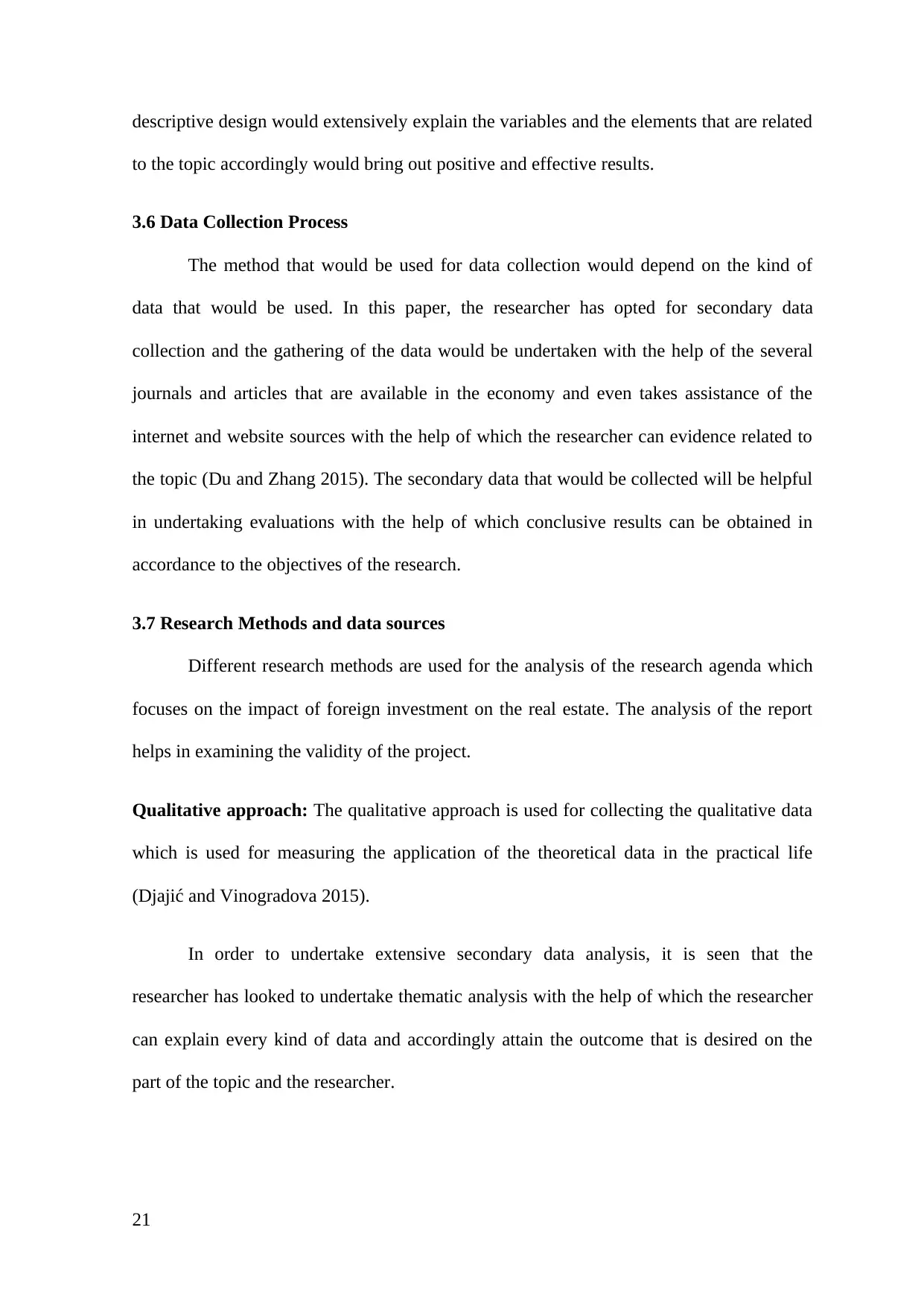
descriptive design would extensively explain the variables and the elements that are related
to the topic accordingly would bring out positive and effective results.
3.6 Data Collection Process
The method that would be used for data collection would depend on the kind of
data that would be used. In this paper, the researcher has opted for secondary data
collection and the gathering of the data would be undertaken with the help of the several
journals and articles that are available in the economy and even takes assistance of the
internet and website sources with the help of which the researcher can evidence related to
the topic (Du and Zhang 2015). The secondary data that would be collected will be helpful
in undertaking evaluations with the help of which conclusive results can be obtained in
accordance to the objectives of the research.
3.7 Research Methods and data sources
Different research methods are used for the analysis of the research agenda which
focuses on the impact of foreign investment on the real estate. The analysis of the report
helps in examining the validity of the project.
Qualitative approach: The qualitative approach is used for collecting the qualitative data
which is used for measuring the application of the theoretical data in the practical life
(Djajić and Vinogradova 2015).
In order to undertake extensive secondary data analysis, it is seen that the
researcher has looked to undertake thematic analysis with the help of which the researcher
can explain every kind of data and accordingly attain the outcome that is desired on the
part of the topic and the researcher.
21
to the topic accordingly would bring out positive and effective results.
3.6 Data Collection Process
The method that would be used for data collection would depend on the kind of
data that would be used. In this paper, the researcher has opted for secondary data
collection and the gathering of the data would be undertaken with the help of the several
journals and articles that are available in the economy and even takes assistance of the
internet and website sources with the help of which the researcher can evidence related to
the topic (Du and Zhang 2015). The secondary data that would be collected will be helpful
in undertaking evaluations with the help of which conclusive results can be obtained in
accordance to the objectives of the research.
3.7 Research Methods and data sources
Different research methods are used for the analysis of the research agenda which
focuses on the impact of foreign investment on the real estate. The analysis of the report
helps in examining the validity of the project.
Qualitative approach: The qualitative approach is used for collecting the qualitative data
which is used for measuring the application of the theoretical data in the practical life
(Djajić and Vinogradova 2015).
In order to undertake extensive secondary data analysis, it is seen that the
researcher has looked to undertake thematic analysis with the help of which the researcher
can explain every kind of data and accordingly attain the outcome that is desired on the
part of the topic and the researcher.
21
Secure Best Marks with AI Grader
Need help grading? Try our AI Grader for instant feedback on your assignments.
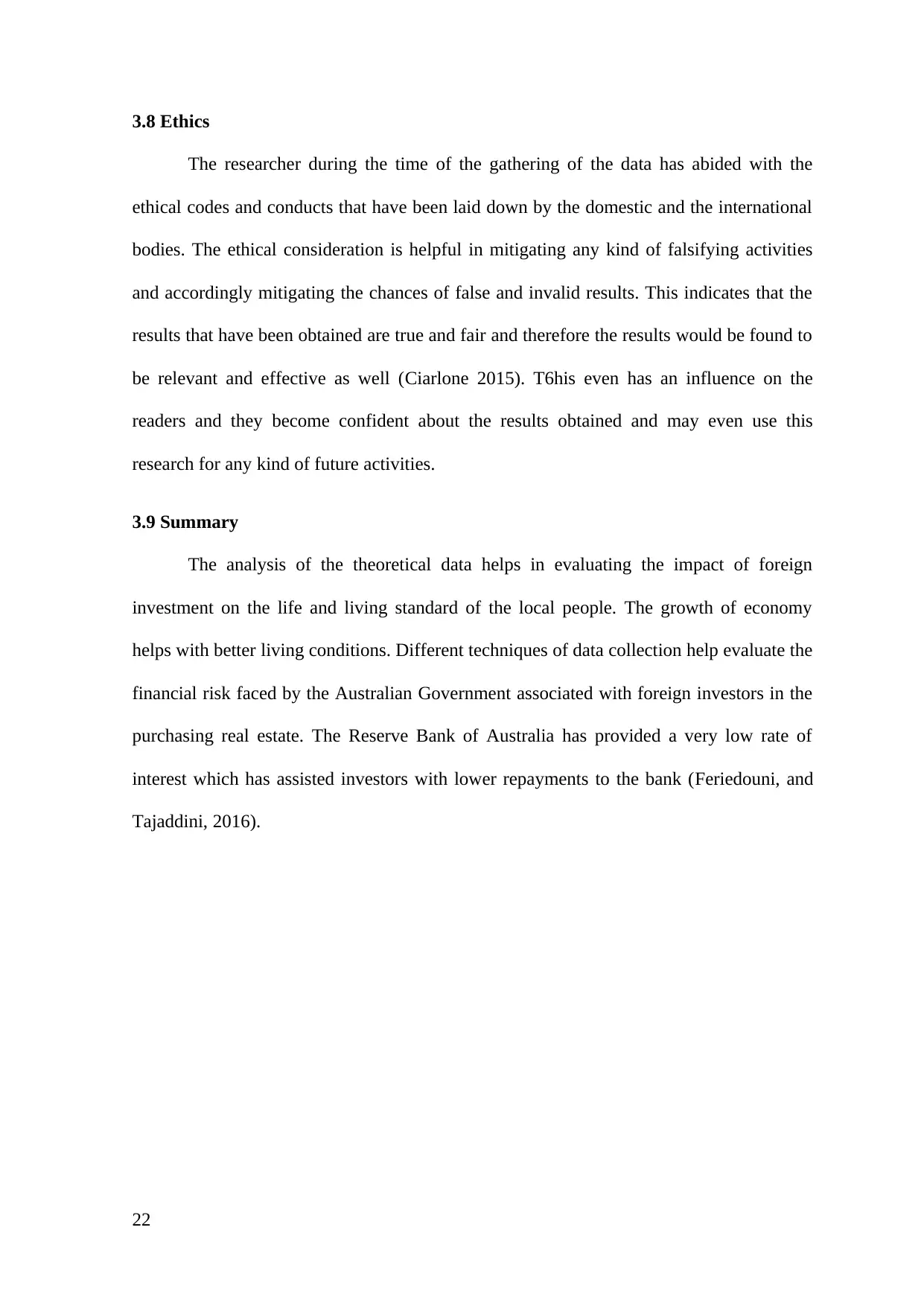
3.8 Ethics
The researcher during the time of the gathering of the data has abided with the
ethical codes and conducts that have been laid down by the domestic and the international
bodies. The ethical consideration is helpful in mitigating any kind of falsifying activities
and accordingly mitigating the chances of false and invalid results. This indicates that the
results that have been obtained are true and fair and therefore the results would be found to
be relevant and effective as well (Ciarlone 2015). T6his even has an influence on the
readers and they become confident about the results obtained and may even use this
research for any kind of future activities.
3.9 Summary
The analysis of the theoretical data helps in evaluating the impact of foreign
investment on the life and living standard of the local people. The growth of economy
helps with better living conditions. Different techniques of data collection help evaluate the
financial risk faced by the Australian Government associated with foreign investors in the
purchasing real estate. The Reserve Bank of Australia has provided a very low rate of
interest which has assisted investors with lower repayments to the bank (Feriedouni, and
Tajaddini, 2016).
22
The researcher during the time of the gathering of the data has abided with the
ethical codes and conducts that have been laid down by the domestic and the international
bodies. The ethical consideration is helpful in mitigating any kind of falsifying activities
and accordingly mitigating the chances of false and invalid results. This indicates that the
results that have been obtained are true and fair and therefore the results would be found to
be relevant and effective as well (Ciarlone 2015). T6his even has an influence on the
readers and they become confident about the results obtained and may even use this
research for any kind of future activities.
3.9 Summary
The analysis of the theoretical data helps in evaluating the impact of foreign
investment on the life and living standard of the local people. The growth of economy
helps with better living conditions. Different techniques of data collection help evaluate the
financial risk faced by the Australian Government associated with foreign investors in the
purchasing real estate. The Reserve Bank of Australia has provided a very low rate of
interest which has assisted investors with lower repayments to the bank (Feriedouni, and
Tajaddini, 2016).
22
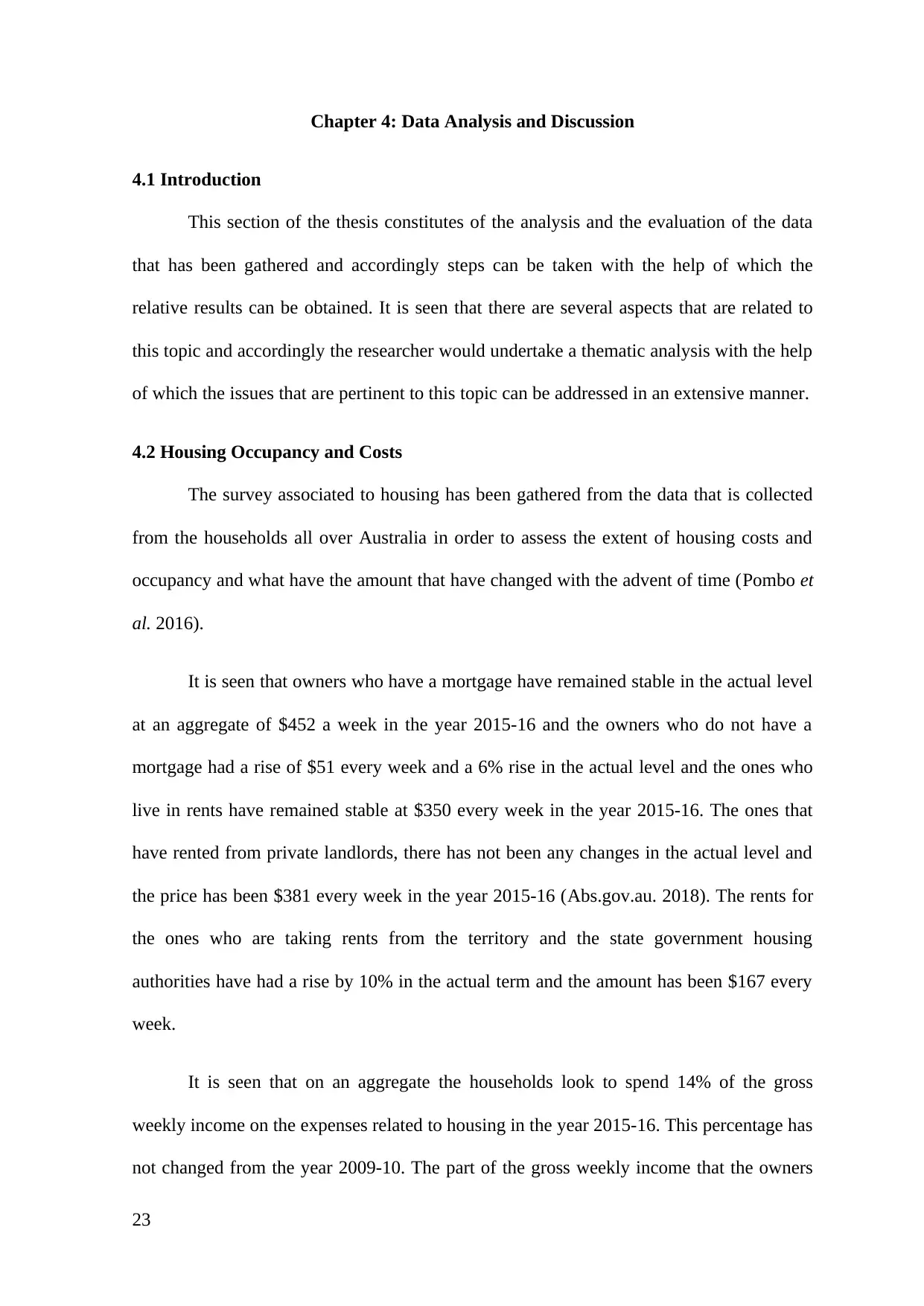
Chapter 4: Data Analysis and Discussion
4.1 Introduction
This section of the thesis constitutes of the analysis and the evaluation of the data
that has been gathered and accordingly steps can be taken with the help of which the
relative results can be obtained. It is seen that there are several aspects that are related to
this topic and accordingly the researcher would undertake a thematic analysis with the help
of which the issues that are pertinent to this topic can be addressed in an extensive manner.
4.2 Housing Occupancy and Costs
The survey associated to housing has been gathered from the data that is collected
from the households all over Australia in order to assess the extent of housing costs and
occupancy and what have the amount that have changed with the advent of time (Pombo et
al. 2016).
It is seen that owners who have a mortgage have remained stable in the actual level
at an aggregate of $452 a week in the year 2015-16 and the owners who do not have a
mortgage had a rise of $51 every week and a 6% rise in the actual level and the ones who
live in rents have remained stable at $350 every week in the year 2015-16. The ones that
have rented from private landlords, there has not been any changes in the actual level and
the price has been $381 every week in the year 2015-16 (Abs.gov.au. 2018). The rents for
the ones who are taking rents from the territory and the state government housing
authorities have had a rise by 10% in the actual term and the amount has been $167 every
week.
It is seen that on an aggregate the households look to spend 14% of the gross
weekly income on the expenses related to housing in the year 2015-16. This percentage has
not changed from the year 2009-10. The part of the gross weekly income that the owners
23
4.1 Introduction
This section of the thesis constitutes of the analysis and the evaluation of the data
that has been gathered and accordingly steps can be taken with the help of which the
relative results can be obtained. It is seen that there are several aspects that are related to
this topic and accordingly the researcher would undertake a thematic analysis with the help
of which the issues that are pertinent to this topic can be addressed in an extensive manner.
4.2 Housing Occupancy and Costs
The survey associated to housing has been gathered from the data that is collected
from the households all over Australia in order to assess the extent of housing costs and
occupancy and what have the amount that have changed with the advent of time (Pombo et
al. 2016).
It is seen that owners who have a mortgage have remained stable in the actual level
at an aggregate of $452 a week in the year 2015-16 and the owners who do not have a
mortgage had a rise of $51 every week and a 6% rise in the actual level and the ones who
live in rents have remained stable at $350 every week in the year 2015-16. The ones that
have rented from private landlords, there has not been any changes in the actual level and
the price has been $381 every week in the year 2015-16 (Abs.gov.au. 2018). The rents for
the ones who are taking rents from the territory and the state government housing
authorities have had a rise by 10% in the actual term and the amount has been $167 every
week.
It is seen that on an aggregate the households look to spend 14% of the gross
weekly income on the expenses related to housing in the year 2015-16. This percentage has
not changed from the year 2009-10. The part of the gross weekly income that the owners
23
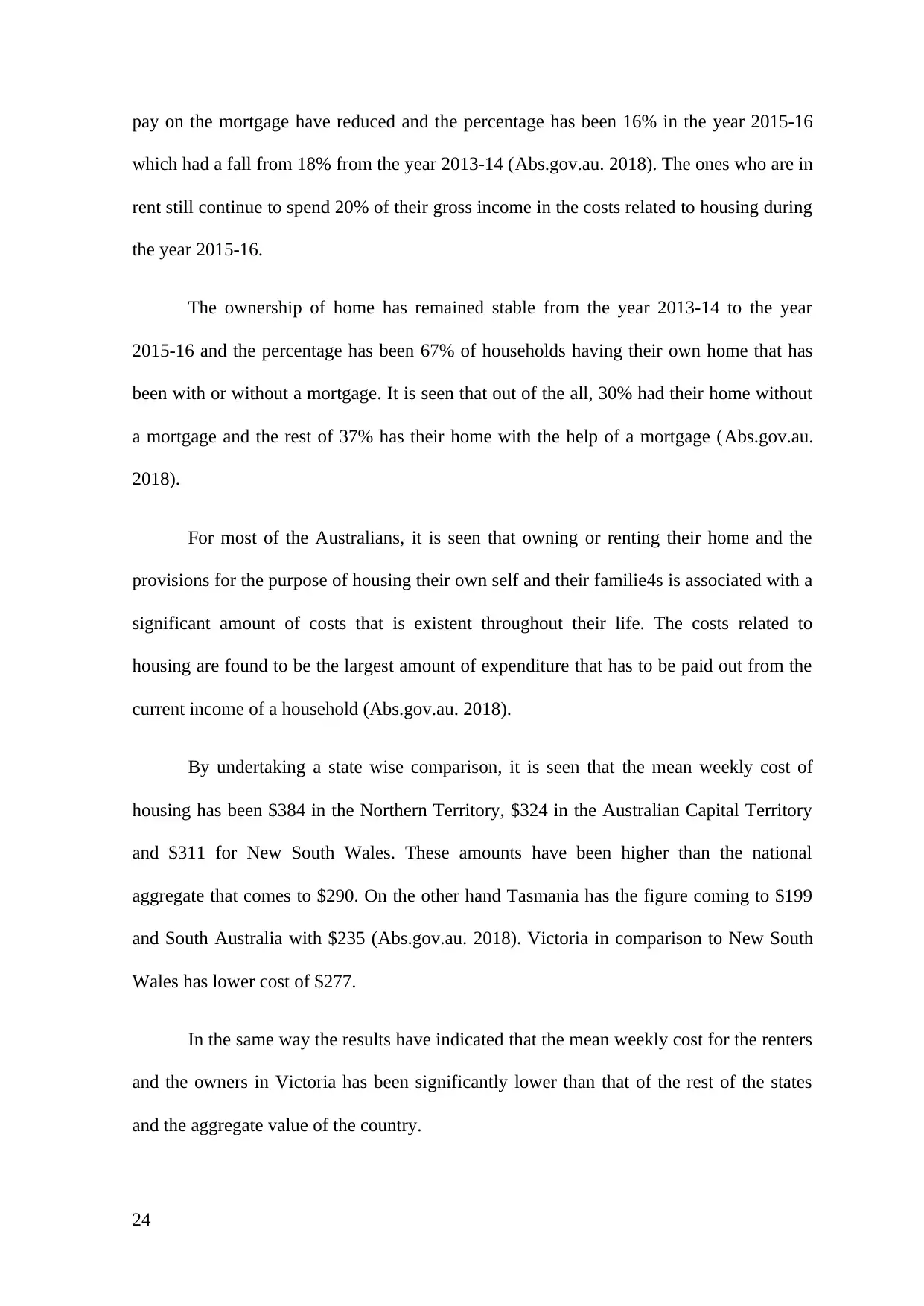
pay on the mortgage have reduced and the percentage has been 16% in the year 2015-16
which had a fall from 18% from the year 2013-14 (Abs.gov.au. 2018). The ones who are in
rent still continue to spend 20% of their gross income in the costs related to housing during
the year 2015-16.
The ownership of home has remained stable from the year 2013-14 to the year
2015-16 and the percentage has been 67% of households having their own home that has
been with or without a mortgage. It is seen that out of the all, 30% had their home without
a mortgage and the rest of 37% has their home with the help of a mortgage (Abs.gov.au.
2018).
For most of the Australians, it is seen that owning or renting their home and the
provisions for the purpose of housing their own self and their familie4s is associated with a
significant amount of costs that is existent throughout their life. The costs related to
housing are found to be the largest amount of expenditure that has to be paid out from the
current income of a household (Abs.gov.au. 2018).
By undertaking a state wise comparison, it is seen that the mean weekly cost of
housing has been $384 in the Northern Territory, $324 in the Australian Capital Territory
and $311 for New South Wales. These amounts have been higher than the national
aggregate that comes to $290. On the other hand Tasmania has the figure coming to $199
and South Australia with $235 (Abs.gov.au. 2018). Victoria in comparison to New South
Wales has lower cost of $277.
In the same way the results have indicated that the mean weekly cost for the renters
and the owners in Victoria has been significantly lower than that of the rest of the states
and the aggregate value of the country.
24
which had a fall from 18% from the year 2013-14 (Abs.gov.au. 2018). The ones who are in
rent still continue to spend 20% of their gross income in the costs related to housing during
the year 2015-16.
The ownership of home has remained stable from the year 2013-14 to the year
2015-16 and the percentage has been 67% of households having their own home that has
been with or without a mortgage. It is seen that out of the all, 30% had their home without
a mortgage and the rest of 37% has their home with the help of a mortgage (Abs.gov.au.
2018).
For most of the Australians, it is seen that owning or renting their home and the
provisions for the purpose of housing their own self and their familie4s is associated with a
significant amount of costs that is existent throughout their life. The costs related to
housing are found to be the largest amount of expenditure that has to be paid out from the
current income of a household (Abs.gov.au. 2018).
By undertaking a state wise comparison, it is seen that the mean weekly cost of
housing has been $384 in the Northern Territory, $324 in the Australian Capital Territory
and $311 for New South Wales. These amounts have been higher than the national
aggregate that comes to $290. On the other hand Tasmania has the figure coming to $199
and South Australia with $235 (Abs.gov.au. 2018). Victoria in comparison to New South
Wales has lower cost of $277.
In the same way the results have indicated that the mean weekly cost for the renters
and the owners in Victoria has been significantly lower than that of the rest of the states
and the aggregate value of the country.
24
Paraphrase This Document
Need a fresh take? Get an instant paraphrase of this document with our AI Paraphraser
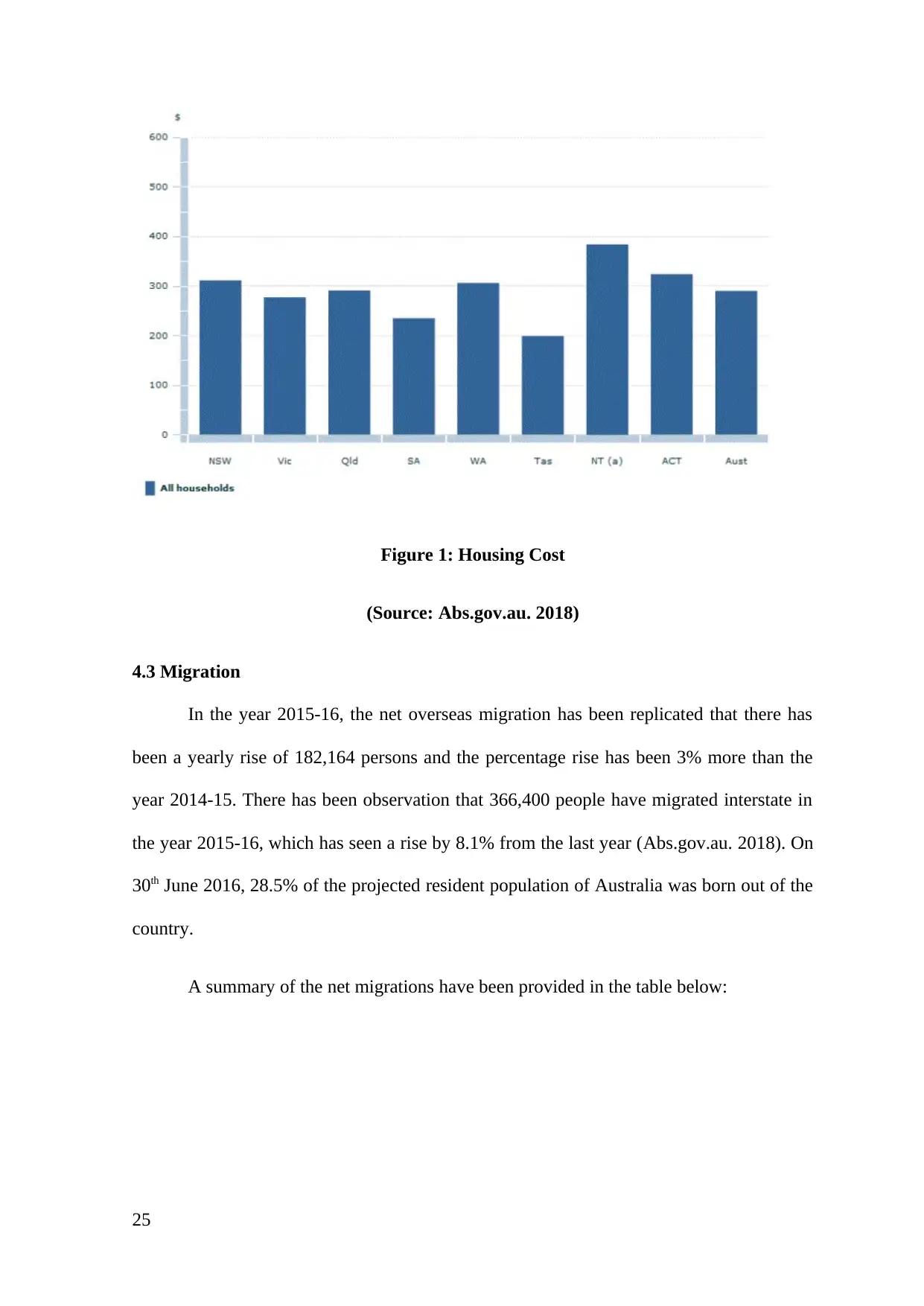
Figure 1: Housing Cost
(Source: Abs.gov.au. 2018)
4.3 Migration
In the year 2015-16, the net overseas migration has been replicated that there has
been a yearly rise of 182,164 persons and the percentage rise has been 3% more than the
year 2014-15. There has been observation that 366,400 people have migrated interstate in
the year 2015-16, which has seen a rise by 8.1% from the last year (Abs.gov.au. 2018). On
30th June 2016, 28.5% of the projected resident population of Australia was born out of the
country.
A summary of the net migrations have been provided in the table below:
25
(Source: Abs.gov.au. 2018)
4.3 Migration
In the year 2015-16, the net overseas migration has been replicated that there has
been a yearly rise of 182,164 persons and the percentage rise has been 3% more than the
year 2014-15. There has been observation that 366,400 people have migrated interstate in
the year 2015-16, which has seen a rise by 8.1% from the last year (Abs.gov.au. 2018). On
30th June 2016, 28.5% of the projected resident population of Australia was born out of the
country.
A summary of the net migrations have been provided in the table below:
25
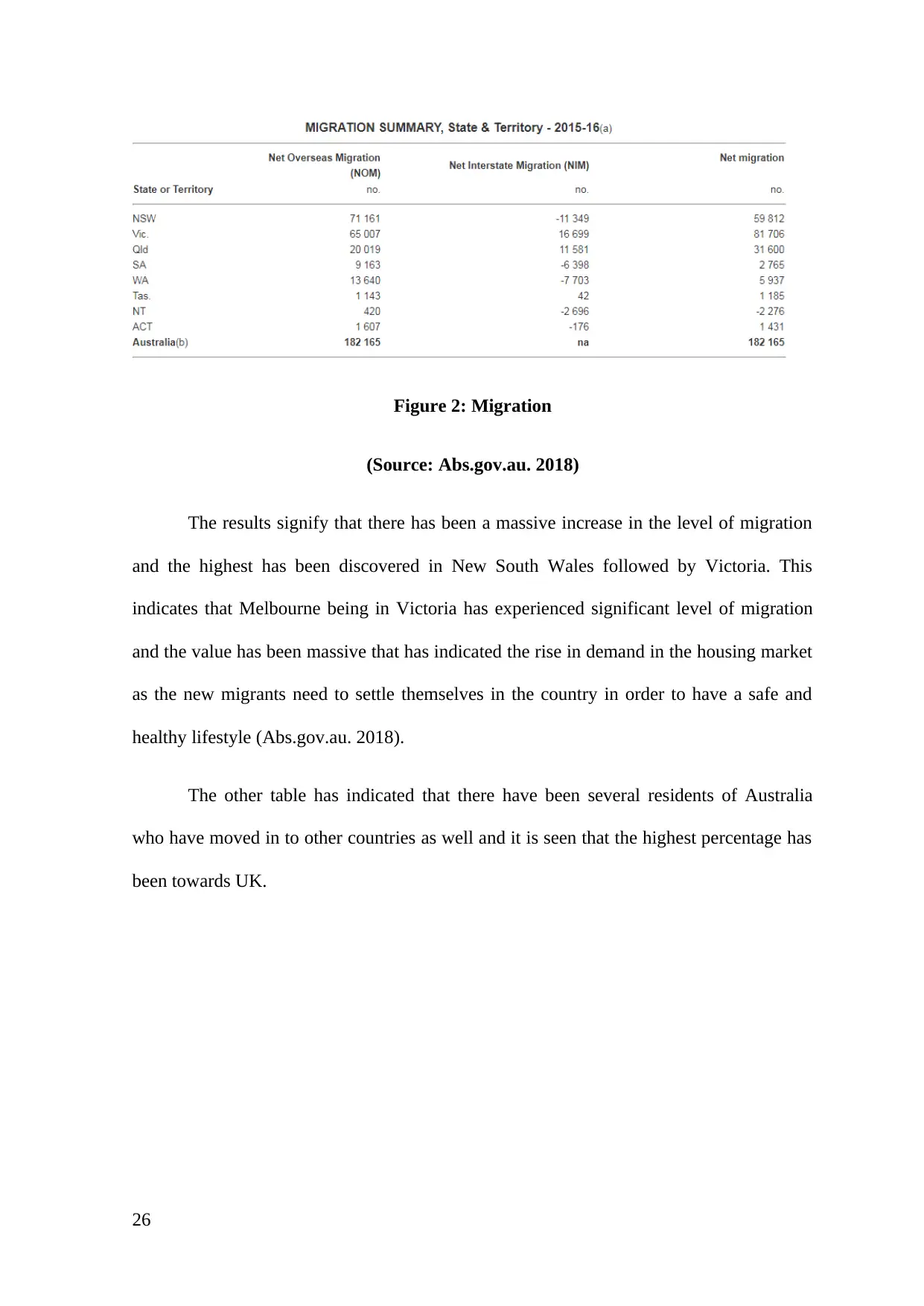
Figure 2: Migration
(Source: Abs.gov.au. 2018)
The results signify that there has been a massive increase in the level of migration
and the highest has been discovered in New South Wales followed by Victoria. This
indicates that Melbourne being in Victoria has experienced significant level of migration
and the value has been massive that has indicated the rise in demand in the housing market
as the new migrants need to settle themselves in the country in order to have a safe and
healthy lifestyle (Abs.gov.au. 2018).
The other table has indicated that there have been several residents of Australia
who have moved in to other countries as well and it is seen that the highest percentage has
been towards UK.
26
(Source: Abs.gov.au. 2018)
The results signify that there has been a massive increase in the level of migration
and the highest has been discovered in New South Wales followed by Victoria. This
indicates that Melbourne being in Victoria has experienced significant level of migration
and the value has been massive that has indicated the rise in demand in the housing market
as the new migrants need to settle themselves in the country in order to have a safe and
healthy lifestyle (Abs.gov.au. 2018).
The other table has indicated that there have been several residents of Australia
who have moved in to other countries as well and it is seen that the highest percentage has
been towards UK.
26
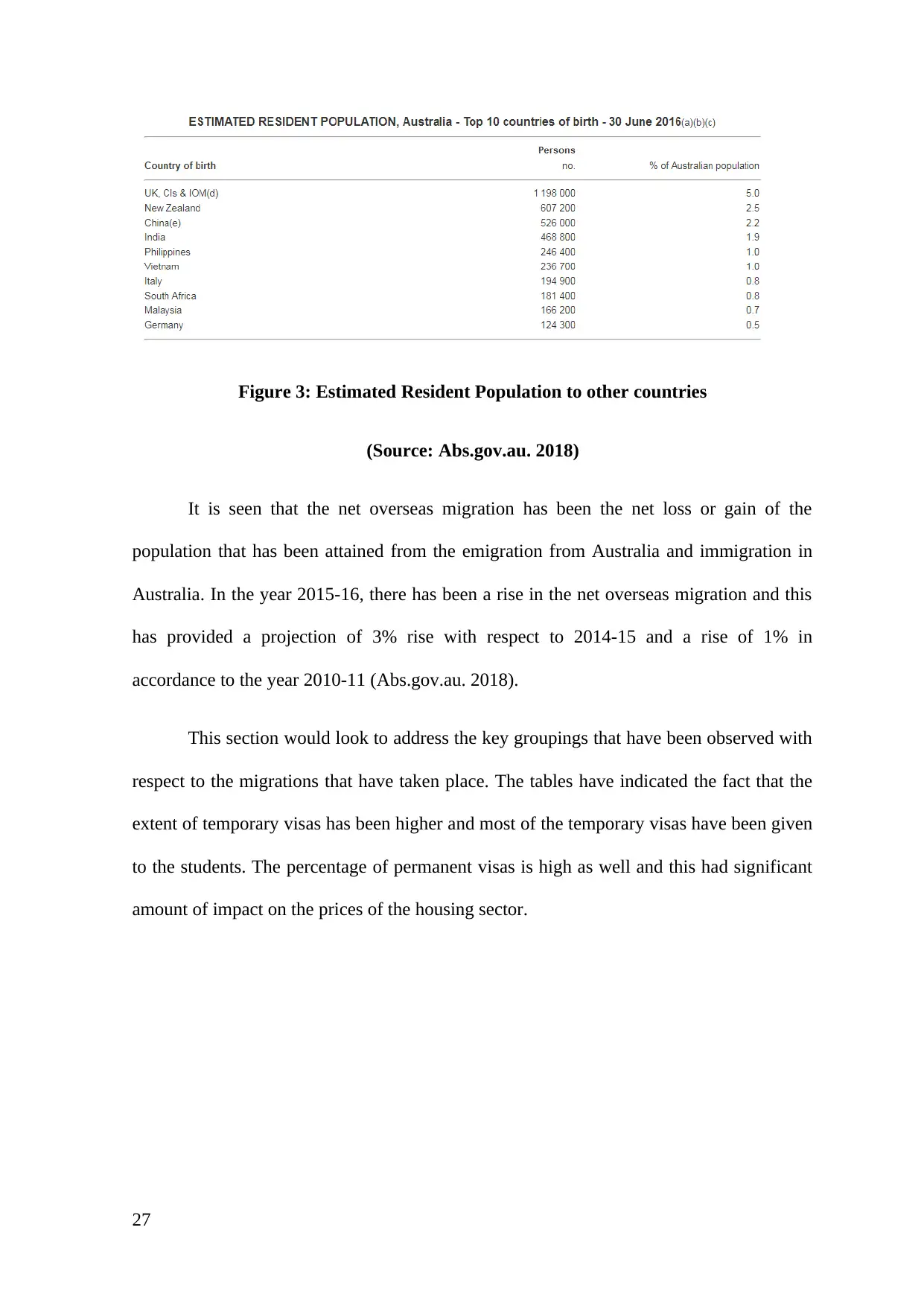
Figure 3: Estimated Resident Population to other countries
(Source: Abs.gov.au. 2018)
It is seen that the net overseas migration has been the net loss or gain of the
population that has been attained from the emigration from Australia and immigration in
Australia. In the year 2015-16, there has been a rise in the net overseas migration and this
has provided a projection of 3% rise with respect to 2014-15 and a rise of 1% in
accordance to the year 2010-11 (Abs.gov.au. 2018).
This section would look to address the key groupings that have been observed with
respect to the migrations that have taken place. The tables have indicated the fact that the
extent of temporary visas has been higher and most of the temporary visas have been given
to the students. The percentage of permanent visas is high as well and this had significant
amount of impact on the prices of the housing sector.
27
(Source: Abs.gov.au. 2018)
It is seen that the net overseas migration has been the net loss or gain of the
population that has been attained from the emigration from Australia and immigration in
Australia. In the year 2015-16, there has been a rise in the net overseas migration and this
has provided a projection of 3% rise with respect to 2014-15 and a rise of 1% in
accordance to the year 2010-11 (Abs.gov.au. 2018).
This section would look to address the key groupings that have been observed with
respect to the migrations that have taken place. The tables have indicated the fact that the
extent of temporary visas has been higher and most of the temporary visas have been given
to the students. The percentage of permanent visas is high as well and this had significant
amount of impact on the prices of the housing sector.
27
Secure Best Marks with AI Grader
Need help grading? Try our AI Grader for instant feedback on your assignments.
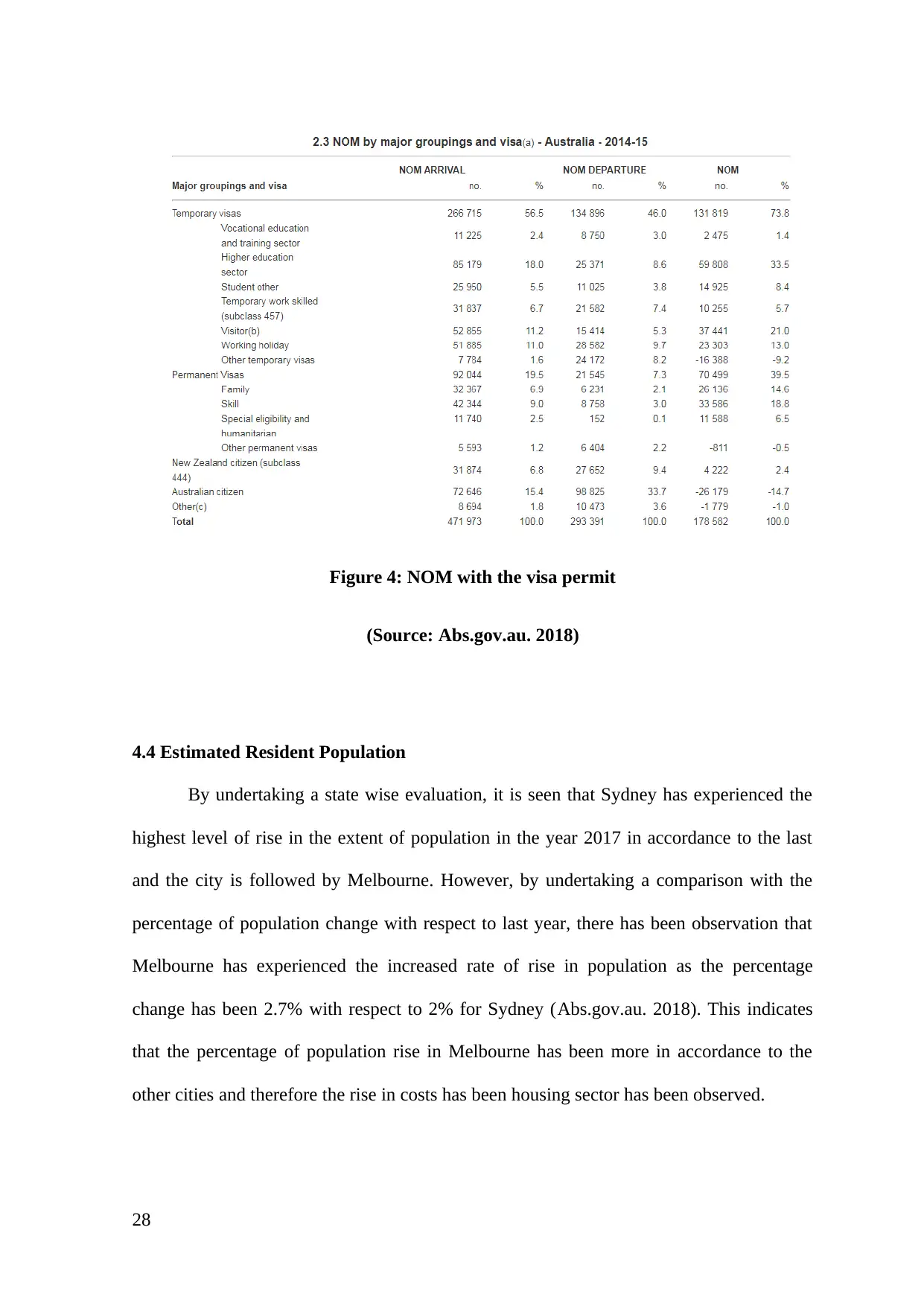
Figure 4: NOM with the visa permit
(Source: Abs.gov.au. 2018)
4.4 Estimated Resident Population
By undertaking a state wise evaluation, it is seen that Sydney has experienced the
highest level of rise in the extent of population in the year 2017 in accordance to the last
and the city is followed by Melbourne. However, by undertaking a comparison with the
percentage of population change with respect to last year, there has been observation that
Melbourne has experienced the increased rate of rise in population as the percentage
change has been 2.7% with respect to 2% for Sydney (Abs.gov.au. 2018). This indicates
that the percentage of population rise in Melbourne has been more in accordance to the
other cities and therefore the rise in costs has been housing sector has been observed.
28
(Source: Abs.gov.au. 2018)
4.4 Estimated Resident Population
By undertaking a state wise evaluation, it is seen that Sydney has experienced the
highest level of rise in the extent of population in the year 2017 in accordance to the last
and the city is followed by Melbourne. However, by undertaking a comparison with the
percentage of population change with respect to last year, there has been observation that
Melbourne has experienced the increased rate of rise in population as the percentage
change has been 2.7% with respect to 2% for Sydney (Abs.gov.au. 2018). This indicates
that the percentage of population rise in Melbourne has been more in accordance to the
other cities and therefore the rise in costs has been housing sector has been observed.
28
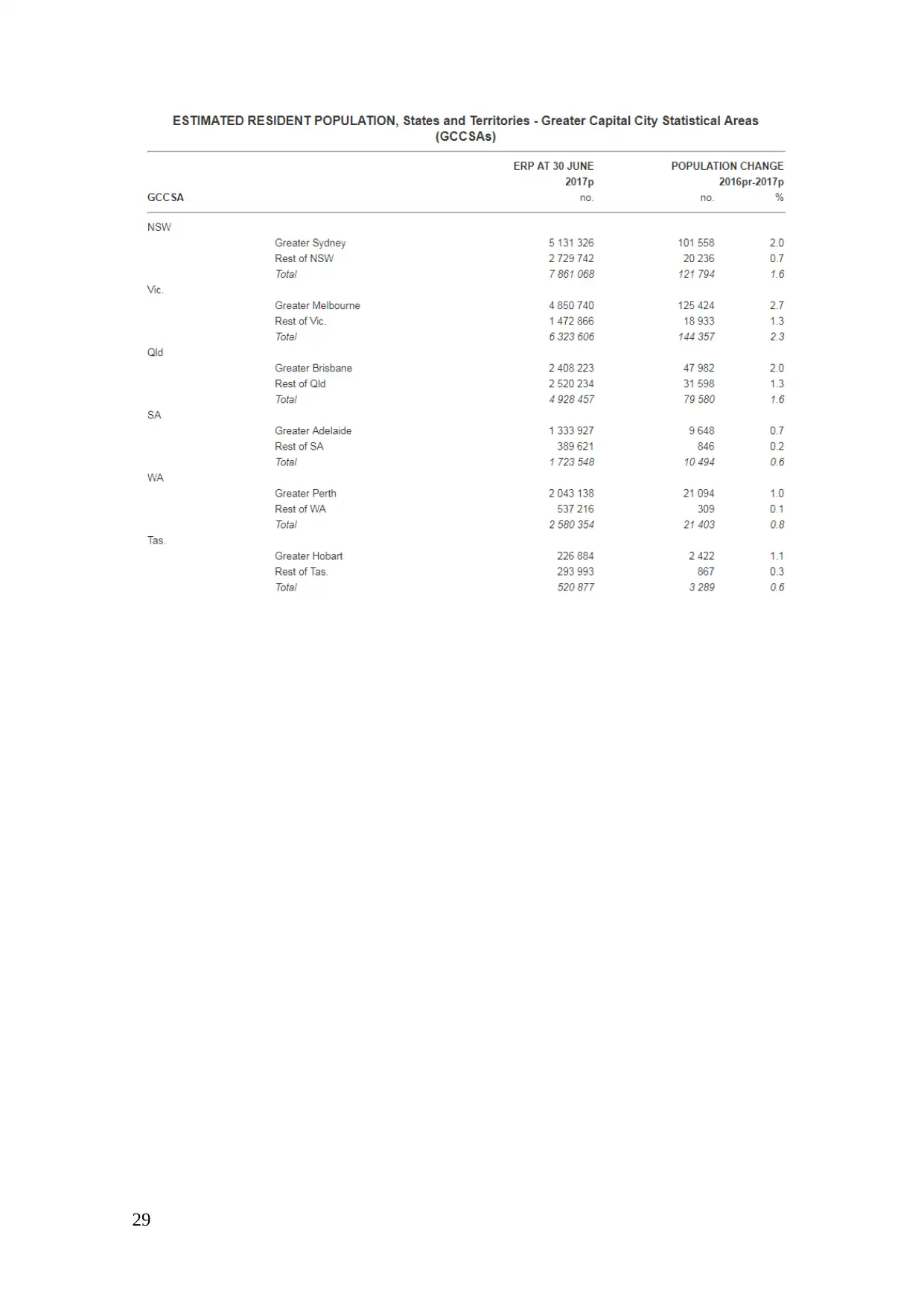
29
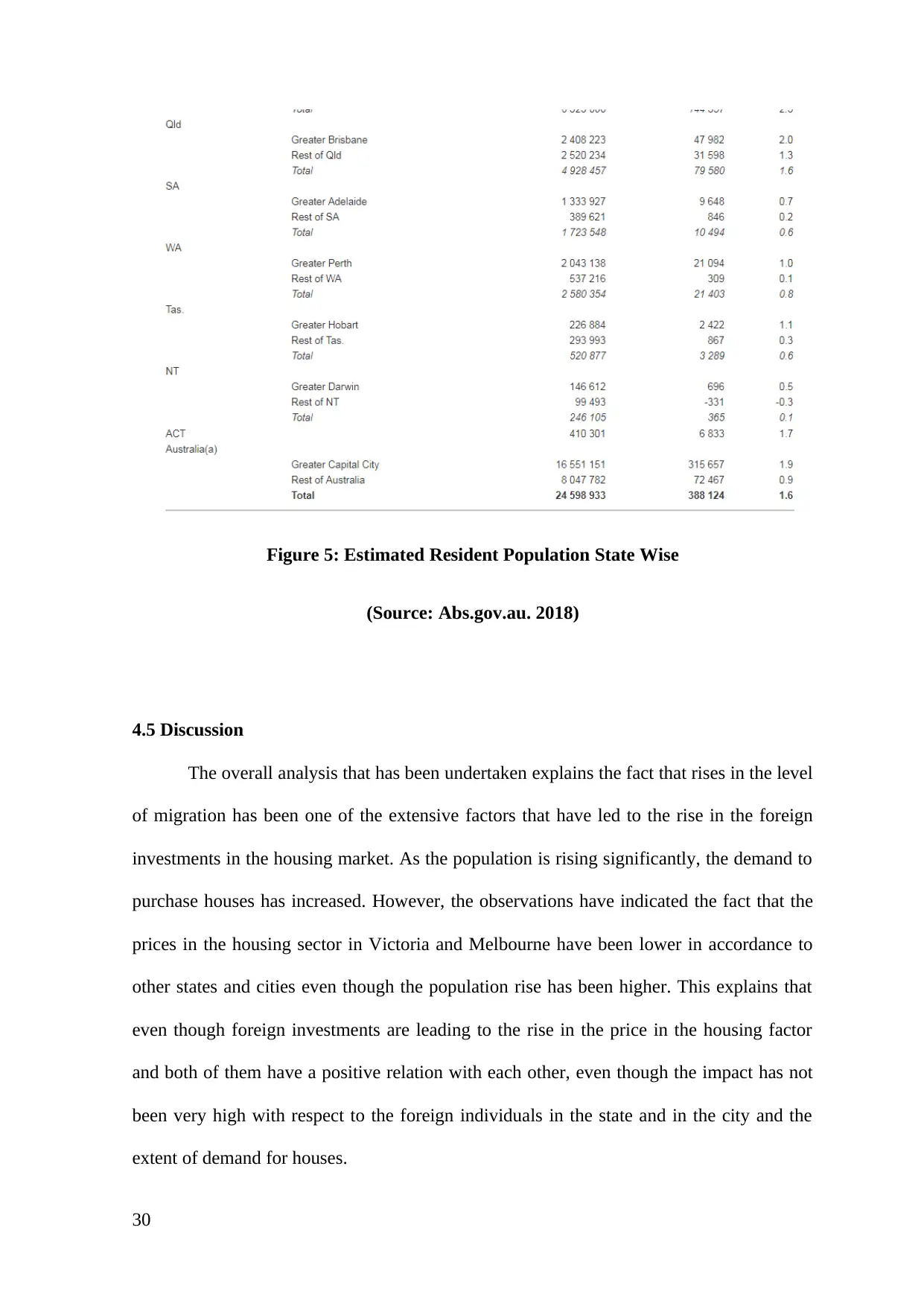
Figure 5: Estimated Resident Population State Wise
(Source: Abs.gov.au. 2018)
4.5 Discussion
The overall analysis that has been undertaken explains the fact that rises in the level
of migration has been one of the extensive factors that have led to the rise in the foreign
investments in the housing market. As the population is rising significantly, the demand to
purchase houses has increased. However, the observations have indicated the fact that the
prices in the housing sector in Victoria and Melbourne have been lower in accordance to
other states and cities even though the population rise has been higher. This explains that
even though foreign investments are leading to the rise in the price in the housing factor
and both of them have a positive relation with each other, even though the impact has not
been very high with respect to the foreign individuals in the state and in the city and the
extent of demand for houses.
30
(Source: Abs.gov.au. 2018)
4.5 Discussion
The overall analysis that has been undertaken explains the fact that rises in the level
of migration has been one of the extensive factors that have led to the rise in the foreign
investments in the housing market. As the population is rising significantly, the demand to
purchase houses has increased. However, the observations have indicated the fact that the
prices in the housing sector in Victoria and Melbourne have been lower in accordance to
other states and cities even though the population rise has been higher. This explains that
even though foreign investments are leading to the rise in the price in the housing factor
and both of them have a positive relation with each other, even though the impact has not
been very high with respect to the foreign individuals in the state and in the city and the
extent of demand for houses.
30
Paraphrase This Document
Need a fresh take? Get an instant paraphrase of this document with our AI Paraphraser
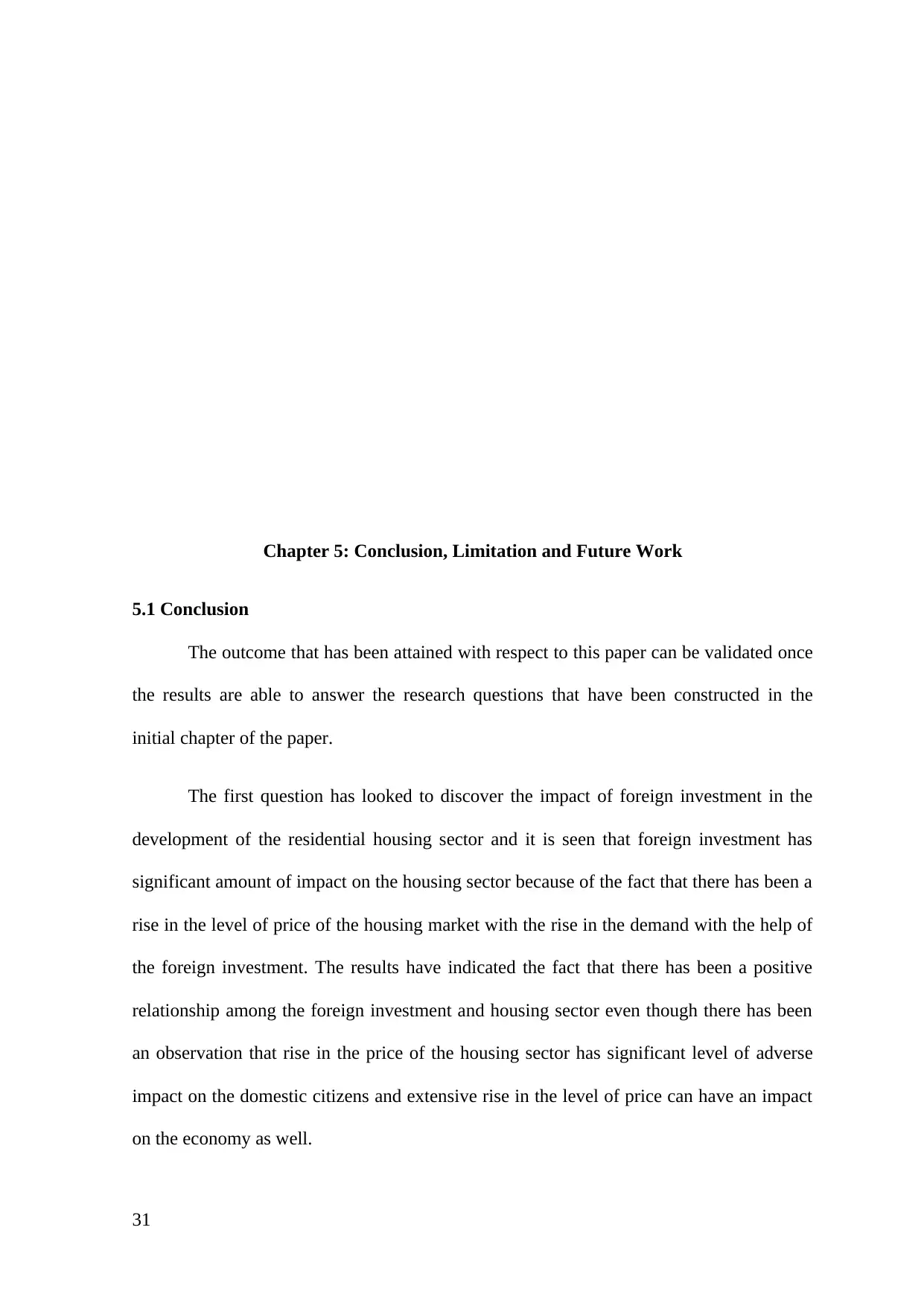
Chapter 5: Conclusion, Limitation and Future Work
5.1 Conclusion
The outcome that has been attained with respect to this paper can be validated once
the results are able to answer the research questions that have been constructed in the
initial chapter of the paper.
The first question has looked to discover the impact of foreign investment in the
development of the residential housing sector and it is seen that foreign investment has
significant amount of impact on the housing sector because of the fact that there has been a
rise in the level of price of the housing market with the rise in the demand with the help of
the foreign investment. The results have indicated the fact that there has been a positive
relationship among the foreign investment and housing sector even though there has been
an observation that rise in the price of the housing sector has significant level of adverse
impact on the domestic citizens and extensive rise in the level of price can have an impact
on the economy as well.
31
5.1 Conclusion
The outcome that has been attained with respect to this paper can be validated once
the results are able to answer the research questions that have been constructed in the
initial chapter of the paper.
The first question has looked to discover the impact of foreign investment in the
development of the residential housing sector and it is seen that foreign investment has
significant amount of impact on the housing sector because of the fact that there has been a
rise in the level of price of the housing market with the rise in the demand with the help of
the foreign investment. The results have indicated the fact that there has been a positive
relationship among the foreign investment and housing sector even though there has been
an observation that rise in the price of the housing sector has significant level of adverse
impact on the domestic citizens and extensive rise in the level of price can have an impact
on the economy as well.
31
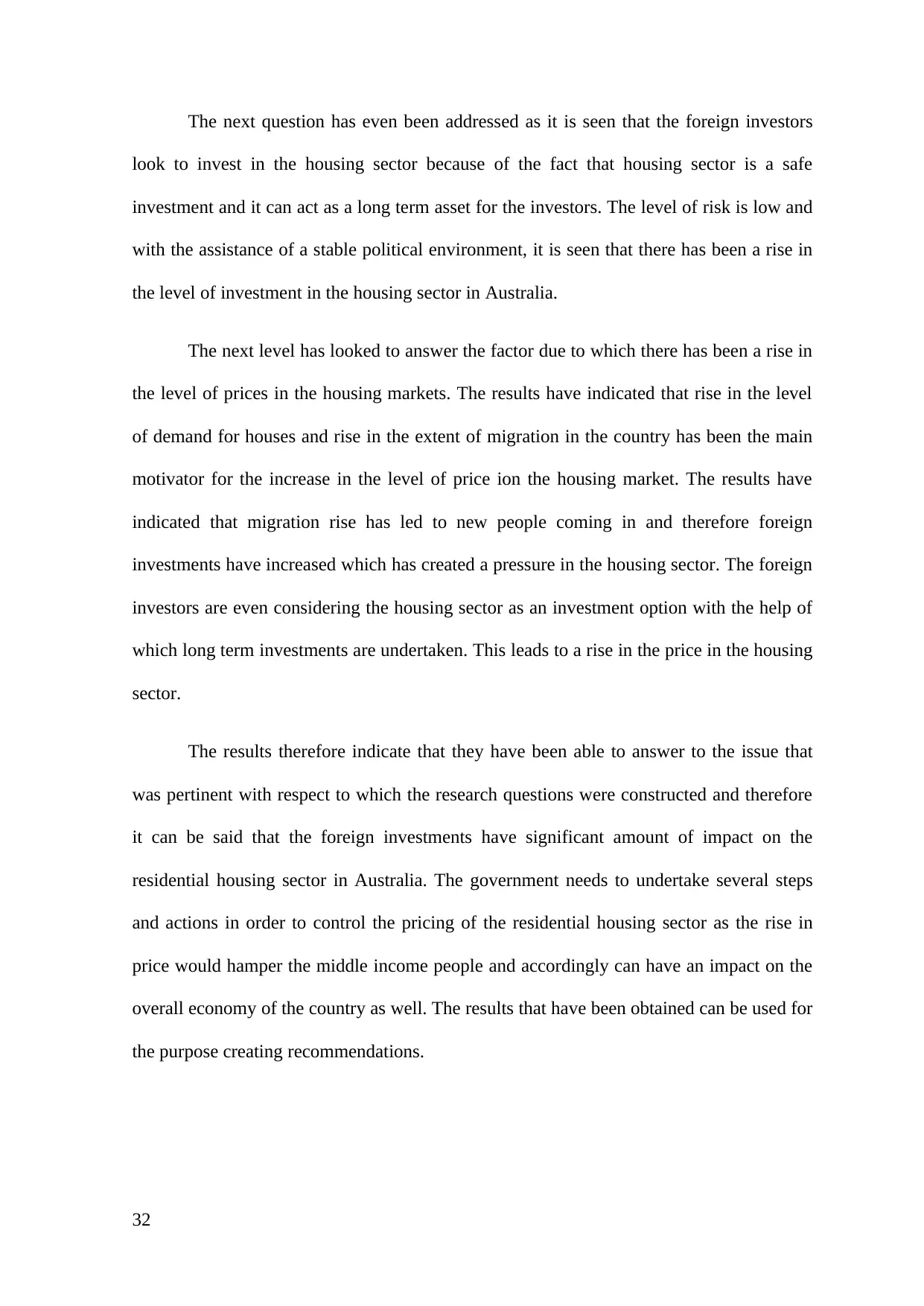
The next question has even been addressed as it is seen that the foreign investors
look to invest in the housing sector because of the fact that housing sector is a safe
investment and it can act as a long term asset for the investors. The level of risk is low and
with the assistance of a stable political environment, it is seen that there has been a rise in
the level of investment in the housing sector in Australia.
The next level has looked to answer the factor due to which there has been a rise in
the level of prices in the housing markets. The results have indicated that rise in the level
of demand for houses and rise in the extent of migration in the country has been the main
motivator for the increase in the level of price ion the housing market. The results have
indicated that migration rise has led to new people coming in and therefore foreign
investments have increased which has created a pressure in the housing sector. The foreign
investors are even considering the housing sector as an investment option with the help of
which long term investments are undertaken. This leads to a rise in the price in the housing
sector.
The results therefore indicate that they have been able to answer to the issue that
was pertinent with respect to which the research questions were constructed and therefore
it can be said that the foreign investments have significant amount of impact on the
residential housing sector in Australia. The government needs to undertake several steps
and actions in order to control the pricing of the residential housing sector as the rise in
price would hamper the middle income people and accordingly can have an impact on the
overall economy of the country as well. The results that have been obtained can be used for
the purpose creating recommendations.
32
look to invest in the housing sector because of the fact that housing sector is a safe
investment and it can act as a long term asset for the investors. The level of risk is low and
with the assistance of a stable political environment, it is seen that there has been a rise in
the level of investment in the housing sector in Australia.
The next level has looked to answer the factor due to which there has been a rise in
the level of prices in the housing markets. The results have indicated that rise in the level
of demand for houses and rise in the extent of migration in the country has been the main
motivator for the increase in the level of price ion the housing market. The results have
indicated that migration rise has led to new people coming in and therefore foreign
investments have increased which has created a pressure in the housing sector. The foreign
investors are even considering the housing sector as an investment option with the help of
which long term investments are undertaken. This leads to a rise in the price in the housing
sector.
The results therefore indicate that they have been able to answer to the issue that
was pertinent with respect to which the research questions were constructed and therefore
it can be said that the foreign investments have significant amount of impact on the
residential housing sector in Australia. The government needs to undertake several steps
and actions in order to control the pricing of the residential housing sector as the rise in
price would hamper the middle income people and accordingly can have an impact on the
overall economy of the country as well. The results that have been obtained can be used for
the purpose creating recommendations.
32
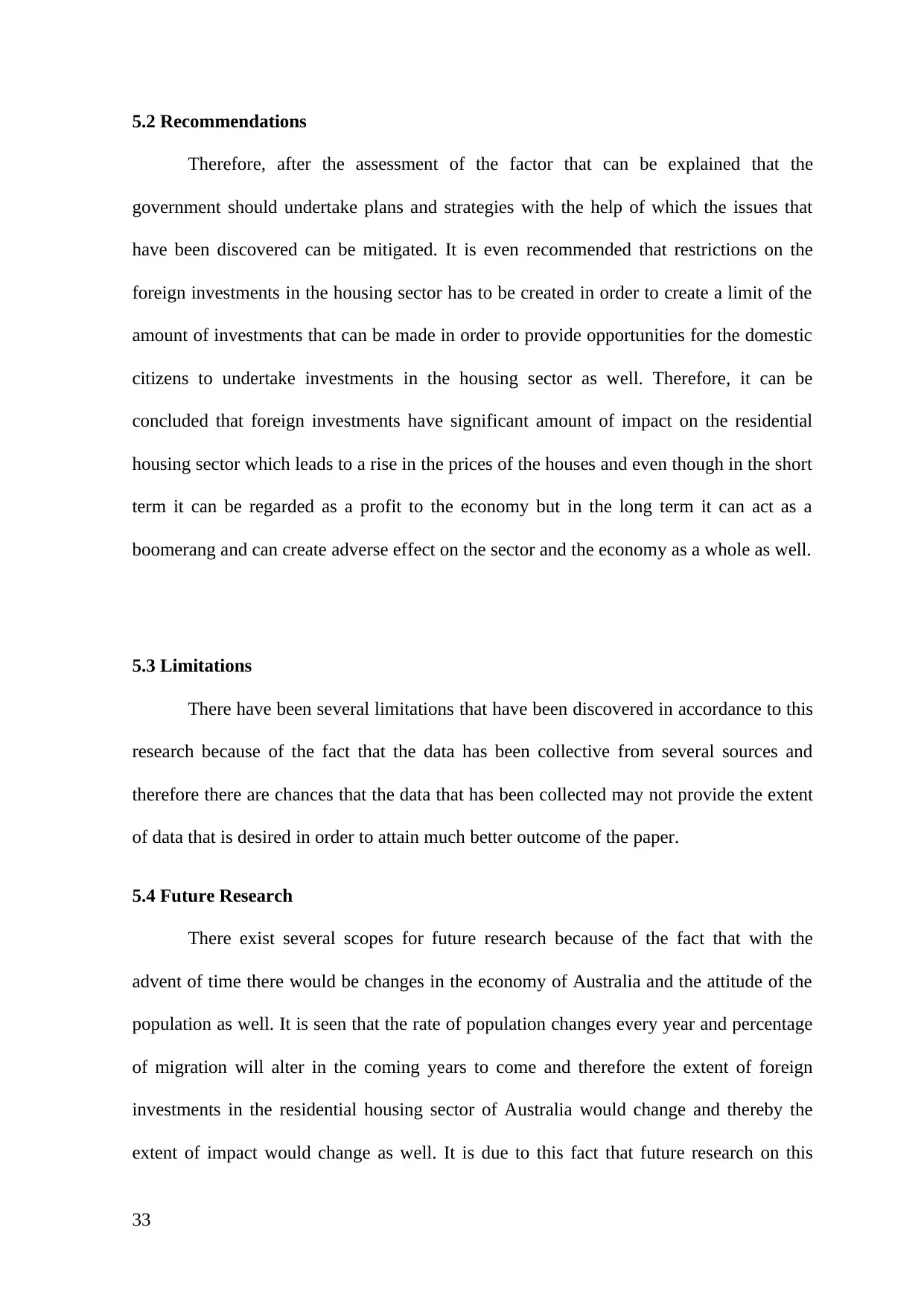
5.2 Recommendations
Therefore, after the assessment of the factor that can be explained that the
government should undertake plans and strategies with the help of which the issues that
have been discovered can be mitigated. It is even recommended that restrictions on the
foreign investments in the housing sector has to be created in order to create a limit of the
amount of investments that can be made in order to provide opportunities for the domestic
citizens to undertake investments in the housing sector as well. Therefore, it can be
concluded that foreign investments have significant amount of impact on the residential
housing sector which leads to a rise in the prices of the houses and even though in the short
term it can be regarded as a profit to the economy but in the long term it can act as a
boomerang and can create adverse effect on the sector and the economy as a whole as well.
5.3 Limitations
There have been several limitations that have been discovered in accordance to this
research because of the fact that the data has been collective from several sources and
therefore there are chances that the data that has been collected may not provide the extent
of data that is desired in order to attain much better outcome of the paper.
5.4 Future Research
There exist several scopes for future research because of the fact that with the
advent of time there would be changes in the economy of Australia and the attitude of the
population as well. It is seen that the rate of population changes every year and percentage
of migration will alter in the coming years to come and therefore the extent of foreign
investments in the residential housing sector of Australia would change and thereby the
extent of impact would change as well. It is due to this fact that future research on this
33
Therefore, after the assessment of the factor that can be explained that the
government should undertake plans and strategies with the help of which the issues that
have been discovered can be mitigated. It is even recommended that restrictions on the
foreign investments in the housing sector has to be created in order to create a limit of the
amount of investments that can be made in order to provide opportunities for the domestic
citizens to undertake investments in the housing sector as well. Therefore, it can be
concluded that foreign investments have significant amount of impact on the residential
housing sector which leads to a rise in the prices of the houses and even though in the short
term it can be regarded as a profit to the economy but in the long term it can act as a
boomerang and can create adverse effect on the sector and the economy as a whole as well.
5.3 Limitations
There have been several limitations that have been discovered in accordance to this
research because of the fact that the data has been collective from several sources and
therefore there are chances that the data that has been collected may not provide the extent
of data that is desired in order to attain much better outcome of the paper.
5.4 Future Research
There exist several scopes for future research because of the fact that with the
advent of time there would be changes in the economy of Australia and the attitude of the
population as well. It is seen that the rate of population changes every year and percentage
of migration will alter in the coming years to come and therefore the extent of foreign
investments in the residential housing sector of Australia would change and thereby the
extent of impact would change as well. It is due to this fact that future research on this
33
Secure Best Marks with AI Grader
Need help grading? Try our AI Grader for instant feedback on your assignments.
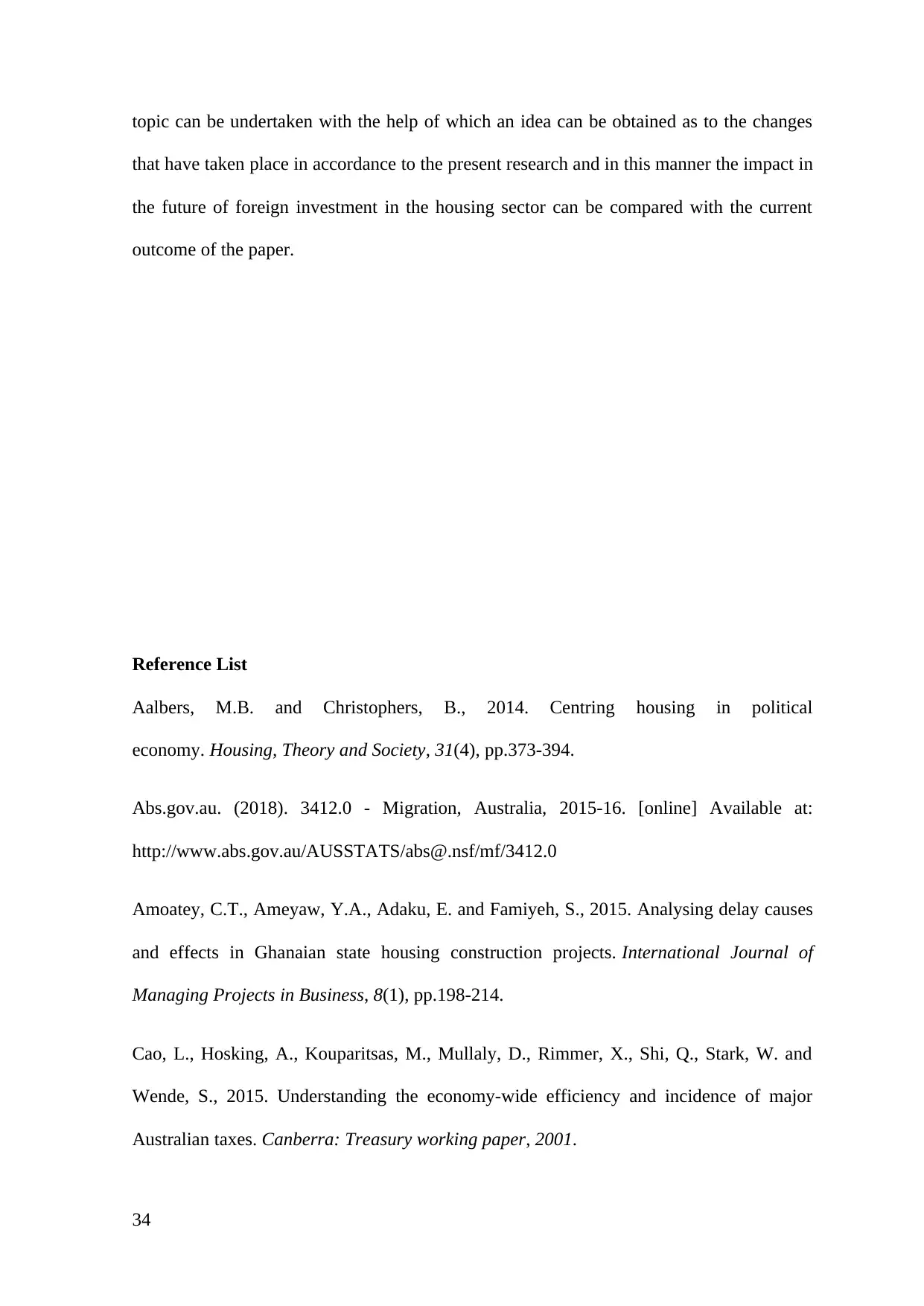
topic can be undertaken with the help of which an idea can be obtained as to the changes
that have taken place in accordance to the present research and in this manner the impact in
the future of foreign investment in the housing sector can be compared with the current
outcome of the paper.
Reference List
Aalbers, M.B. and Christophers, B., 2014. Centring housing in political
economy. Housing, Theory and Society, 31(4), pp.373-394.
Abs.gov.au. (2018). 3412.0 - Migration, Australia, 2015-16. [online] Available at:
http://www.abs.gov.au/AUSSTATS/abs@.nsf/mf/3412.0
Amoatey, C.T., Ameyaw, Y.A., Adaku, E. and Famiyeh, S., 2015. Analysing delay causes
and effects in Ghanaian state housing construction projects. International Journal of
Managing Projects in Business, 8(1), pp.198-214.
Cao, L., Hosking, A., Kouparitsas, M., Mullaly, D., Rimmer, X., Shi, Q., Stark, W. and
Wende, S., 2015. Understanding the economy-wide efficiency and incidence of major
Australian taxes. Canberra: Treasury working paper, 2001.
34
that have taken place in accordance to the present research and in this manner the impact in
the future of foreign investment in the housing sector can be compared with the current
outcome of the paper.
Reference List
Aalbers, M.B. and Christophers, B., 2014. Centring housing in political
economy. Housing, Theory and Society, 31(4), pp.373-394.
Abs.gov.au. (2018). 3412.0 - Migration, Australia, 2015-16. [online] Available at:
http://www.abs.gov.au/AUSSTATS/abs@.nsf/mf/3412.0
Amoatey, C.T., Ameyaw, Y.A., Adaku, E. and Famiyeh, S., 2015. Analysing delay causes
and effects in Ghanaian state housing construction projects. International Journal of
Managing Projects in Business, 8(1), pp.198-214.
Cao, L., Hosking, A., Kouparitsas, M., Mullaly, D., Rimmer, X., Shi, Q., Stark, W. and
Wende, S., 2015. Understanding the economy-wide efficiency and incidence of major
Australian taxes. Canberra: Treasury working paper, 2001.
34
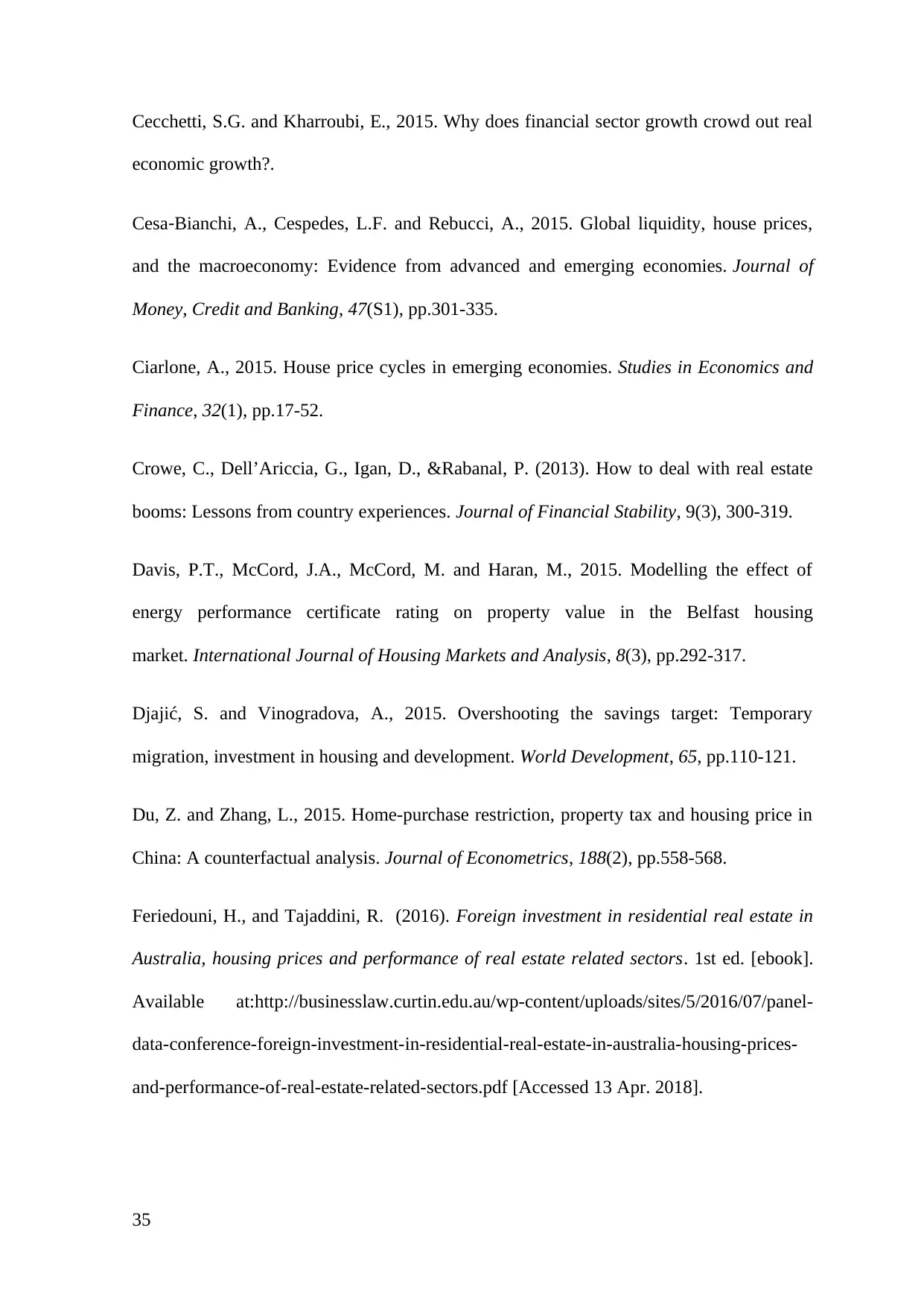
Cecchetti, S.G. and Kharroubi, E., 2015. Why does financial sector growth crowd out real
economic growth?.
Cesa‐Bianchi, A., Cespedes, L.F. and Rebucci, A., 2015. Global liquidity, house prices,
and the macroeconomy: Evidence from advanced and emerging economies. Journal of
Money, Credit and Banking, 47(S1), pp.301-335.
Ciarlone, A., 2015. House price cycles in emerging economies. Studies in Economics and
Finance, 32(1), pp.17-52.
Crowe, C., Dell’Ariccia, G., Igan, D., &Rabanal, P. (2013). How to deal with real estate
booms: Lessons from country experiences. Journal of Financial Stability, 9(3), 300-319.
Davis, P.T., McCord, J.A., McCord, M. and Haran, M., 2015. Modelling the effect of
energy performance certificate rating on property value in the Belfast housing
market. International Journal of Housing Markets and Analysis, 8(3), pp.292-317.
Djajić, S. and Vinogradova, A., 2015. Overshooting the savings target: Temporary
migration, investment in housing and development. World Development, 65, pp.110-121.
Du, Z. and Zhang, L., 2015. Home-purchase restriction, property tax and housing price in
China: A counterfactual analysis. Journal of Econometrics, 188(2), pp.558-568.
Feriedouni, H., and Tajaddini, R. (2016). Foreign investment in residential real estate in
Australia, housing prices and performance of real estate related sectors. 1st ed. [ebook].
Available at:http://businesslaw.curtin.edu.au/wp-content/uploads/sites/5/2016/07/panel-
data-conference-foreign-investment-in-residential-real-estate-in-australia-housing-prices-
and-performance-of-real-estate-related-sectors.pdf [Accessed 13 Apr. 2018].
35
economic growth?.
Cesa‐Bianchi, A., Cespedes, L.F. and Rebucci, A., 2015. Global liquidity, house prices,
and the macroeconomy: Evidence from advanced and emerging economies. Journal of
Money, Credit and Banking, 47(S1), pp.301-335.
Ciarlone, A., 2015. House price cycles in emerging economies. Studies in Economics and
Finance, 32(1), pp.17-52.
Crowe, C., Dell’Ariccia, G., Igan, D., &Rabanal, P. (2013). How to deal with real estate
booms: Lessons from country experiences. Journal of Financial Stability, 9(3), 300-319.
Davis, P.T., McCord, J.A., McCord, M. and Haran, M., 2015. Modelling the effect of
energy performance certificate rating on property value in the Belfast housing
market. International Journal of Housing Markets and Analysis, 8(3), pp.292-317.
Djajić, S. and Vinogradova, A., 2015. Overshooting the savings target: Temporary
migration, investment in housing and development. World Development, 65, pp.110-121.
Du, Z. and Zhang, L., 2015. Home-purchase restriction, property tax and housing price in
China: A counterfactual analysis. Journal of Econometrics, 188(2), pp.558-568.
Feriedouni, H., and Tajaddini, R. (2016). Foreign investment in residential real estate in
Australia, housing prices and performance of real estate related sectors. 1st ed. [ebook].
Available at:http://businesslaw.curtin.edu.au/wp-content/uploads/sites/5/2016/07/panel-
data-conference-foreign-investment-in-residential-real-estate-in-australia-housing-prices-
and-performance-of-real-estate-related-sectors.pdf [Accessed 13 Apr. 2018].
35
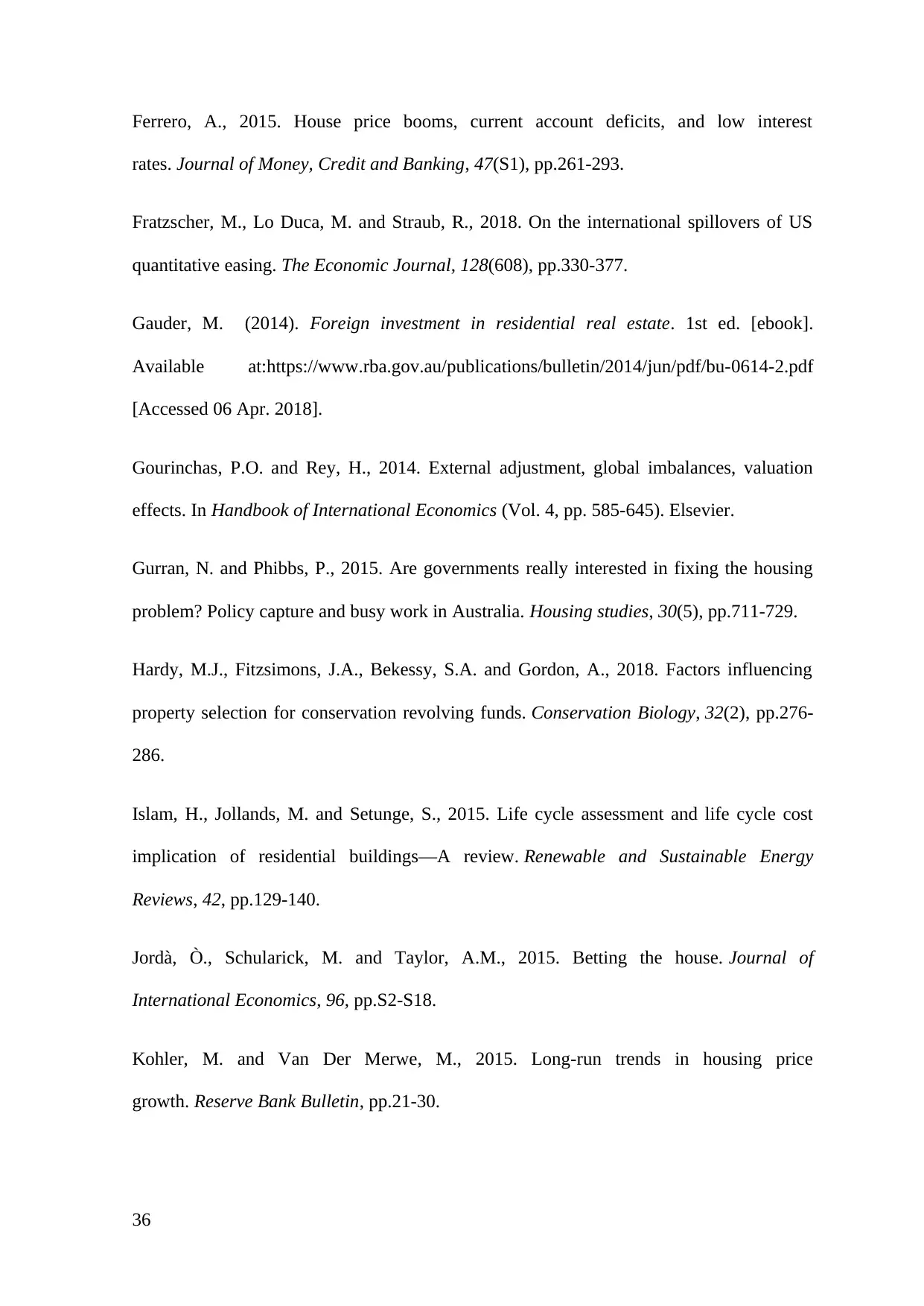
Ferrero, A., 2015. House price booms, current account deficits, and low interest
rates. Journal of Money, Credit and Banking, 47(S1), pp.261-293.
Fratzscher, M., Lo Duca, M. and Straub, R., 2018. On the international spillovers of US
quantitative easing. The Economic Journal, 128(608), pp.330-377.
Gauder, M. (2014). Foreign investment in residential real estate. 1st ed. [ebook].
Available at:https://www.rba.gov.au/publications/bulletin/2014/jun/pdf/bu-0614-2.pdf
[Accessed 06 Apr. 2018].
Gourinchas, P.O. and Rey, H., 2014. External adjustment, global imbalances, valuation
effects. In Handbook of International Economics (Vol. 4, pp. 585-645). Elsevier.
Gurran, N. and Phibbs, P., 2015. Are governments really interested in fixing the housing
problem? Policy capture and busy work in Australia. Housing studies, 30(5), pp.711-729.
Hardy, M.J., Fitzsimons, J.A., Bekessy, S.A. and Gordon, A., 2018. Factors influencing
property selection for conservation revolving funds. Conservation Biology, 32(2), pp.276-
286.
Islam, H., Jollands, M. and Setunge, S., 2015. Life cycle assessment and life cycle cost
implication of residential buildings—A review. Renewable and Sustainable Energy
Reviews, 42, pp.129-140.
Jordà, Ò., Schularick, M. and Taylor, A.M., 2015. Betting the house. Journal of
International Economics, 96, pp.S2-S18.
Kohler, M. and Van Der Merwe, M., 2015. Long-run trends in housing price
growth. Reserve Bank Bulletin, pp.21-30.
36
rates. Journal of Money, Credit and Banking, 47(S1), pp.261-293.
Fratzscher, M., Lo Duca, M. and Straub, R., 2018. On the international spillovers of US
quantitative easing. The Economic Journal, 128(608), pp.330-377.
Gauder, M. (2014). Foreign investment in residential real estate. 1st ed. [ebook].
Available at:https://www.rba.gov.au/publications/bulletin/2014/jun/pdf/bu-0614-2.pdf
[Accessed 06 Apr. 2018].
Gourinchas, P.O. and Rey, H., 2014. External adjustment, global imbalances, valuation
effects. In Handbook of International Economics (Vol. 4, pp. 585-645). Elsevier.
Gurran, N. and Phibbs, P., 2015. Are governments really interested in fixing the housing
problem? Policy capture and busy work in Australia. Housing studies, 30(5), pp.711-729.
Hardy, M.J., Fitzsimons, J.A., Bekessy, S.A. and Gordon, A., 2018. Factors influencing
property selection for conservation revolving funds. Conservation Biology, 32(2), pp.276-
286.
Islam, H., Jollands, M. and Setunge, S., 2015. Life cycle assessment and life cycle cost
implication of residential buildings—A review. Renewable and Sustainable Energy
Reviews, 42, pp.129-140.
Jordà, Ò., Schularick, M. and Taylor, A.M., 2015. Betting the house. Journal of
International Economics, 96, pp.S2-S18.
Kohler, M. and Van Der Merwe, M., 2015. Long-run trends in housing price
growth. Reserve Bank Bulletin, pp.21-30.
36
Paraphrase This Document
Need a fresh take? Get an instant paraphrase of this document with our AI Paraphraser
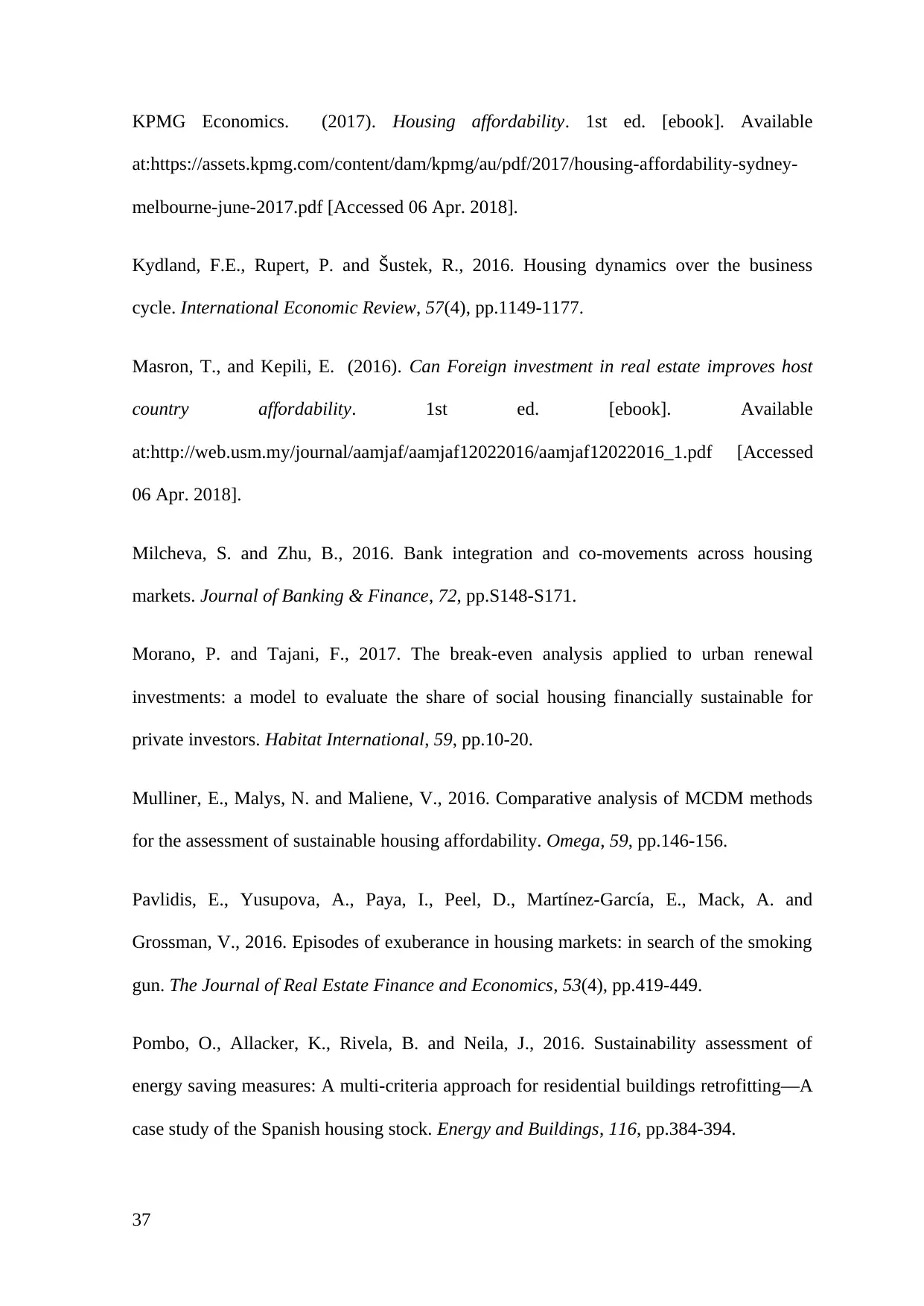
KPMG Economics. (2017). Housing affordability. 1st ed. [ebook]. Available
at:https://assets.kpmg.com/content/dam/kpmg/au/pdf/2017/housing-affordability-sydney-
melbourne-june-2017.pdf [Accessed 06 Apr. 2018].
Kydland, F.E., Rupert, P. and Šustek, R., 2016. Housing dynamics over the business
cycle. International Economic Review, 57(4), pp.1149-1177.
Masron, T., and Kepili, E. (2016). Can Foreign investment in real estate improves host
country affordability. 1st ed. [ebook]. Available
at:http://web.usm.my/journal/aamjaf/aamjaf12022016/aamjaf12022016_1.pdf [Accessed
06 Apr. 2018].
Milcheva, S. and Zhu, B., 2016. Bank integration and co-movements across housing
markets. Journal of Banking & Finance, 72, pp.S148-S171.
Morano, P. and Tajani, F., 2017. The break-even analysis applied to urban renewal
investments: a model to evaluate the share of social housing financially sustainable for
private investors. Habitat International, 59, pp.10-20.
Mulliner, E., Malys, N. and Maliene, V., 2016. Comparative analysis of MCDM methods
for the assessment of sustainable housing affordability. Omega, 59, pp.146-156.
Pavlidis, E., Yusupova, A., Paya, I., Peel, D., Martínez-García, E., Mack, A. and
Grossman, V., 2016. Episodes of exuberance in housing markets: in search of the smoking
gun. The Journal of Real Estate Finance and Economics, 53(4), pp.419-449.
Pombo, O., Allacker, K., Rivela, B. and Neila, J., 2016. Sustainability assessment of
energy saving measures: A multi-criteria approach for residential buildings retrofitting—A
case study of the Spanish housing stock. Energy and Buildings, 116, pp.384-394.
37
at:https://assets.kpmg.com/content/dam/kpmg/au/pdf/2017/housing-affordability-sydney-
melbourne-june-2017.pdf [Accessed 06 Apr. 2018].
Kydland, F.E., Rupert, P. and Šustek, R., 2016. Housing dynamics over the business
cycle. International Economic Review, 57(4), pp.1149-1177.
Masron, T., and Kepili, E. (2016). Can Foreign investment in real estate improves host
country affordability. 1st ed. [ebook]. Available
at:http://web.usm.my/journal/aamjaf/aamjaf12022016/aamjaf12022016_1.pdf [Accessed
06 Apr. 2018].
Milcheva, S. and Zhu, B., 2016. Bank integration and co-movements across housing
markets. Journal of Banking & Finance, 72, pp.S148-S171.
Morano, P. and Tajani, F., 2017. The break-even analysis applied to urban renewal
investments: a model to evaluate the share of social housing financially sustainable for
private investors. Habitat International, 59, pp.10-20.
Mulliner, E., Malys, N. and Maliene, V., 2016. Comparative analysis of MCDM methods
for the assessment of sustainable housing affordability. Omega, 59, pp.146-156.
Pavlidis, E., Yusupova, A., Paya, I., Peel, D., Martínez-García, E., Mack, A. and
Grossman, V., 2016. Episodes of exuberance in housing markets: in search of the smoking
gun. The Journal of Real Estate Finance and Economics, 53(4), pp.419-449.
Pombo, O., Allacker, K., Rivela, B. and Neila, J., 2016. Sustainability assessment of
energy saving measures: A multi-criteria approach for residential buildings retrofitting—A
case study of the Spanish housing stock. Energy and Buildings, 116, pp.384-394.
37
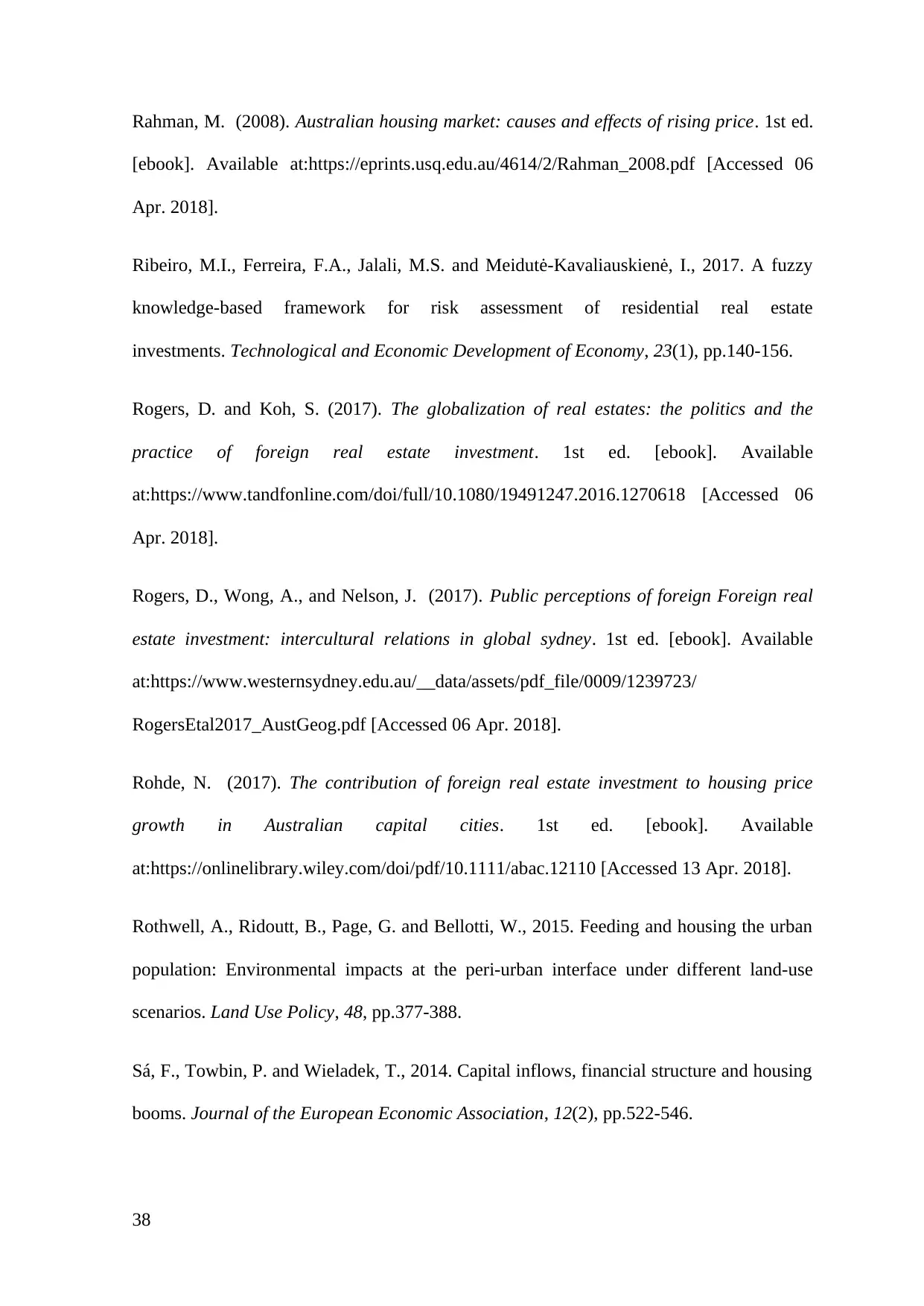
Rahman, M. (2008). Australian housing market: causes and effects of rising price. 1st ed.
[ebook]. Available at:https://eprints.usq.edu.au/4614/2/Rahman_2008.pdf [Accessed 06
Apr. 2018].
Ribeiro, M.I., Ferreira, F.A., Jalali, M.S. and Meidutė-Kavaliauskienė, I., 2017. A fuzzy
knowledge-based framework for risk assessment of residential real estate
investments. Technological and Economic Development of Economy, 23(1), pp.140-156.
Rogers, D. and Koh, S. (2017). The globalization of real estates: the politics and the
practice of foreign real estate investment. 1st ed. [ebook]. Available
at:https://www.tandfonline.com/doi/full/10.1080/19491247.2016.1270618 [Accessed 06
Apr. 2018].
Rogers, D., Wong, A., and Nelson, J. (2017). Public perceptions of foreign Foreign real
estate investment: intercultural relations in global sydney. 1st ed. [ebook]. Available
at:https://www.westernsydney.edu.au/__data/assets/pdf_file/0009/1239723/
RogersEtal2017_AustGeog.pdf [Accessed 06 Apr. 2018].
Rohde, N. (2017). The contribution of foreign real estate investment to housing price
growth in Australian capital cities. 1st ed. [ebook]. Available
at:https://onlinelibrary.wiley.com/doi/pdf/10.1111/abac.12110 [Accessed 13 Apr. 2018].
Rothwell, A., Ridoutt, B., Page, G. and Bellotti, W., 2015. Feeding and housing the urban
population: Environmental impacts at the peri-urban interface under different land-use
scenarios. Land Use Policy, 48, pp.377-388.
Sá, F., Towbin, P. and Wieladek, T., 2014. Capital inflows, financial structure and housing
booms. Journal of the European Economic Association, 12(2), pp.522-546.
38
[ebook]. Available at:https://eprints.usq.edu.au/4614/2/Rahman_2008.pdf [Accessed 06
Apr. 2018].
Ribeiro, M.I., Ferreira, F.A., Jalali, M.S. and Meidutė-Kavaliauskienė, I., 2017. A fuzzy
knowledge-based framework for risk assessment of residential real estate
investments. Technological and Economic Development of Economy, 23(1), pp.140-156.
Rogers, D. and Koh, S. (2017). The globalization of real estates: the politics and the
practice of foreign real estate investment. 1st ed. [ebook]. Available
at:https://www.tandfonline.com/doi/full/10.1080/19491247.2016.1270618 [Accessed 06
Apr. 2018].
Rogers, D., Wong, A., and Nelson, J. (2017). Public perceptions of foreign Foreign real
estate investment: intercultural relations in global sydney. 1st ed. [ebook]. Available
at:https://www.westernsydney.edu.au/__data/assets/pdf_file/0009/1239723/
RogersEtal2017_AustGeog.pdf [Accessed 06 Apr. 2018].
Rohde, N. (2017). The contribution of foreign real estate investment to housing price
growth in Australian capital cities. 1st ed. [ebook]. Available
at:https://onlinelibrary.wiley.com/doi/pdf/10.1111/abac.12110 [Accessed 13 Apr. 2018].
Rothwell, A., Ridoutt, B., Page, G. and Bellotti, W., 2015. Feeding and housing the urban
population: Environmental impacts at the peri-urban interface under different land-use
scenarios. Land Use Policy, 48, pp.377-388.
Sá, F., Towbin, P. and Wieladek, T., 2014. Capital inflows, financial structure and housing
booms. Journal of the European Economic Association, 12(2), pp.522-546.
38
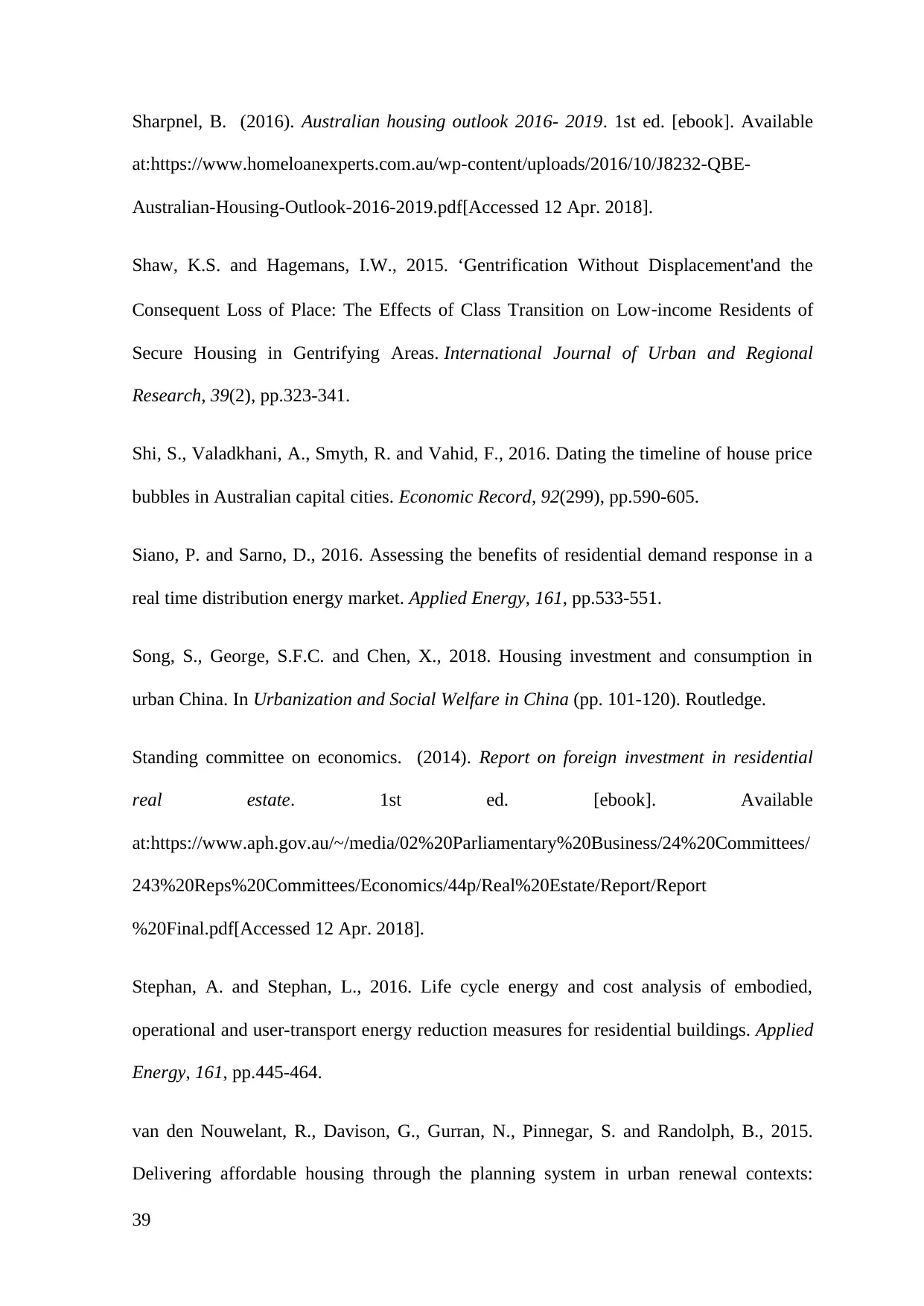
Sharpnel, B. (2016). Australian housing outlook 2016- 2019. 1st ed. [ebook]. Available
at:https://www.homeloanexperts.com.au/wp-content/uploads/2016/10/J8232-QBE-
Australian-Housing-Outlook-2016-2019.pdf[Accessed 12 Apr. 2018].
Shaw, K.S. and Hagemans, I.W., 2015. ‘Gentrification Without Displacement'and the
Consequent Loss of Place: The Effects of Class Transition on Low‐income Residents of
Secure Housing in Gentrifying Areas. International Journal of Urban and Regional
Research, 39(2), pp.323-341.
Shi, S., Valadkhani, A., Smyth, R. and Vahid, F., 2016. Dating the timeline of house price
bubbles in Australian capital cities. Economic Record, 92(299), pp.590-605.
Siano, P. and Sarno, D., 2016. Assessing the benefits of residential demand response in a
real time distribution energy market. Applied Energy, 161, pp.533-551.
Song, S., George, S.F.C. and Chen, X., 2018. Housing investment and consumption in
urban China. In Urbanization and Social Welfare in China (pp. 101-120). Routledge.
Standing committee on economics. (2014). Report on foreign investment in residential
real estate. 1st ed. [ebook]. Available
at:https://www.aph.gov.au/~/media/02%20Parliamentary%20Business/24%20Committees/
243%20Reps%20Committees/Economics/44p/Real%20Estate/Report/Report
%20Final.pdf[Accessed 12 Apr. 2018].
Stephan, A. and Stephan, L., 2016. Life cycle energy and cost analysis of embodied,
operational and user-transport energy reduction measures for residential buildings. Applied
Energy, 161, pp.445-464.
van den Nouwelant, R., Davison, G., Gurran, N., Pinnegar, S. and Randolph, B., 2015.
Delivering affordable housing through the planning system in urban renewal contexts:
39
at:https://www.homeloanexperts.com.au/wp-content/uploads/2016/10/J8232-QBE-
Australian-Housing-Outlook-2016-2019.pdf[Accessed 12 Apr. 2018].
Shaw, K.S. and Hagemans, I.W., 2015. ‘Gentrification Without Displacement'and the
Consequent Loss of Place: The Effects of Class Transition on Low‐income Residents of
Secure Housing in Gentrifying Areas. International Journal of Urban and Regional
Research, 39(2), pp.323-341.
Shi, S., Valadkhani, A., Smyth, R. and Vahid, F., 2016. Dating the timeline of house price
bubbles in Australian capital cities. Economic Record, 92(299), pp.590-605.
Siano, P. and Sarno, D., 2016. Assessing the benefits of residential demand response in a
real time distribution energy market. Applied Energy, 161, pp.533-551.
Song, S., George, S.F.C. and Chen, X., 2018. Housing investment and consumption in
urban China. In Urbanization and Social Welfare in China (pp. 101-120). Routledge.
Standing committee on economics. (2014). Report on foreign investment in residential
real estate. 1st ed. [ebook]. Available
at:https://www.aph.gov.au/~/media/02%20Parliamentary%20Business/24%20Committees/
243%20Reps%20Committees/Economics/44p/Real%20Estate/Report/Report
%20Final.pdf[Accessed 12 Apr. 2018].
Stephan, A. and Stephan, L., 2016. Life cycle energy and cost analysis of embodied,
operational and user-transport energy reduction measures for residential buildings. Applied
Energy, 161, pp.445-464.
van den Nouwelant, R., Davison, G., Gurran, N., Pinnegar, S. and Randolph, B., 2015.
Delivering affordable housing through the planning system in urban renewal contexts:
39
Secure Best Marks with AI Grader
Need help grading? Try our AI Grader for instant feedback on your assignments.
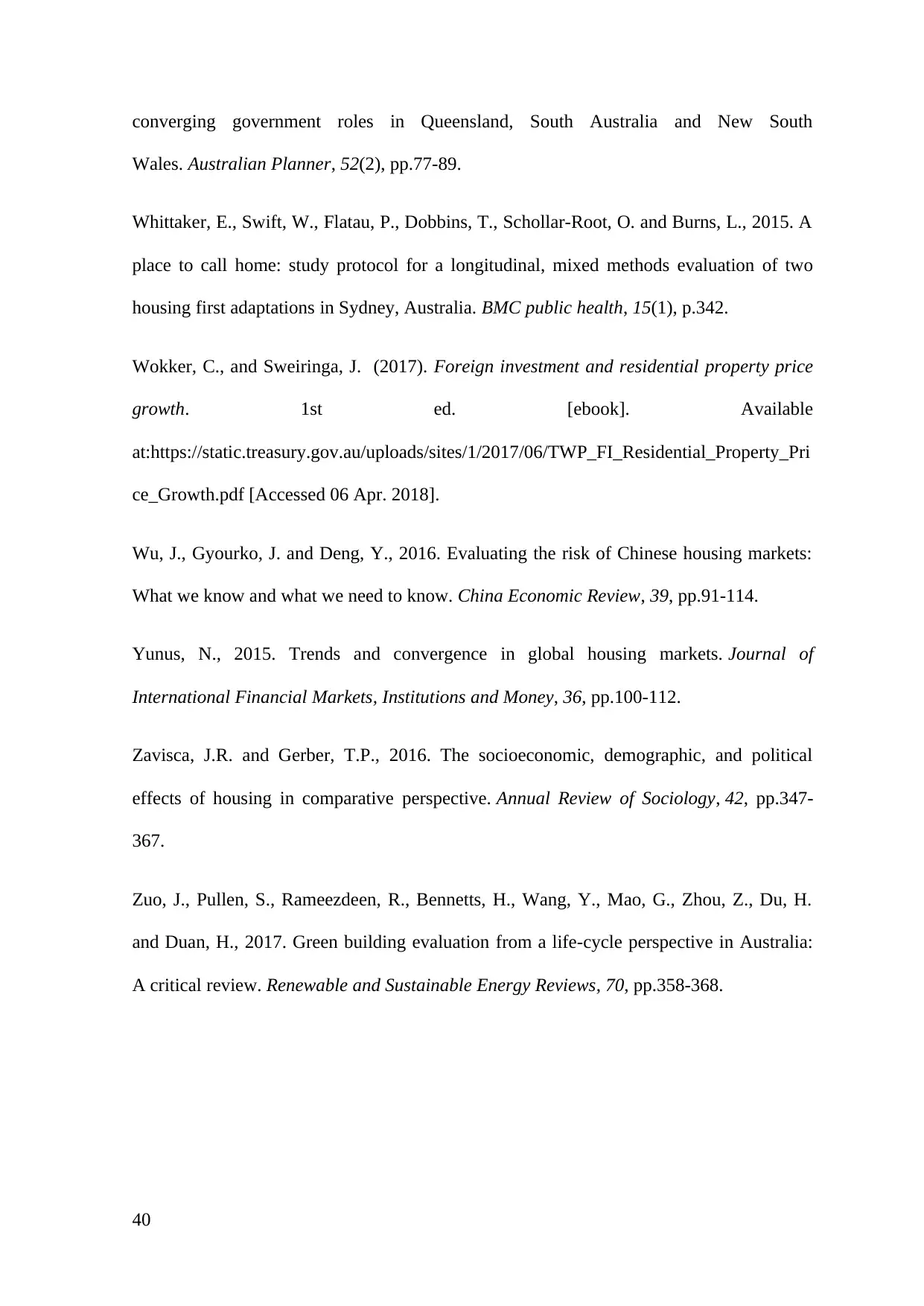
converging government roles in Queensland, South Australia and New South
Wales. Australian Planner, 52(2), pp.77-89.
Whittaker, E., Swift, W., Flatau, P., Dobbins, T., Schollar-Root, O. and Burns, L., 2015. A
place to call home: study protocol for a longitudinal, mixed methods evaluation of two
housing first adaptations in Sydney, Australia. BMC public health, 15(1), p.342.
Wokker, C., and Sweiringa, J. (2017). Foreign investment and residential property price
growth. 1st ed. [ebook]. Available
at:https://static.treasury.gov.au/uploads/sites/1/2017/06/TWP_FI_Residential_Property_Pri
ce_Growth.pdf [Accessed 06 Apr. 2018].
Wu, J., Gyourko, J. and Deng, Y., 2016. Evaluating the risk of Chinese housing markets:
What we know and what we need to know. China Economic Review, 39, pp.91-114.
Yunus, N., 2015. Trends and convergence in global housing markets. Journal of
International Financial Markets, Institutions and Money, 36, pp.100-112.
Zavisca, J.R. and Gerber, T.P., 2016. The socioeconomic, demographic, and political
effects of housing in comparative perspective. Annual Review of Sociology, 42, pp.347-
367.
Zuo, J., Pullen, S., Rameezdeen, R., Bennetts, H., Wang, Y., Mao, G., Zhou, Z., Du, H.
and Duan, H., 2017. Green building evaluation from a life-cycle perspective in Australia:
A critical review. Renewable and Sustainable Energy Reviews, 70, pp.358-368.
40
Wales. Australian Planner, 52(2), pp.77-89.
Whittaker, E., Swift, W., Flatau, P., Dobbins, T., Schollar-Root, O. and Burns, L., 2015. A
place to call home: study protocol for a longitudinal, mixed methods evaluation of two
housing first adaptations in Sydney, Australia. BMC public health, 15(1), p.342.
Wokker, C., and Sweiringa, J. (2017). Foreign investment and residential property price
growth. 1st ed. [ebook]. Available
at:https://static.treasury.gov.au/uploads/sites/1/2017/06/TWP_FI_Residential_Property_Pri
ce_Growth.pdf [Accessed 06 Apr. 2018].
Wu, J., Gyourko, J. and Deng, Y., 2016. Evaluating the risk of Chinese housing markets:
What we know and what we need to know. China Economic Review, 39, pp.91-114.
Yunus, N., 2015. Trends and convergence in global housing markets. Journal of
International Financial Markets, Institutions and Money, 36, pp.100-112.
Zavisca, J.R. and Gerber, T.P., 2016. The socioeconomic, demographic, and political
effects of housing in comparative perspective. Annual Review of Sociology, 42, pp.347-
367.
Zuo, J., Pullen, S., Rameezdeen, R., Bennetts, H., Wang, Y., Mao, G., Zhou, Z., Du, H.
and Duan, H., 2017. Green building evaluation from a life-cycle perspective in Australia:
A critical review. Renewable and Sustainable Energy Reviews, 70, pp.358-368.
40
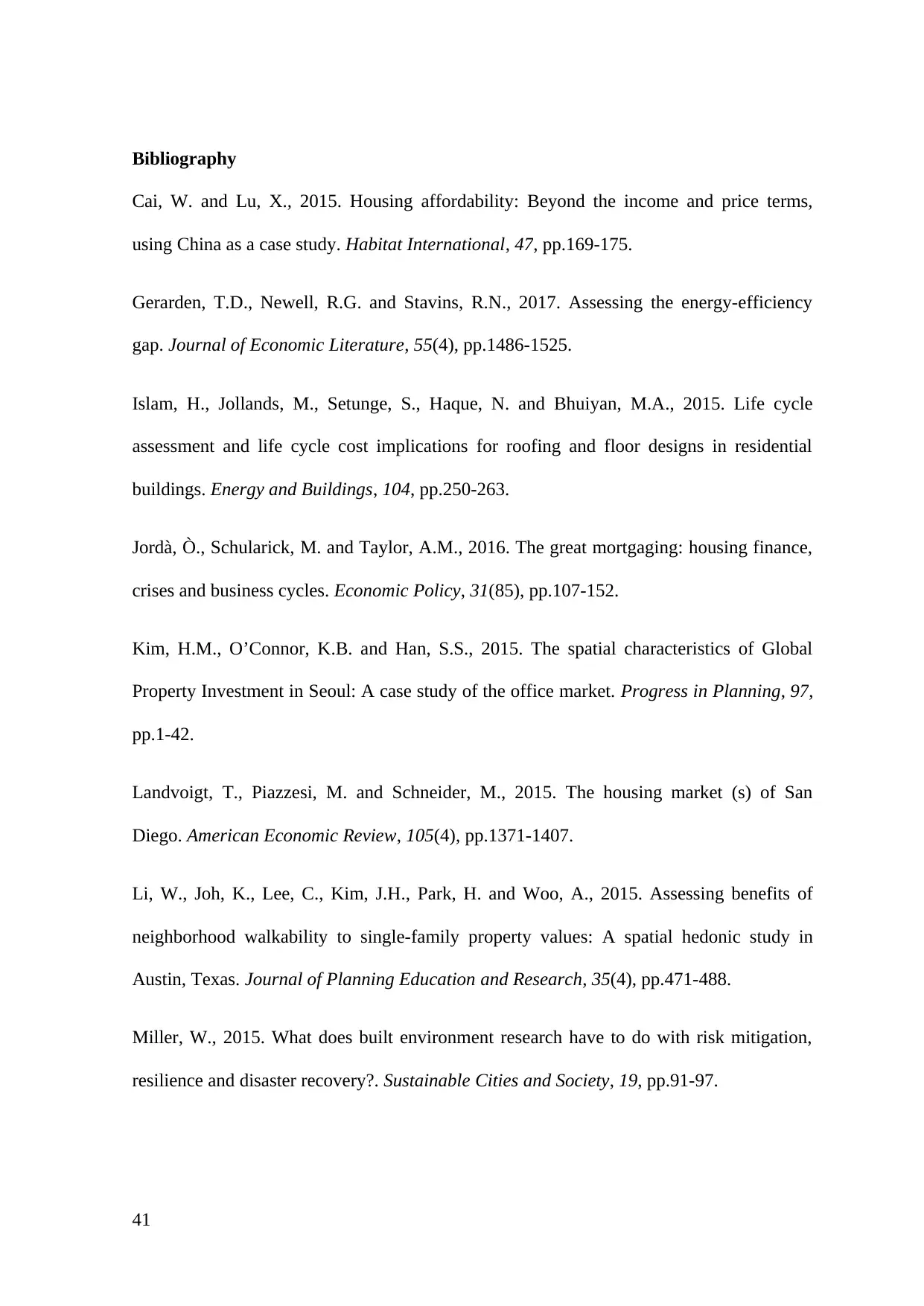
Bibliography
Cai, W. and Lu, X., 2015. Housing affordability: Beyond the income and price terms,
using China as a case study. Habitat International, 47, pp.169-175.
Gerarden, T.D., Newell, R.G. and Stavins, R.N., 2017. Assessing the energy-efficiency
gap. Journal of Economic Literature, 55(4), pp.1486-1525.
Islam, H., Jollands, M., Setunge, S., Haque, N. and Bhuiyan, M.A., 2015. Life cycle
assessment and life cycle cost implications for roofing and floor designs in residential
buildings. Energy and Buildings, 104, pp.250-263.
Jordà, Ò., Schularick, M. and Taylor, A.M., 2016. The great mortgaging: housing finance,
crises and business cycles. Economic Policy, 31(85), pp.107-152.
Kim, H.M., O’Connor, K.B. and Han, S.S., 2015. The spatial characteristics of Global
Property Investment in Seoul: A case study of the office market. Progress in Planning, 97,
pp.1-42.
Landvoigt, T., Piazzesi, M. and Schneider, M., 2015. The housing market (s) of San
Diego. American Economic Review, 105(4), pp.1371-1407.
Li, W., Joh, K., Lee, C., Kim, J.H., Park, H. and Woo, A., 2015. Assessing benefits of
neighborhood walkability to single-family property values: A spatial hedonic study in
Austin, Texas. Journal of Planning Education and Research, 35(4), pp.471-488.
Miller, W., 2015. What does built environment research have to do with risk mitigation,
resilience and disaster recovery?. Sustainable Cities and Society, 19, pp.91-97.
41
Cai, W. and Lu, X., 2015. Housing affordability: Beyond the income and price terms,
using China as a case study. Habitat International, 47, pp.169-175.
Gerarden, T.D., Newell, R.G. and Stavins, R.N., 2017. Assessing the energy-efficiency
gap. Journal of Economic Literature, 55(4), pp.1486-1525.
Islam, H., Jollands, M., Setunge, S., Haque, N. and Bhuiyan, M.A., 2015. Life cycle
assessment and life cycle cost implications for roofing and floor designs in residential
buildings. Energy and Buildings, 104, pp.250-263.
Jordà, Ò., Schularick, M. and Taylor, A.M., 2016. The great mortgaging: housing finance,
crises and business cycles. Economic Policy, 31(85), pp.107-152.
Kim, H.M., O’Connor, K.B. and Han, S.S., 2015. The spatial characteristics of Global
Property Investment in Seoul: A case study of the office market. Progress in Planning, 97,
pp.1-42.
Landvoigt, T., Piazzesi, M. and Schneider, M., 2015. The housing market (s) of San
Diego. American Economic Review, 105(4), pp.1371-1407.
Li, W., Joh, K., Lee, C., Kim, J.H., Park, H. and Woo, A., 2015. Assessing benefits of
neighborhood walkability to single-family property values: A spatial hedonic study in
Austin, Texas. Journal of Planning Education and Research, 35(4), pp.471-488.
Miller, W., 2015. What does built environment research have to do with risk mitigation,
resilience and disaster recovery?. Sustainable Cities and Society, 19, pp.91-97.
41
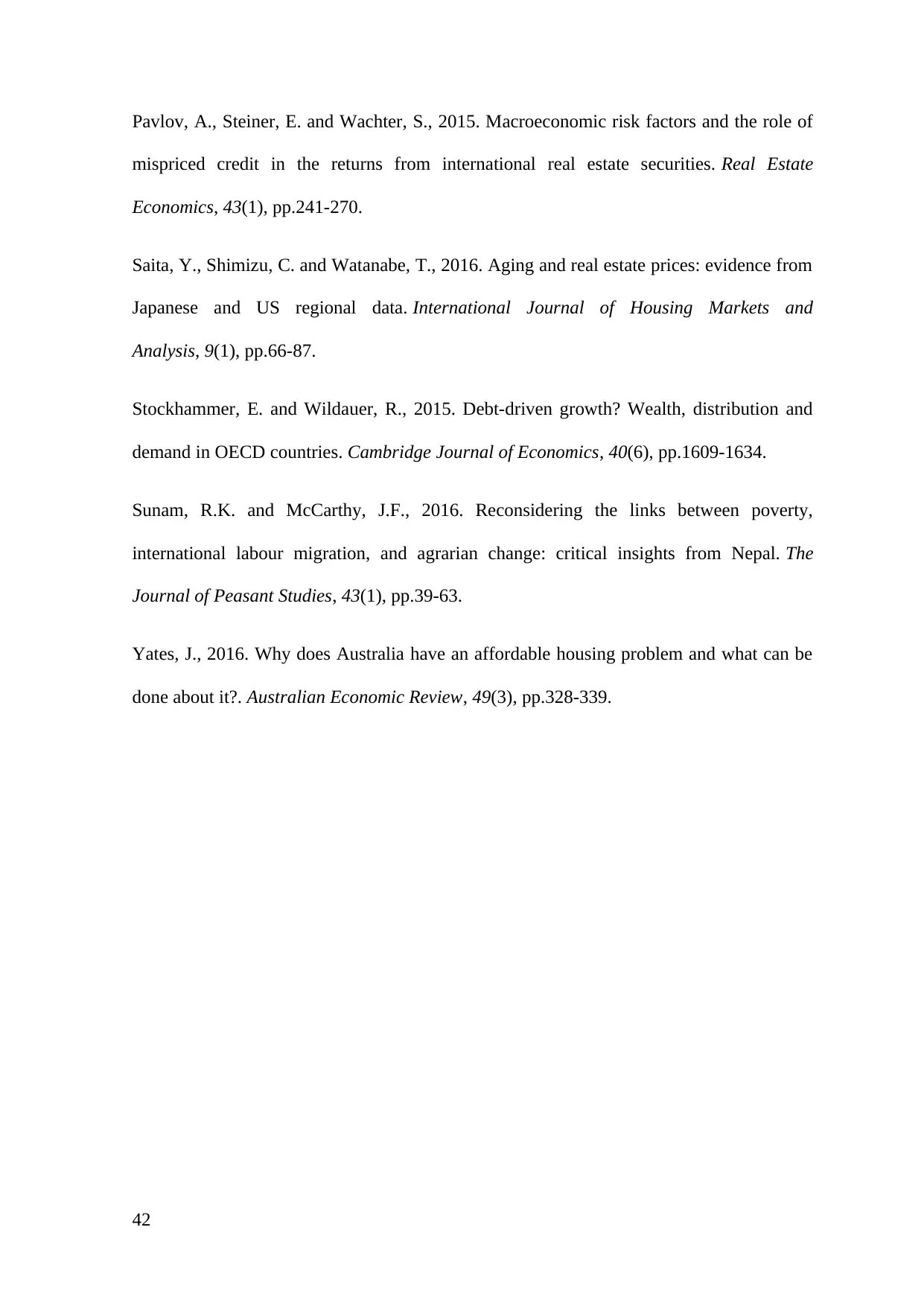
Pavlov, A., Steiner, E. and Wachter, S., 2015. Macroeconomic risk factors and the role of
mispriced credit in the returns from international real estate securities. Real Estate
Economics, 43(1), pp.241-270.
Saita, Y., Shimizu, C. and Watanabe, T., 2016. Aging and real estate prices: evidence from
Japanese and US regional data. International Journal of Housing Markets and
Analysis, 9(1), pp.66-87.
Stockhammer, E. and Wildauer, R., 2015. Debt-driven growth? Wealth, distribution and
demand in OECD countries. Cambridge Journal of Economics, 40(6), pp.1609-1634.
Sunam, R.K. and McCarthy, J.F., 2016. Reconsidering the links between poverty,
international labour migration, and agrarian change: critical insights from Nepal. The
Journal of Peasant Studies, 43(1), pp.39-63.
Yates, J., 2016. Why does Australia have an affordable housing problem and what can be
done about it?. Australian Economic Review, 49(3), pp.328-339.
42
mispriced credit in the returns from international real estate securities. Real Estate
Economics, 43(1), pp.241-270.
Saita, Y., Shimizu, C. and Watanabe, T., 2016. Aging and real estate prices: evidence from
Japanese and US regional data. International Journal of Housing Markets and
Analysis, 9(1), pp.66-87.
Stockhammer, E. and Wildauer, R., 2015. Debt-driven growth? Wealth, distribution and
demand in OECD countries. Cambridge Journal of Economics, 40(6), pp.1609-1634.
Sunam, R.K. and McCarthy, J.F., 2016. Reconsidering the links between poverty,
international labour migration, and agrarian change: critical insights from Nepal. The
Journal of Peasant Studies, 43(1), pp.39-63.
Yates, J., 2016. Why does Australia have an affordable housing problem and what can be
done about it?. Australian Economic Review, 49(3), pp.328-339.
42
1 out of 43
Related Documents
Your All-in-One AI-Powered Toolkit for Academic Success.
+13062052269
info@desklib.com
Available 24*7 on WhatsApp / Email
![[object Object]](/_next/static/media/star-bottom.7253800d.svg)
Unlock your academic potential
© 2024 | Zucol Services PVT LTD | All rights reserved.





![[FULL ACCESS] Environmental Management Practices and Business Performance](/_next/image/?url=https%3A%2F%2Fdesklib.com%2Fmedia%2Fimages%2Fom%2F2b49c5db9a874304b6973b0ef4462d85.jpg&w=256&q=75)